CURRAHEE FLOWERS — SEPTEMBER
9/27/20, updated 10/3/20
Just as in Athens, the trail up Currahee Mountain is covered with yellow flowers. What surprised me, though, was the amazing diversity, as well as the number of less obvious flowers that are not white.
These are sorted by color, flower structure, and growth form, to put similar flowers and plants together.
Yellow flowers
Several types of goldenrod occur on Currahee, and all are common.
Gray Goldenrod (Solidago nemoralis). This goldenrod is about 2–3' tall, with a smooth reddish-brown stem. The lower stem has long (5–7 cm), narrow, and slightly toothed opposite leaves, each with a few tiny leaves where it attaches to the stem. Distinctively, the leaves get much smaller (less than 1 cm) near the top of the stem, but still bear the tiny leaves where they attach (the axils). The plant ends in a pyramid of tiny, densely packed, yellow flowers.
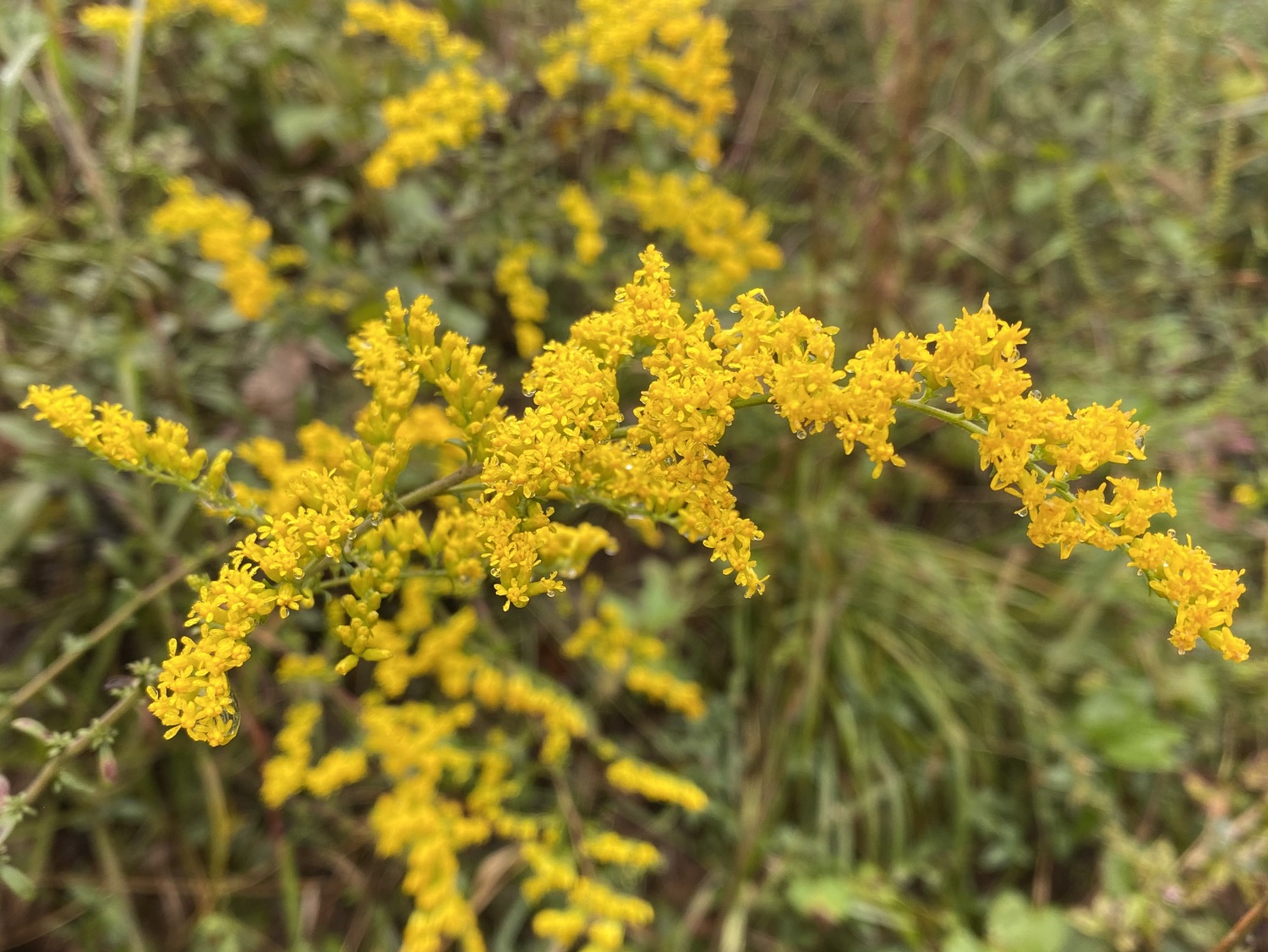


Wreath Goldenrod (Solidago curtisii). The pyramid of small yellow flowers at the top, the single stem and the alternate elongate leaves decreasing upward in size (5–6 cm at base, 2 cm at top) mark this a goldenrod. The stem is bright yellowish-green. The entire plant is 3–4' tall. I am not completely sure about the identification on this as the leaves look much narrower than in any of the field guides, and there are many Solidago species in Georgia.
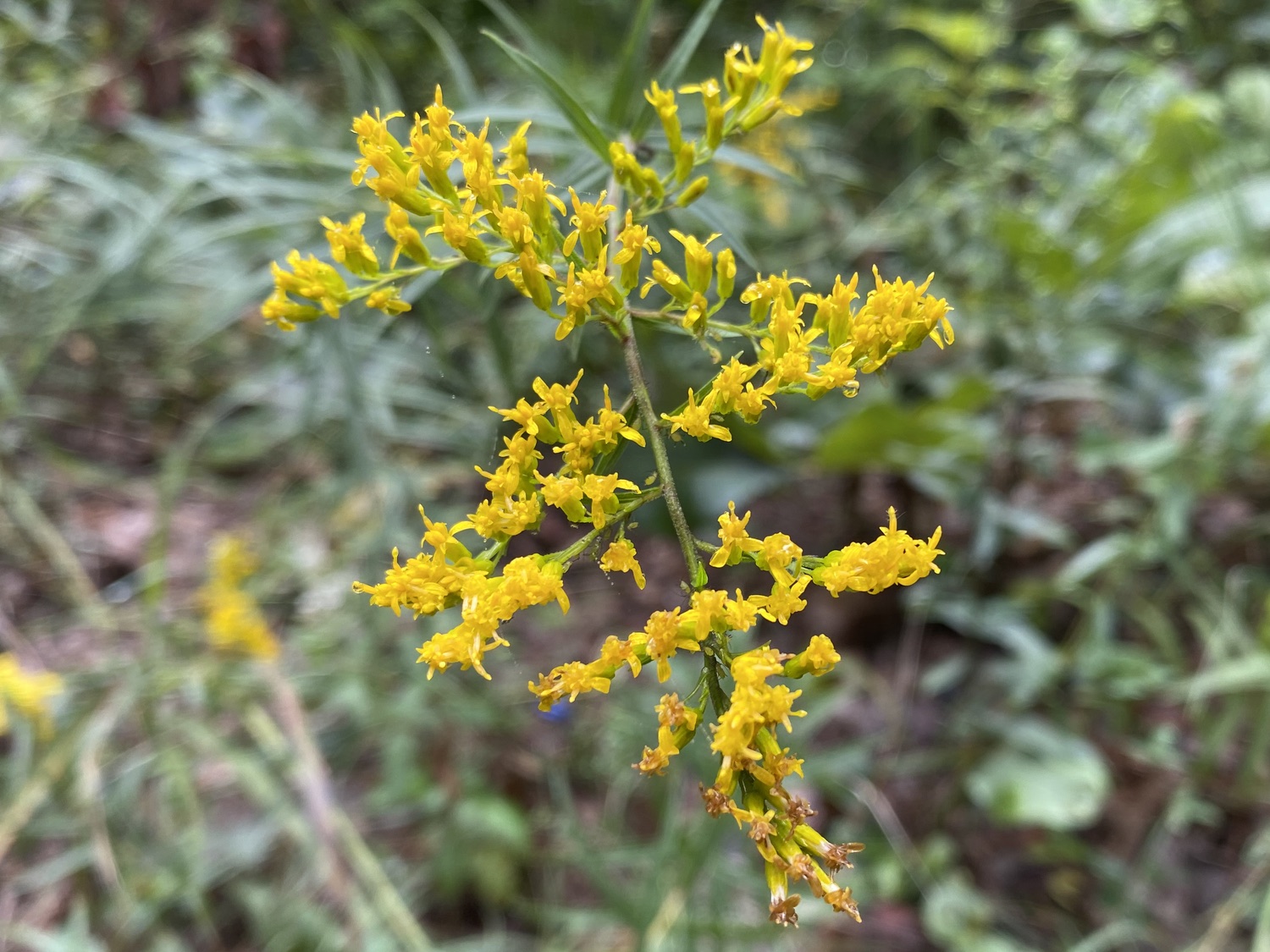
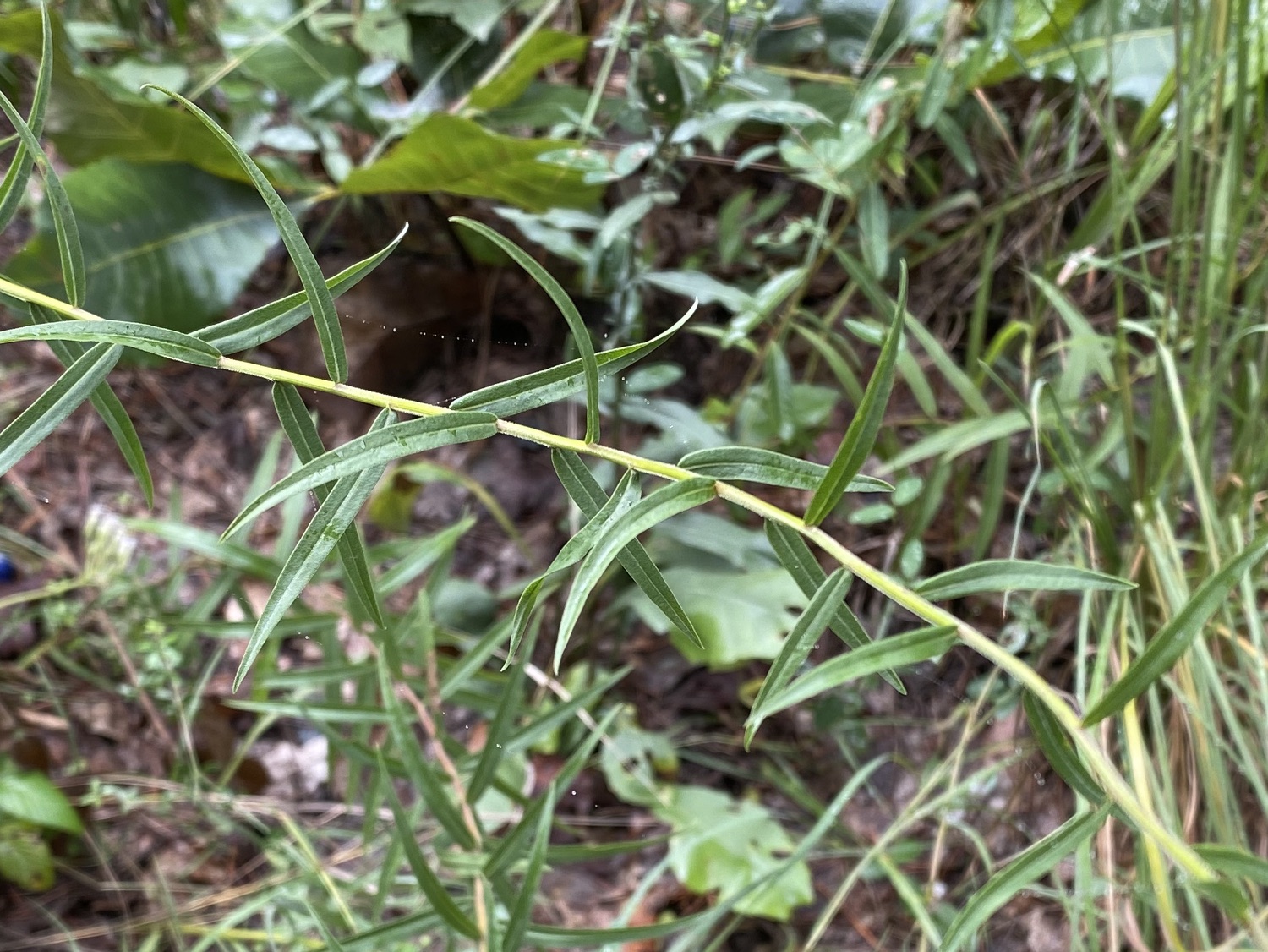
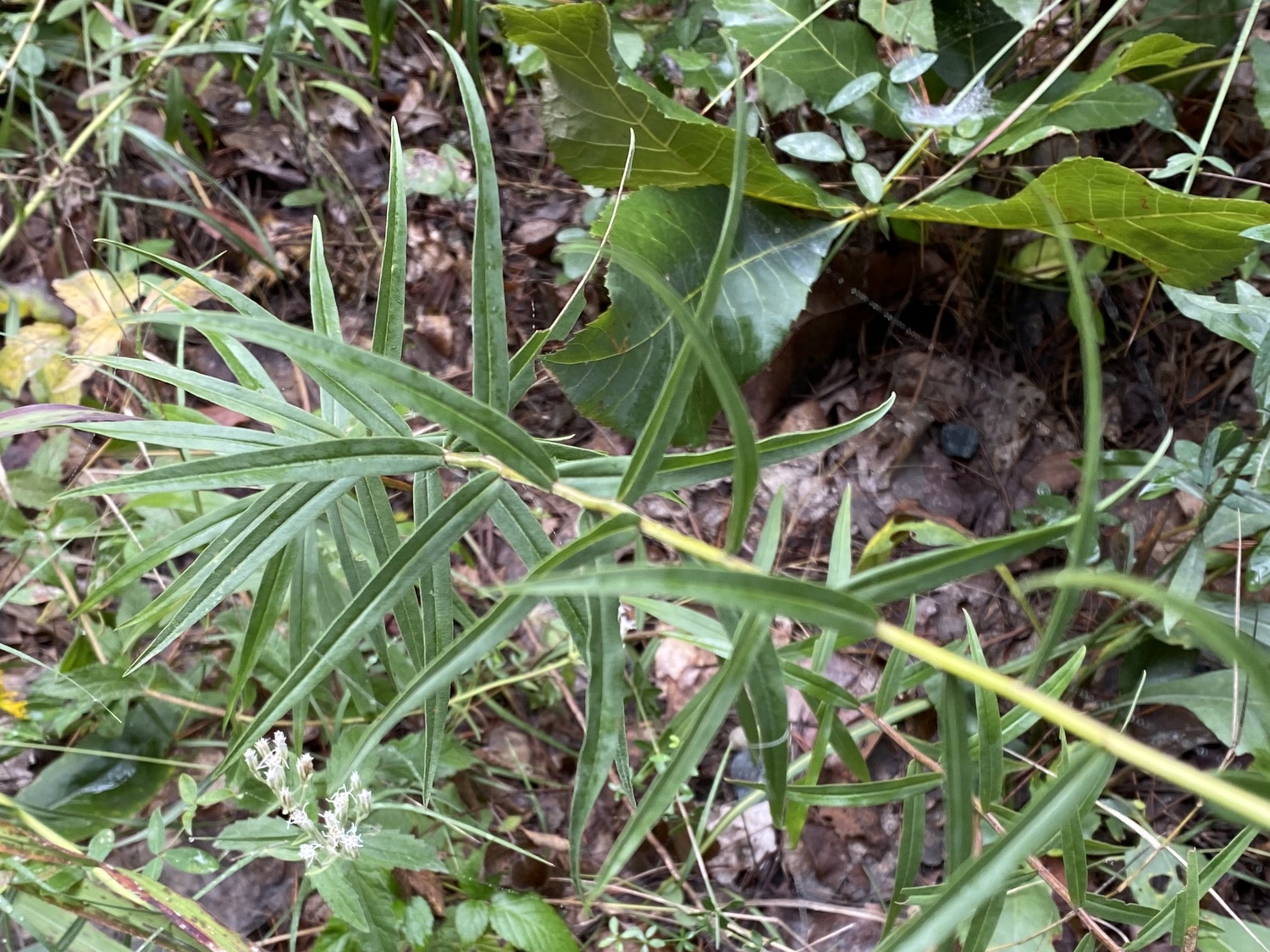
Tall Goldenrod (Solidago altissima). This goldenrod has a pyramid-shaped cluster of small yellow flowers at the end of its single stem. The leaves are stemless, lanceolate, relatively wide, and have either entire margins or are slightly toothed. These plants are 2–4' tall..

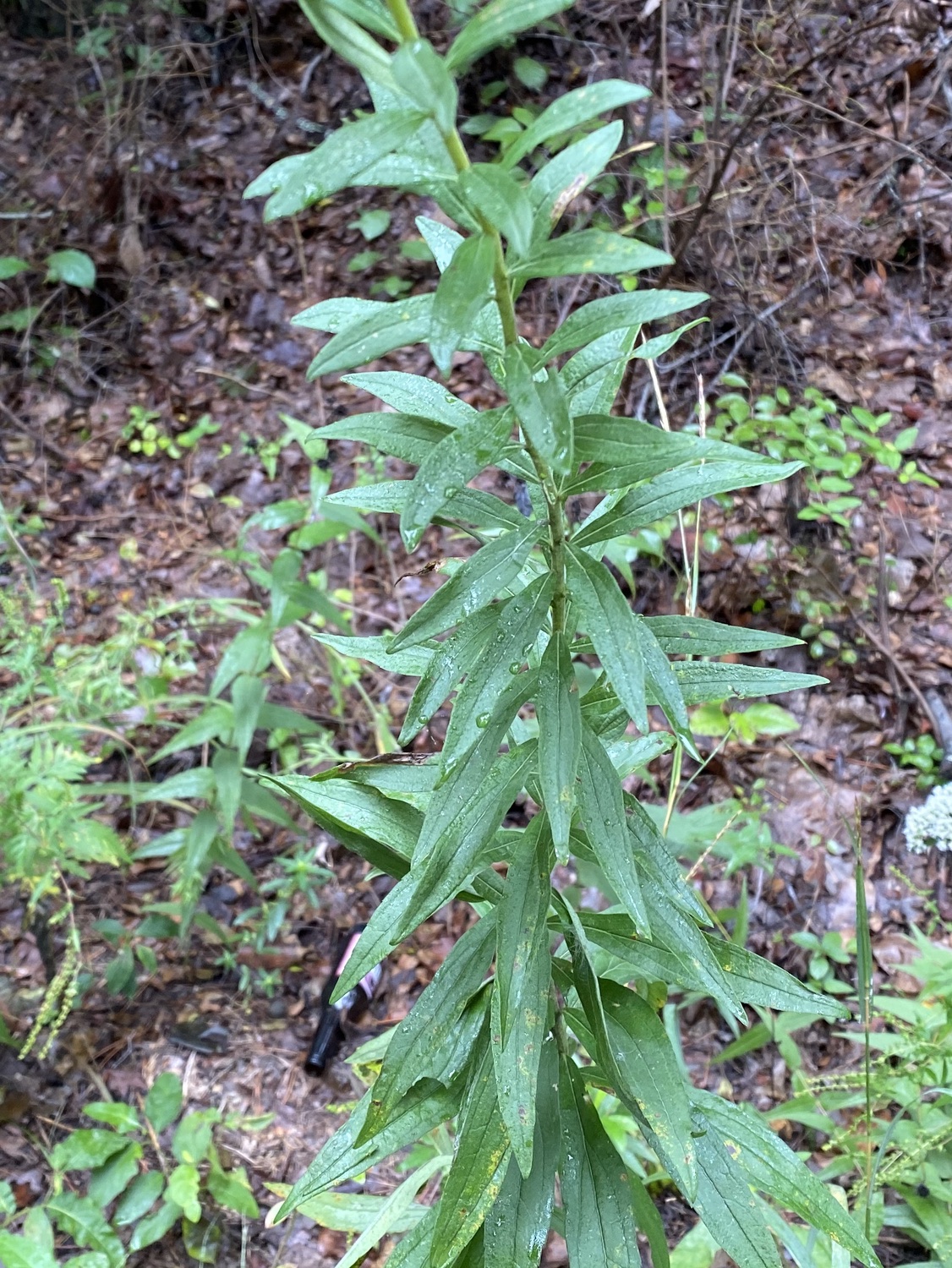
Hairy Goldenrod (Solidago hispida). This is a goldenrod —, but it differs from the others in that the plant terminates with a series of small yellow flowers along a single stalk, rather than a pyramid of flowers. The stem is purplish-brown and hairy. It has alternate pointed elliptical leaves on short stems; the leaves have deeply impressed veins on the top. The leaves get progressively smaller towards the top of the plant (5–6 cm near base, less than 1 cm near the top), and buds appear in the axils of the leaves. The stem ends in a cluster of yellow flowers, all branching off the main stem. The flowers have golden-yellow petals and stamens, and the flowers seem larger than on most other goldenrods. Overlapping green bracts form a cylinder under each flower. The plant is about 3' tall.
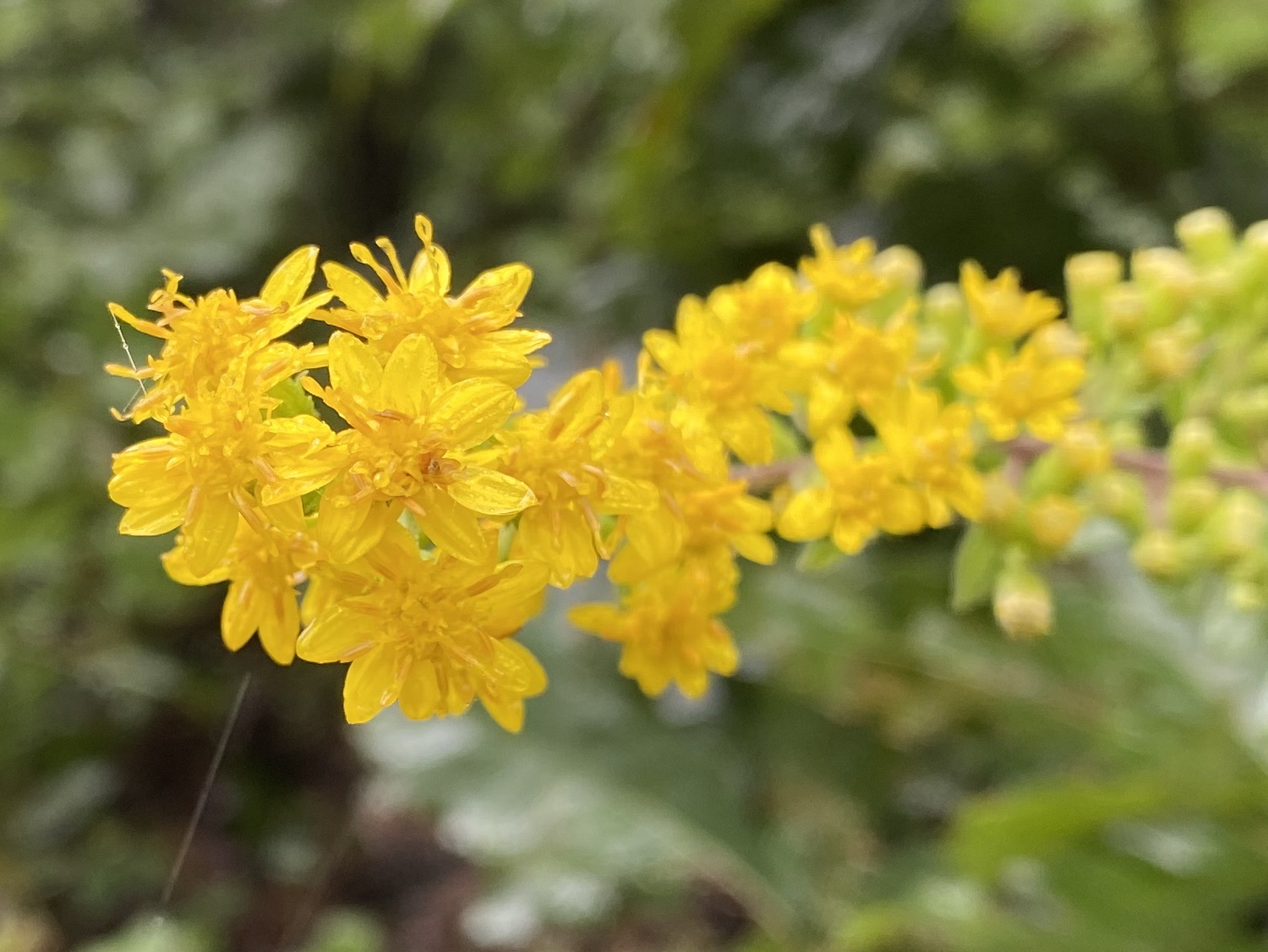

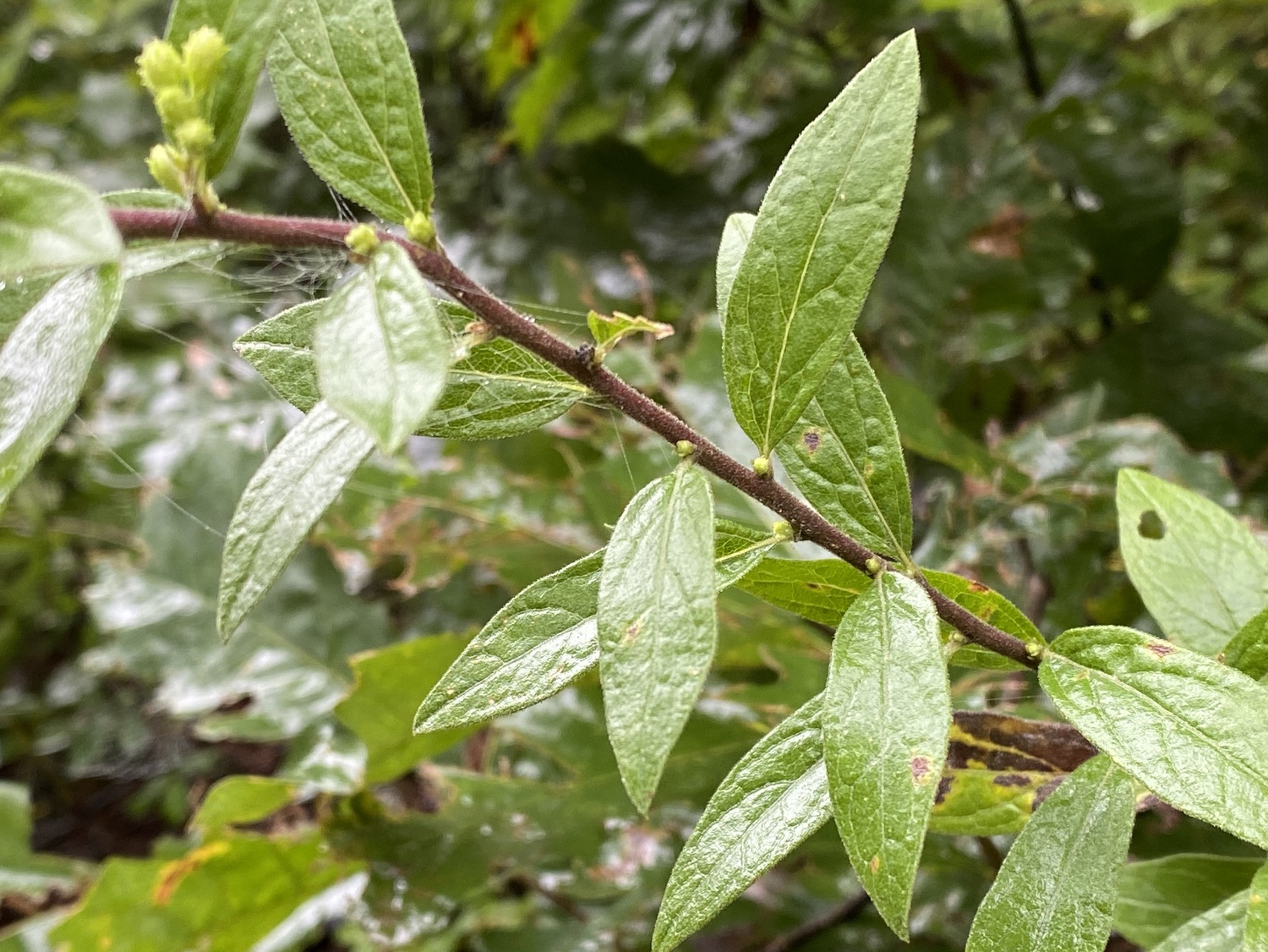
Smooth False-Foxglove (Aureolaria flava, also called Smooth Oak-leech). This false-foxglove grows as a single stem that is brown, smooth, and waxy. The leaves at the base are deeply lobed, almost like an oak leaf, but the opposite leaves near the top have short stalks and are lanceolate, with small buds emerging from the axils. The flowers begin as solid yellow lumps, then open into a tube with five spreading lobes. These are common on Currahee, often about 3–4" tall, but some reach 7–8", and those usually have fallen over.
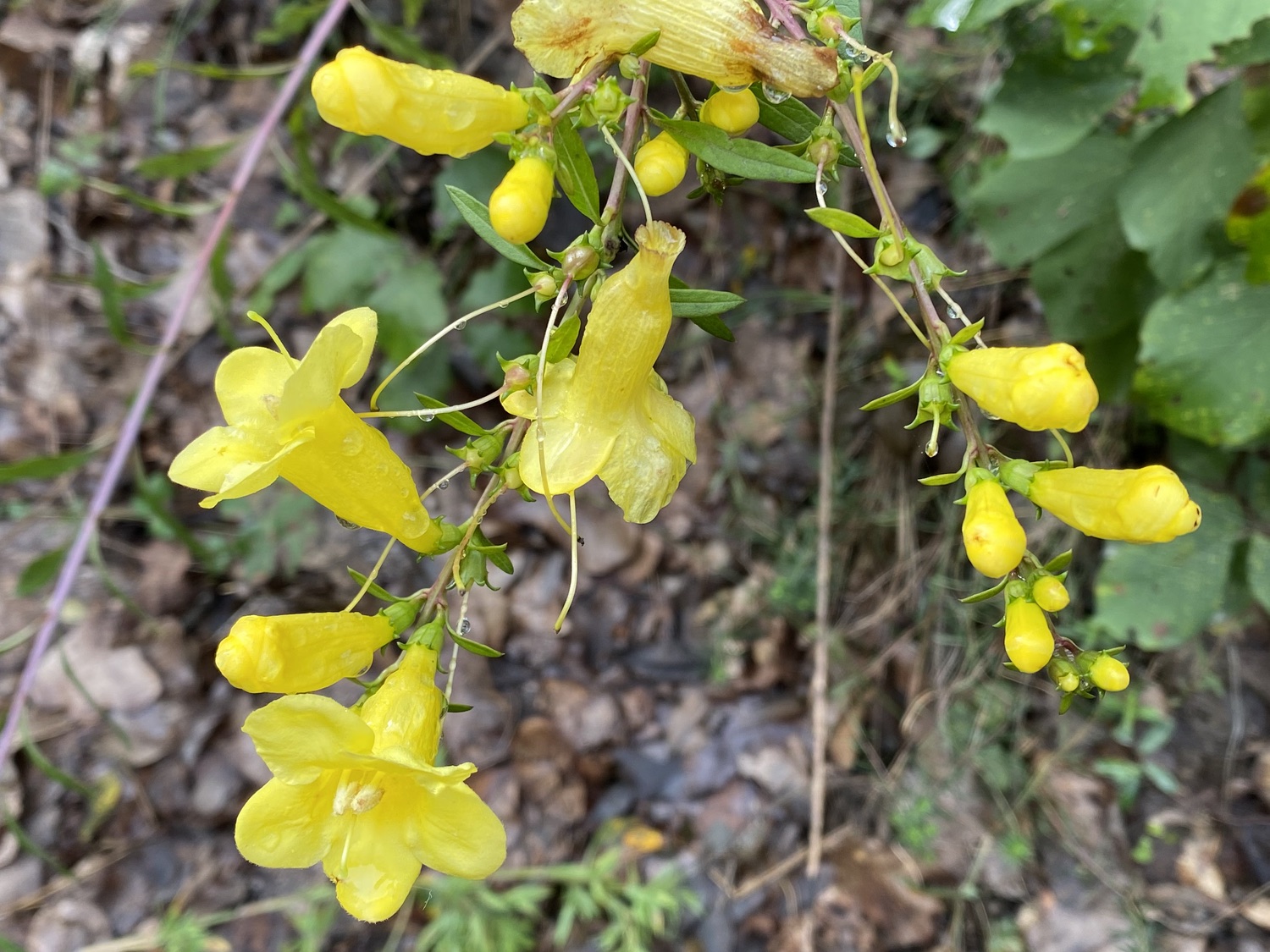


Yellow Crownbeard (Verbesina occidentalis, also called Southern Crownbeard). These plants can be over 6' tall, but often droop under the weight of the flowers. The compound flowers consist of 3–4 yellow grooved ray petals and about a dozen smaller yellow flowers in a central disk. The lack of ray flowers and their irregular spacing often makes it look like the petals have been removed. The stems are winged, and the opposite leaves are wide, triangular, and toothed.
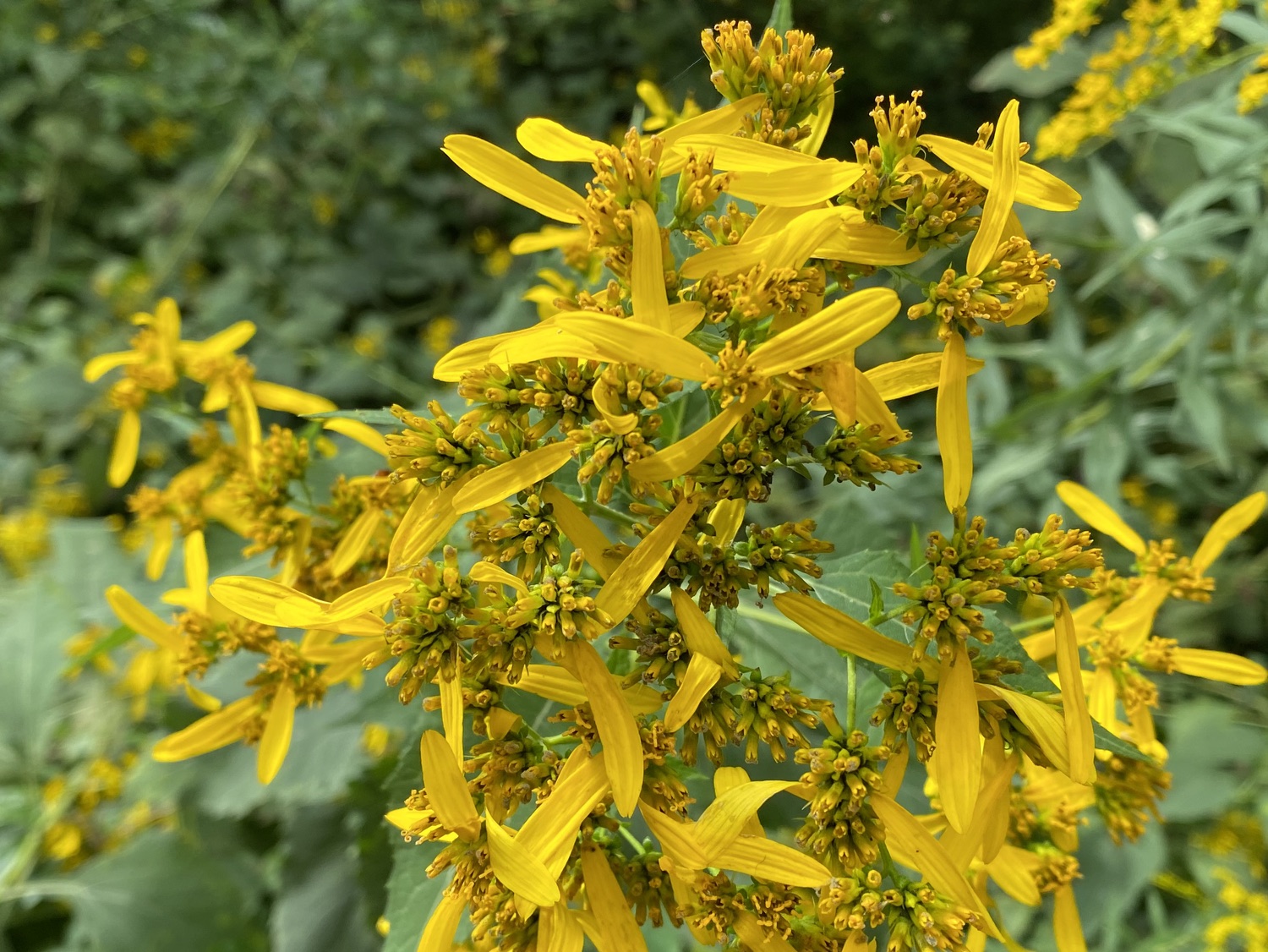
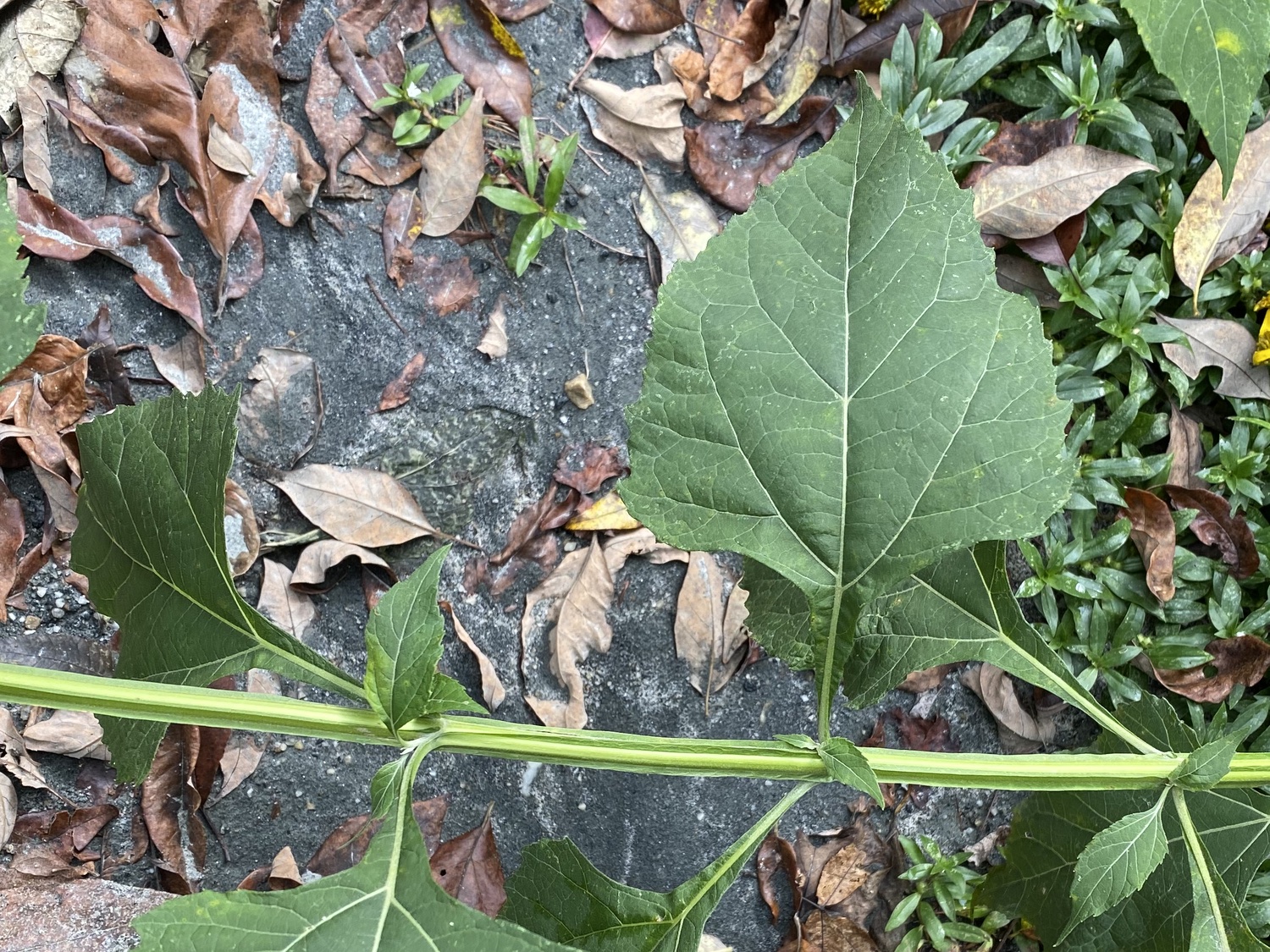
Kidney-leaf Rosinweed (Silphium compositum). The compound flowers of this species normally have 6–12 yellow ray flowers, but I think the flowers along the road are past their prime, and many have turned black. The central disk has several flowers which appear to have long black-tipped anthers. The stem is waxy reddish-brown, and the upper part of the plant lacks leaves or having sparse alternate elliptical toothed leaves. The leaves at the base are deeply lobed with a red midvein, and these are the unmistakable feature of this species.

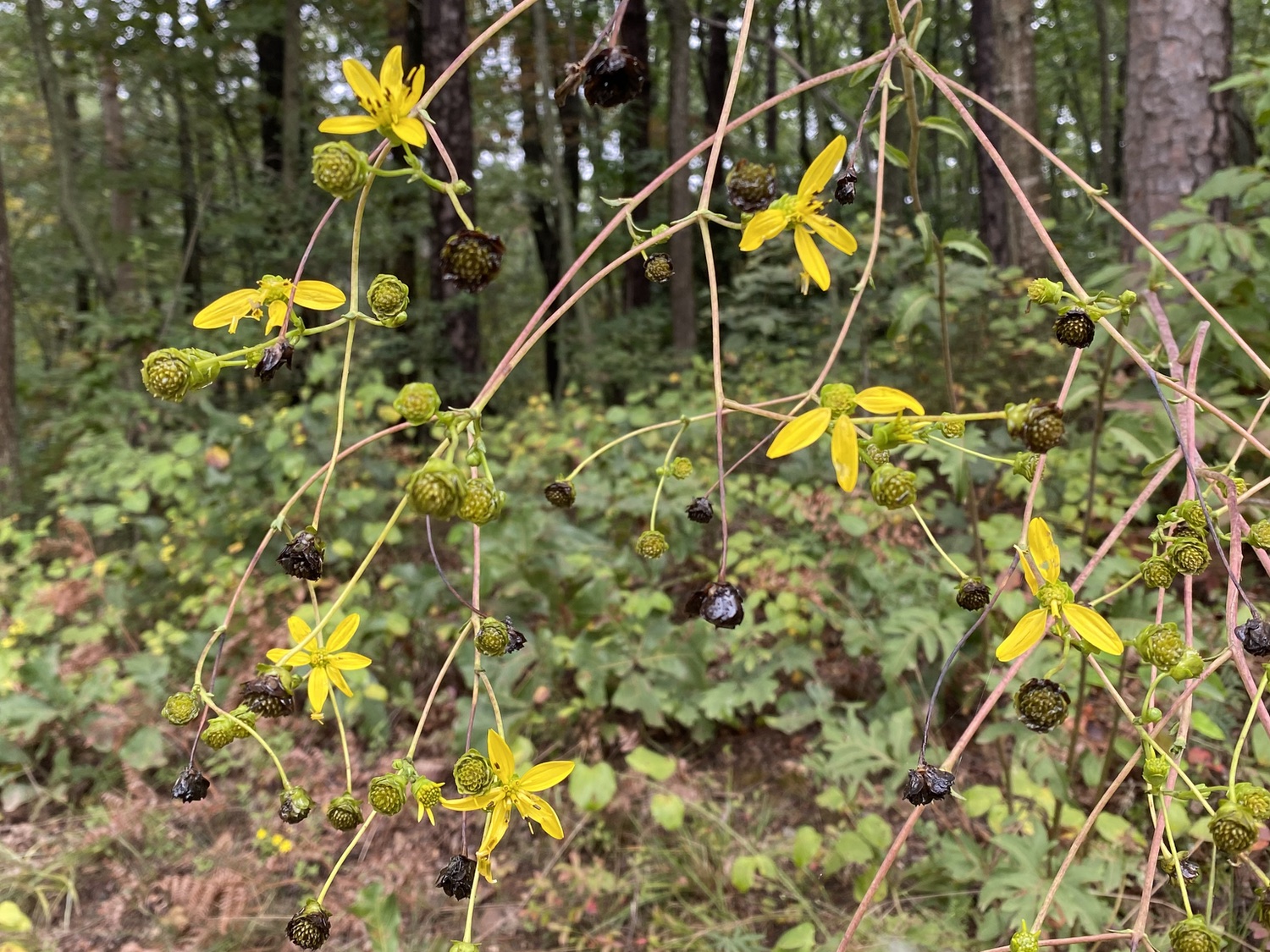
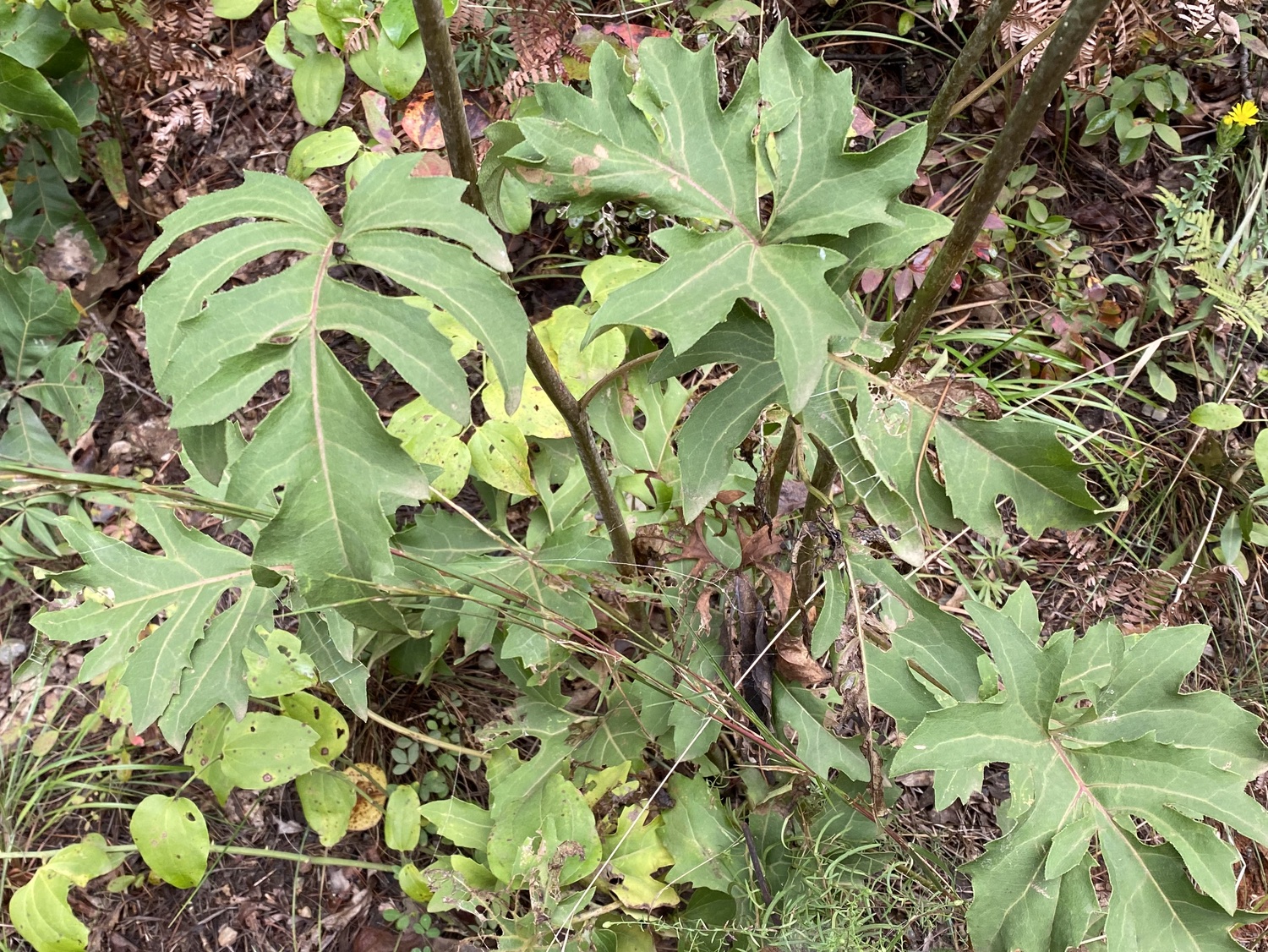
Grass-leaved Golden-aster (Pityopsis graminifolia). I saw only one of these in our neighborhood, but these are common on Currahee. The plant is 1–2' high, with a cluster of grassy leaves a the base, and short (2–3 cm) alternating leave up the stem. Each of those leaves curls tightly around the stem and stays close to the stem, instead of projecting from it. The compound flowers have7–8 lemony yellow ray flowers with a couple dozen yellow flowers in the central disk. The green bracts around the base form a cylinder.
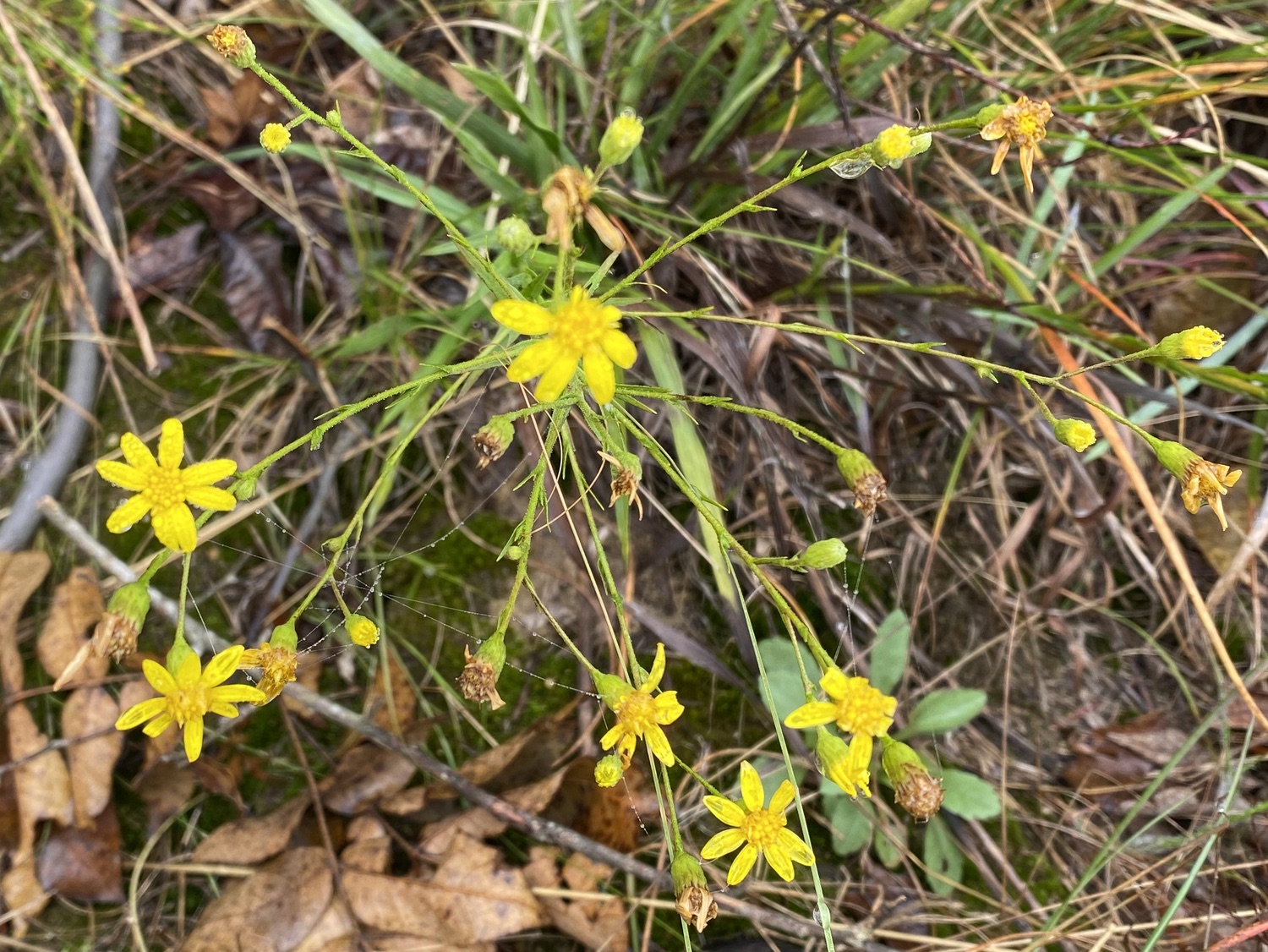
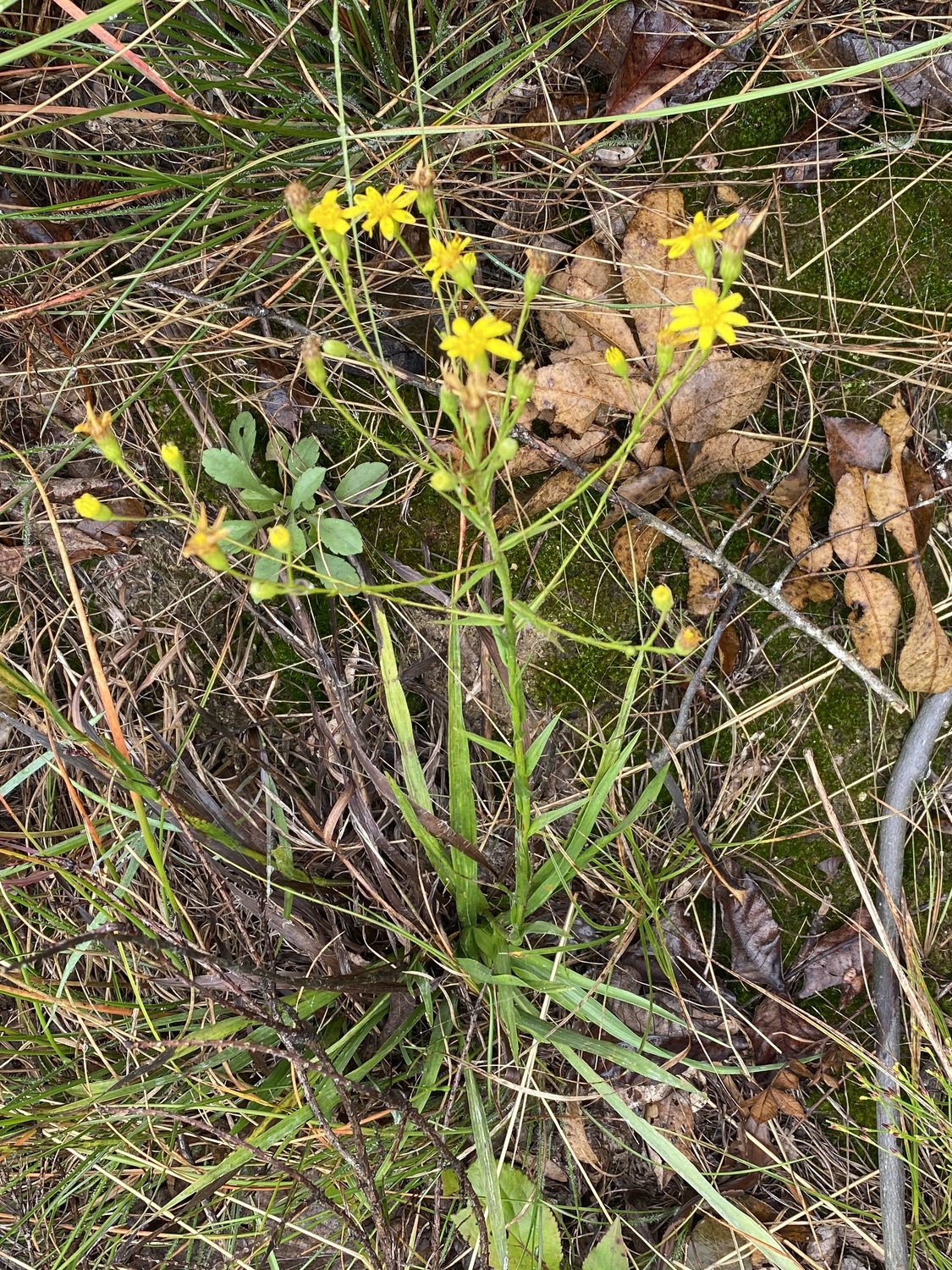
Golden-aster? (?Pityopsis sp.). This looks a lot like the Grass-leaved Golden-Aster, but the leaves along the stem are 6–7 cm long, and there is a few longer (15–20 cm) grassy leaves at the base. The flower is compound, with 10 lemony yellow ray flowers, and what looks to be about 10 flowers in the central disk. Green bracts form a cylinder at the base of the flower. The plants are about 1–2' tall, and the stems and leaves are covered with long white hairs. It is possible that this is also the Grass-leaved Golden-aster, which was growing only a few feet away, but the larger leaves seem quite different. It is also possible that one or both of these is the Sticky Golden-Aster (Pityopsis aspera, also called Pineland Silk-Grass)
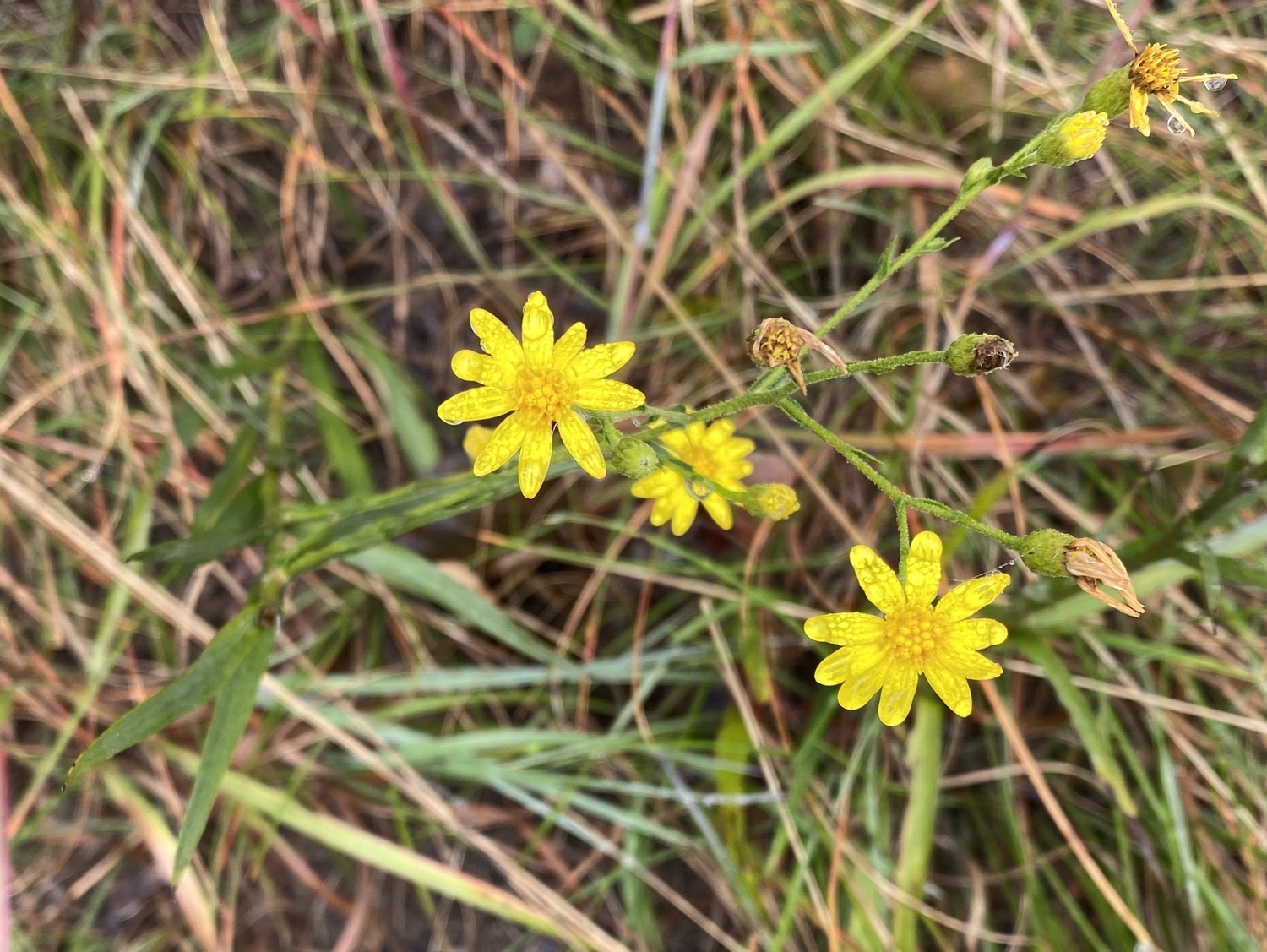
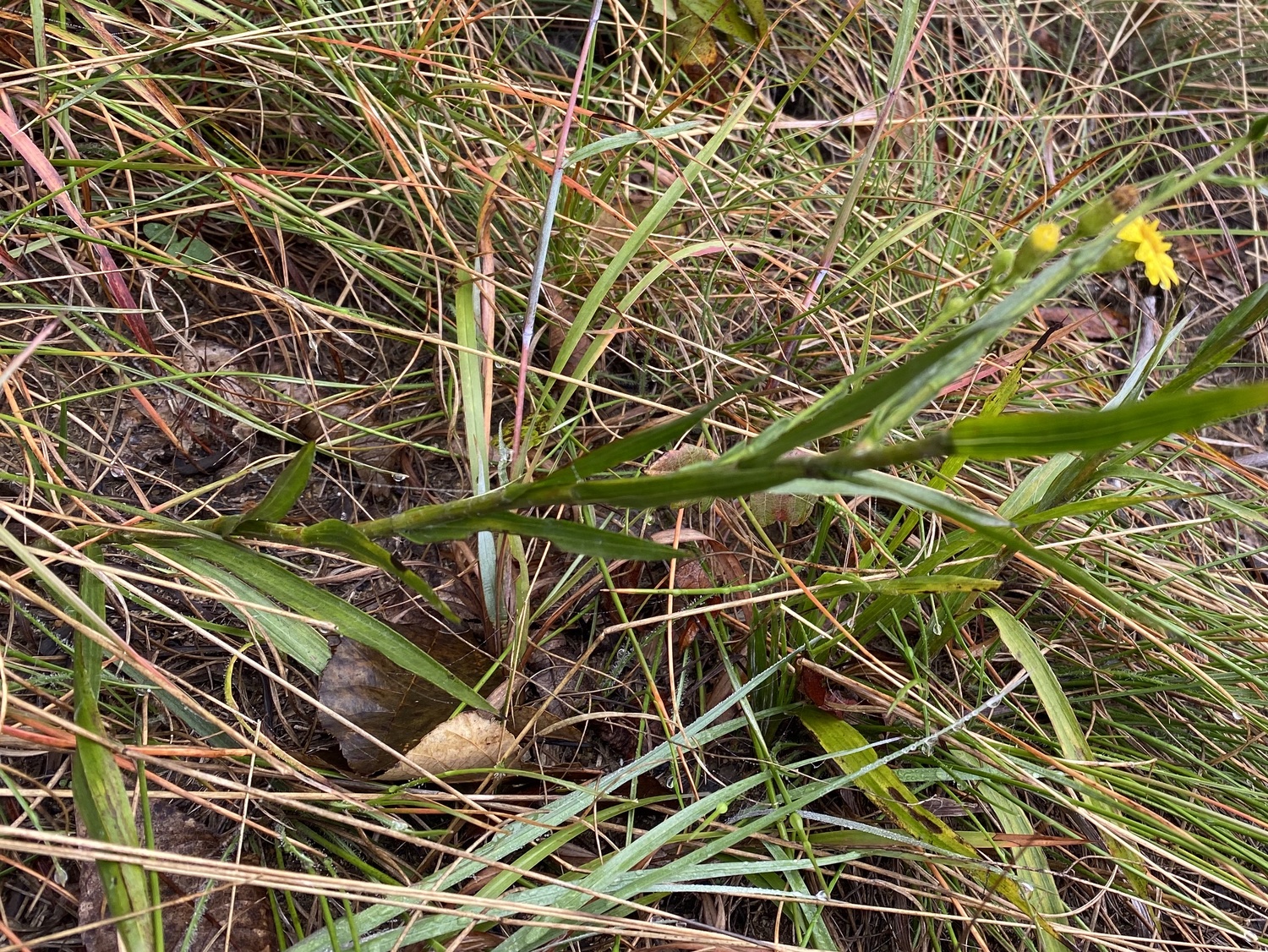
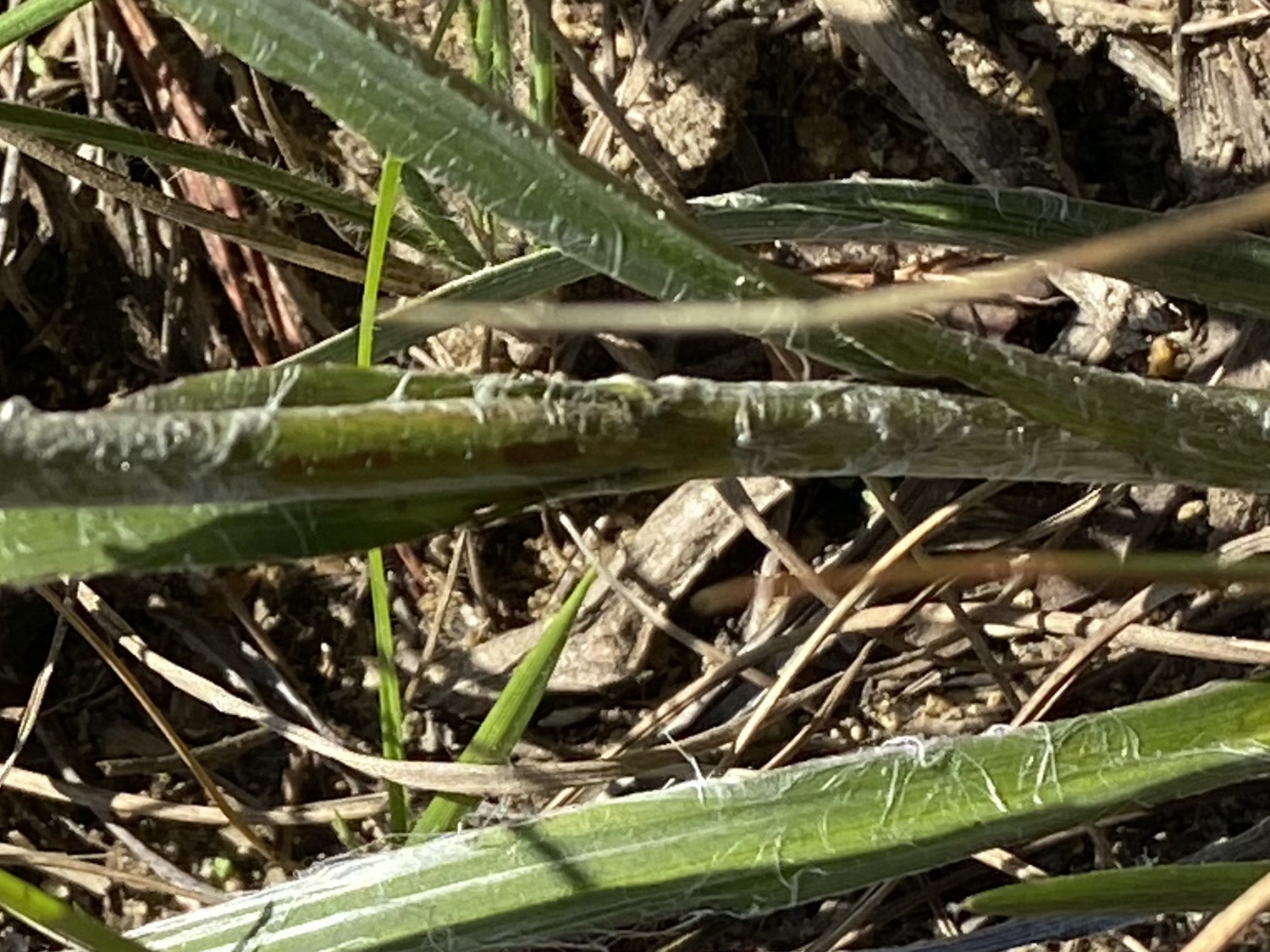
Common Evening-Primrose (Oenothera biennis). These have rich yellow flowers, with four heart-shaped petals, long yellow stamens, and a cross-shaped yellow stigma. Underneath the flowers are four sepals that fold backward along the stem. The main stem is red and hairy, with alternate short, stalked, lanceolate leaves. The entire plant is about 3' tall, but they commonly fall over with the weight of flowers. Older flowers turn to a pale salmon–orange.
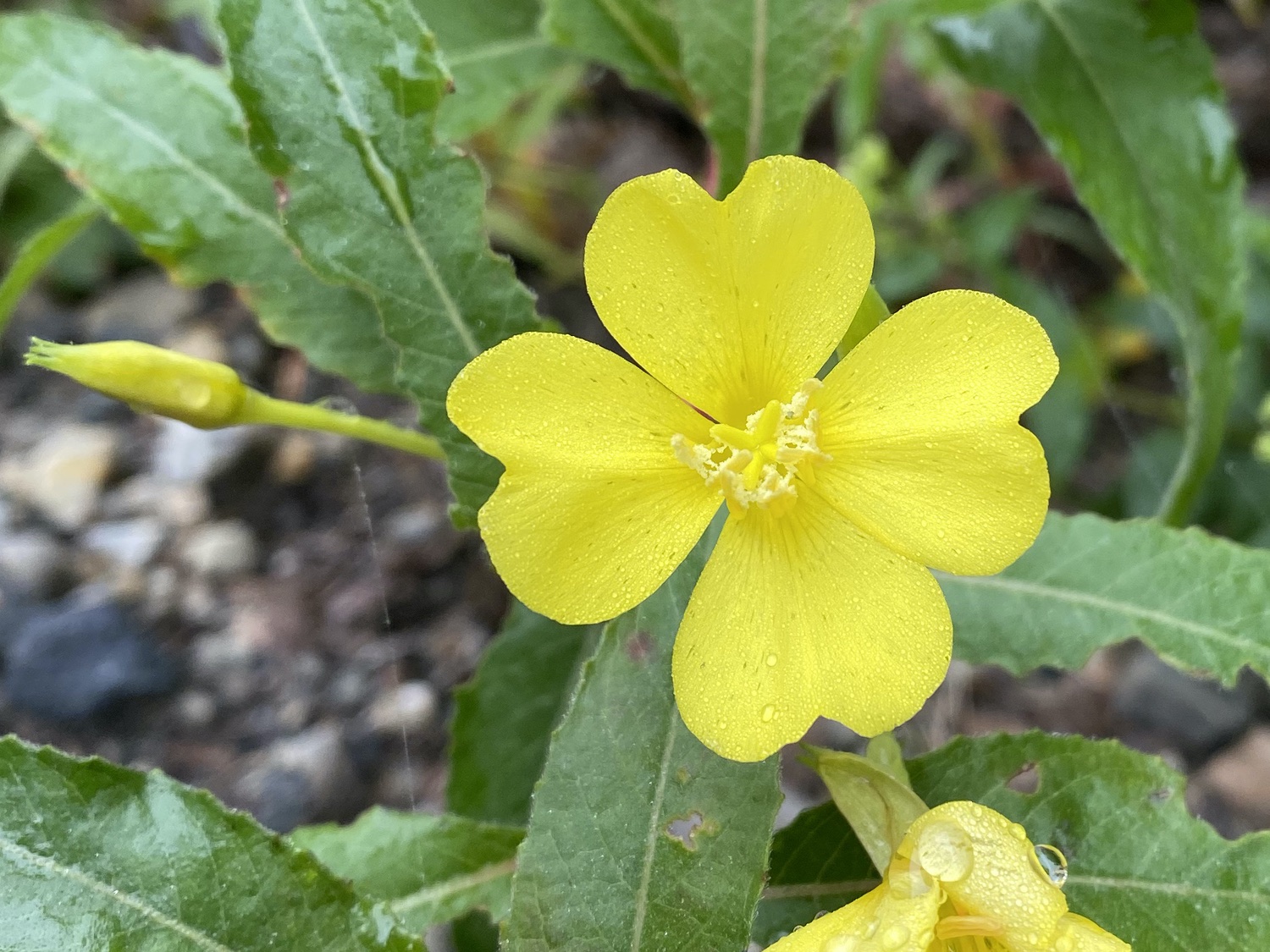

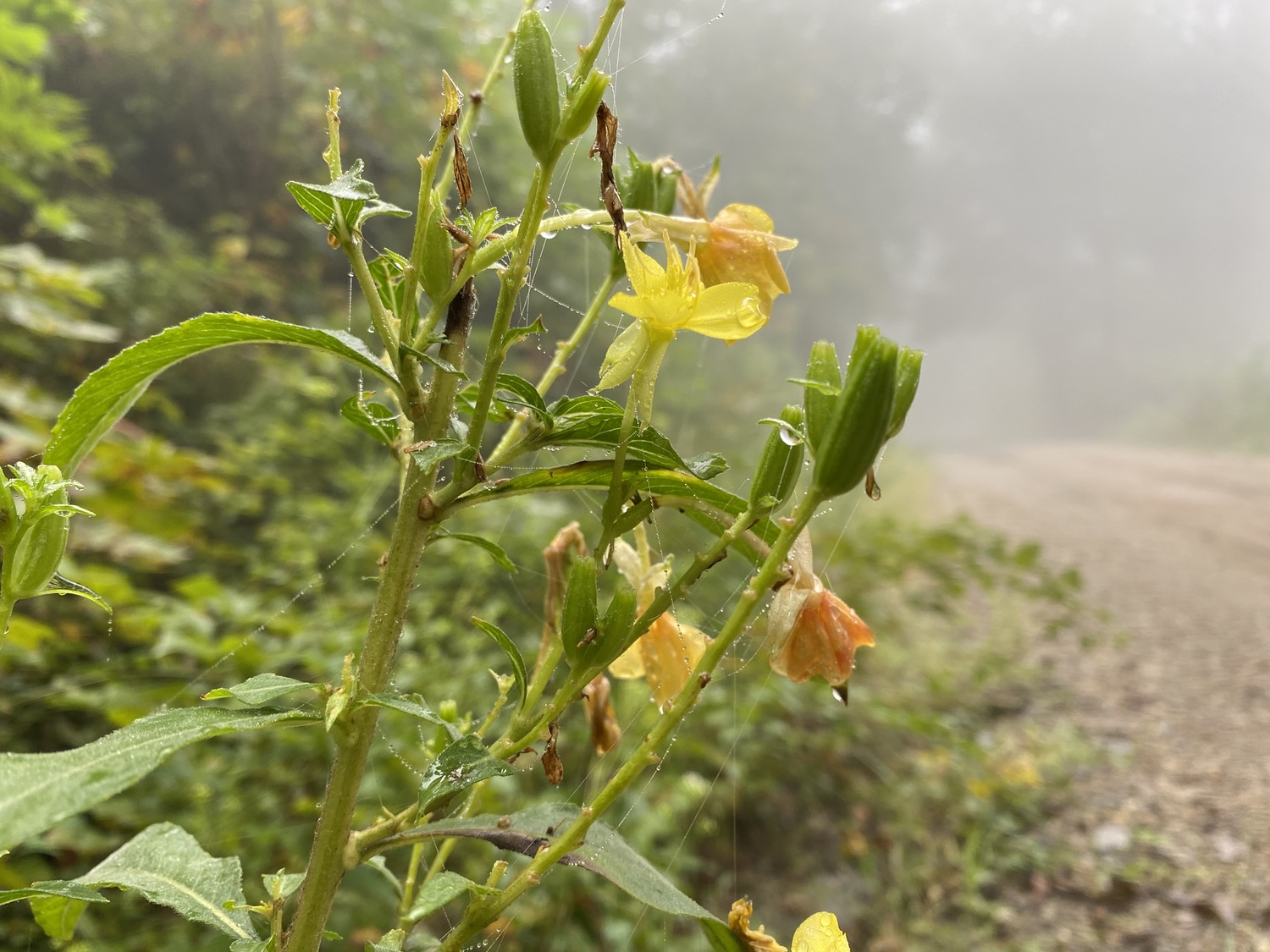
Woodland Coreopsis (Coreopsis major, also called Greater Tickseed and Greater Coreopsis). These beautiful compound flowers are 2–3 cm across, with 8 yellow ray flowers, with well-defined veins or grooves along their length. The central disk is a cluster of yellow flowers ringed by 8 dark-centered flowers. The upper leaves are opposite and elongate, and those near the base may have three leaflets, making it look like a whorl of 6 leaves. All of the leaves have entire margins. The stem is green.
The lower three photographs are from another plant from 3 October, which has rounder-tipped petals and wider leaves. The leaves are in pairs, with three deeply lobes on each leaf, making it look like 6 leaves in a whorl, as in C. major. I didn’t get a photograph of the bracts on the plant in the upper pair of photos, but bracts on the lower plant are long, blunt tipped, and splayed from the calyx, and they are rather different from the rounded leaf-like bracts of C. major major. There are many species of Coreopsis in Georgia, and it is unclear to me right now whether this is just intra-species variation or if these are different species. The difference in the leaves and the petals makes me think they might be different species.
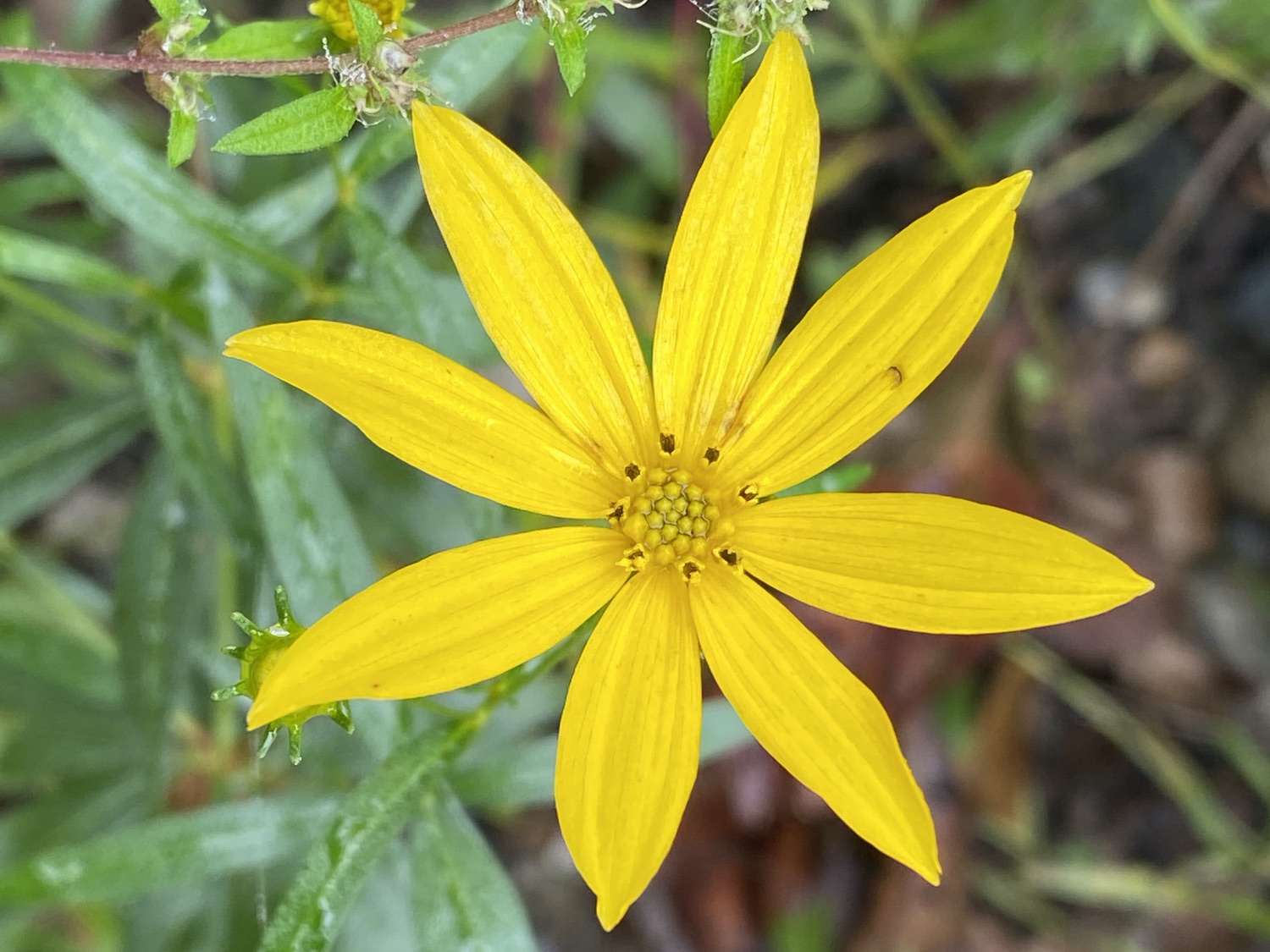
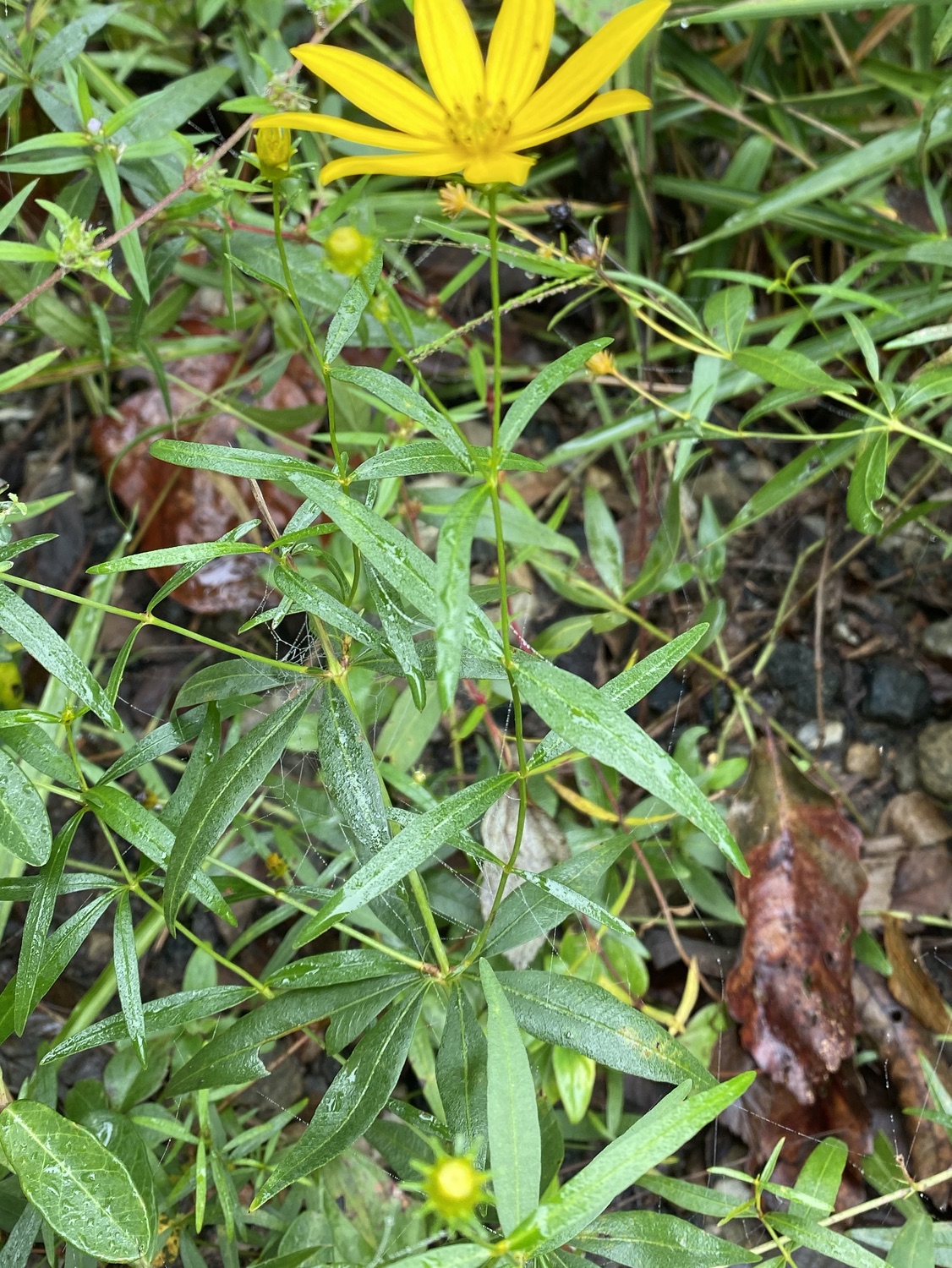
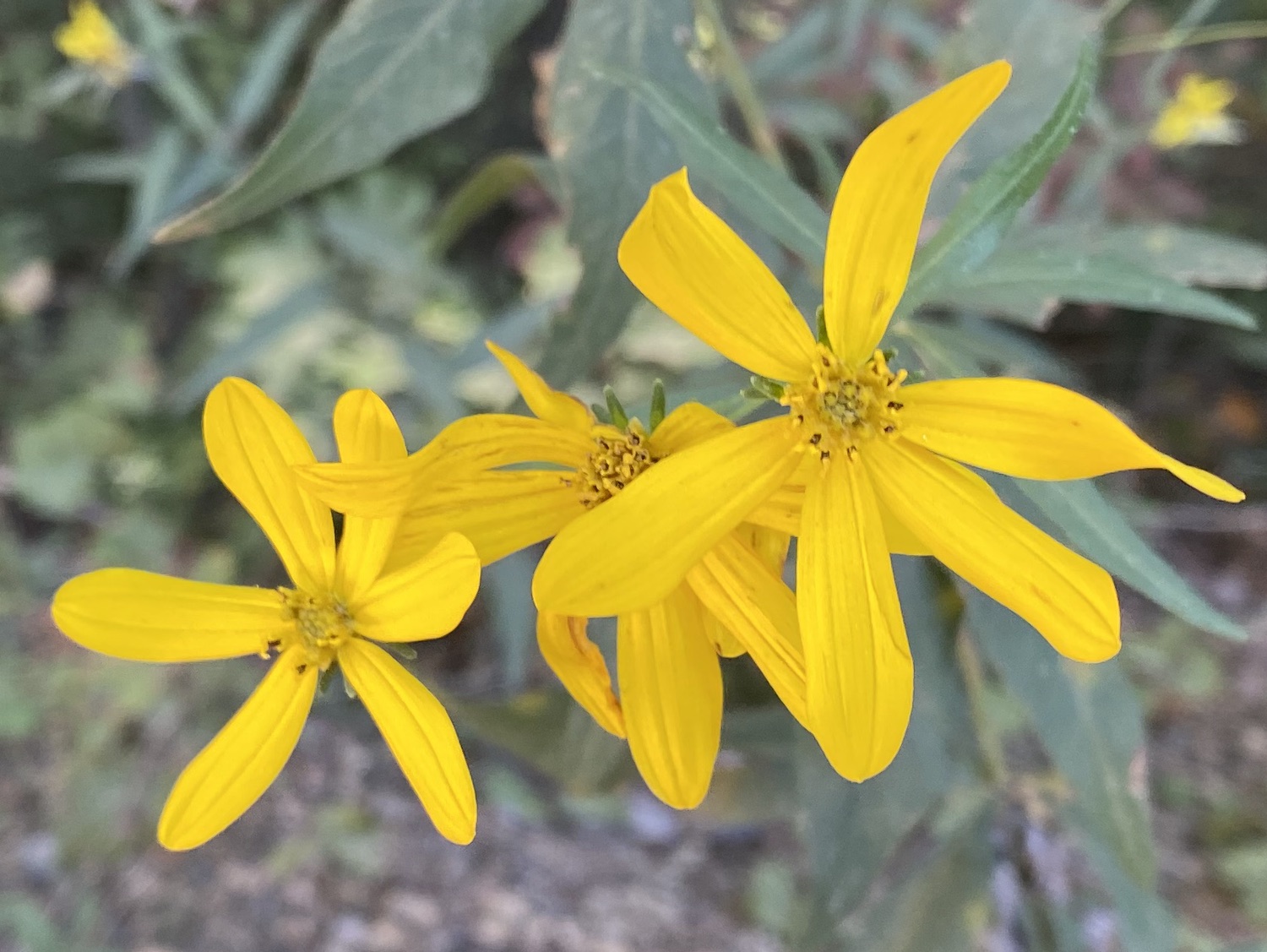
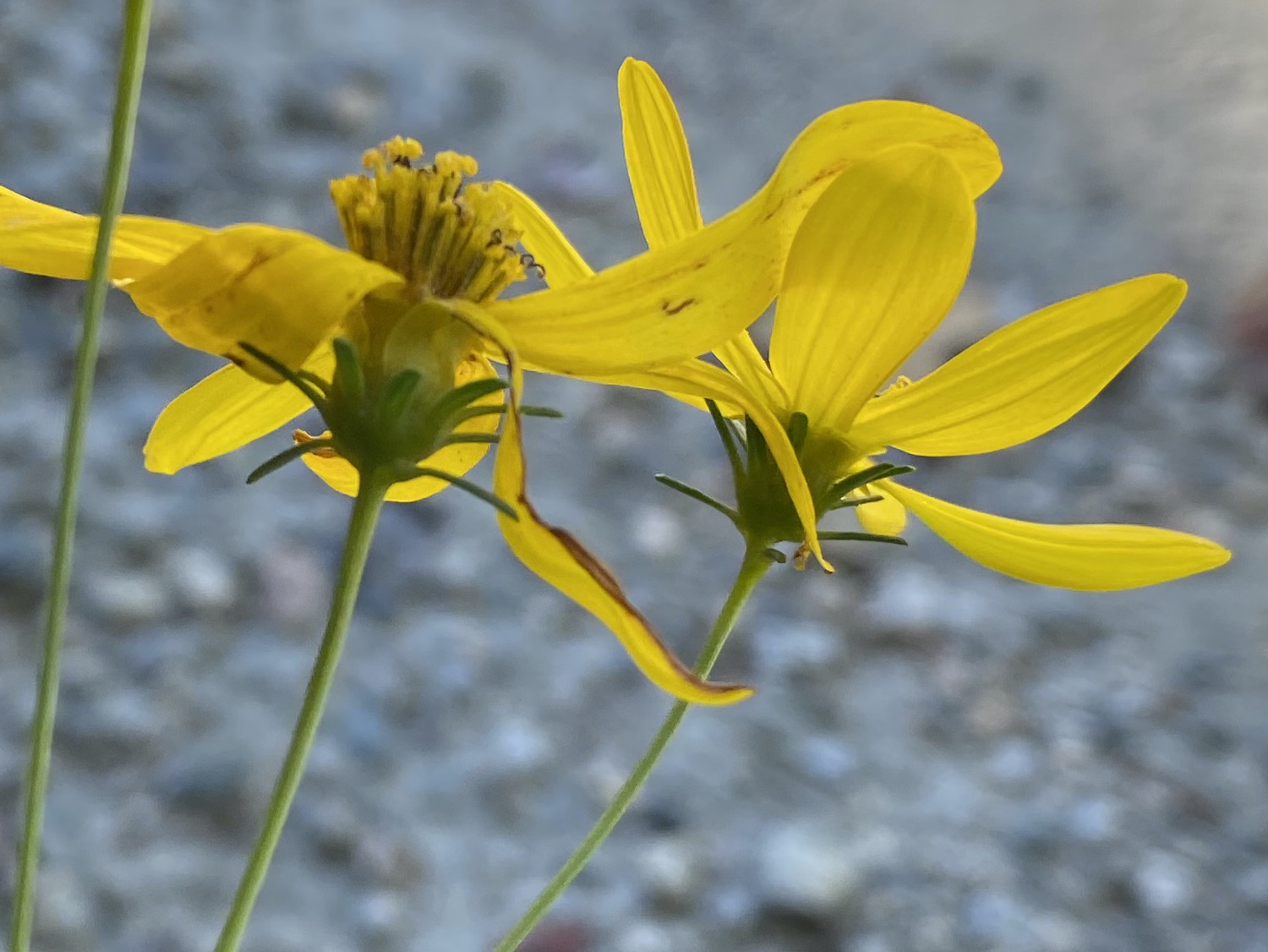

Tall Coreopsis (Coreopsis tripteris, also called Tall Tickseed). Most of these plants are about 3" tall, and some are as tall as 5". The stems are waxy reddish-brown. The compound flowers have 8 toothed ray flowers with parallel veins or grooves. The central disk flowers are yellow with black anthers. The opposite pointed elliptical leaves along the upper parts of the stem are similar to the Woodland Coreopsis, but they are on short stalks. I unfortunately didn’t get a look at the lower leaves, which should have had three elongate leaflets per leaf, if this is C. tripteris.
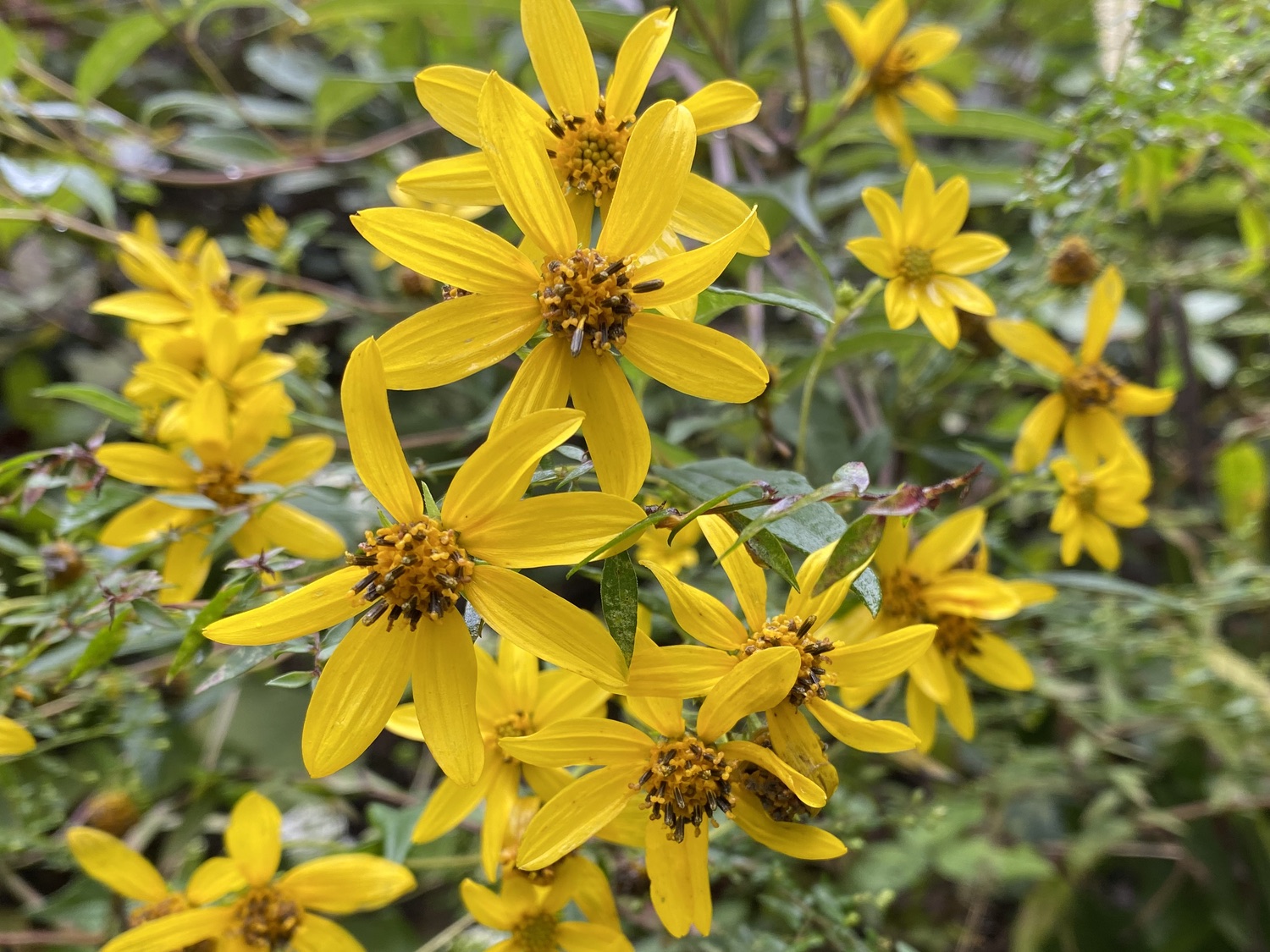
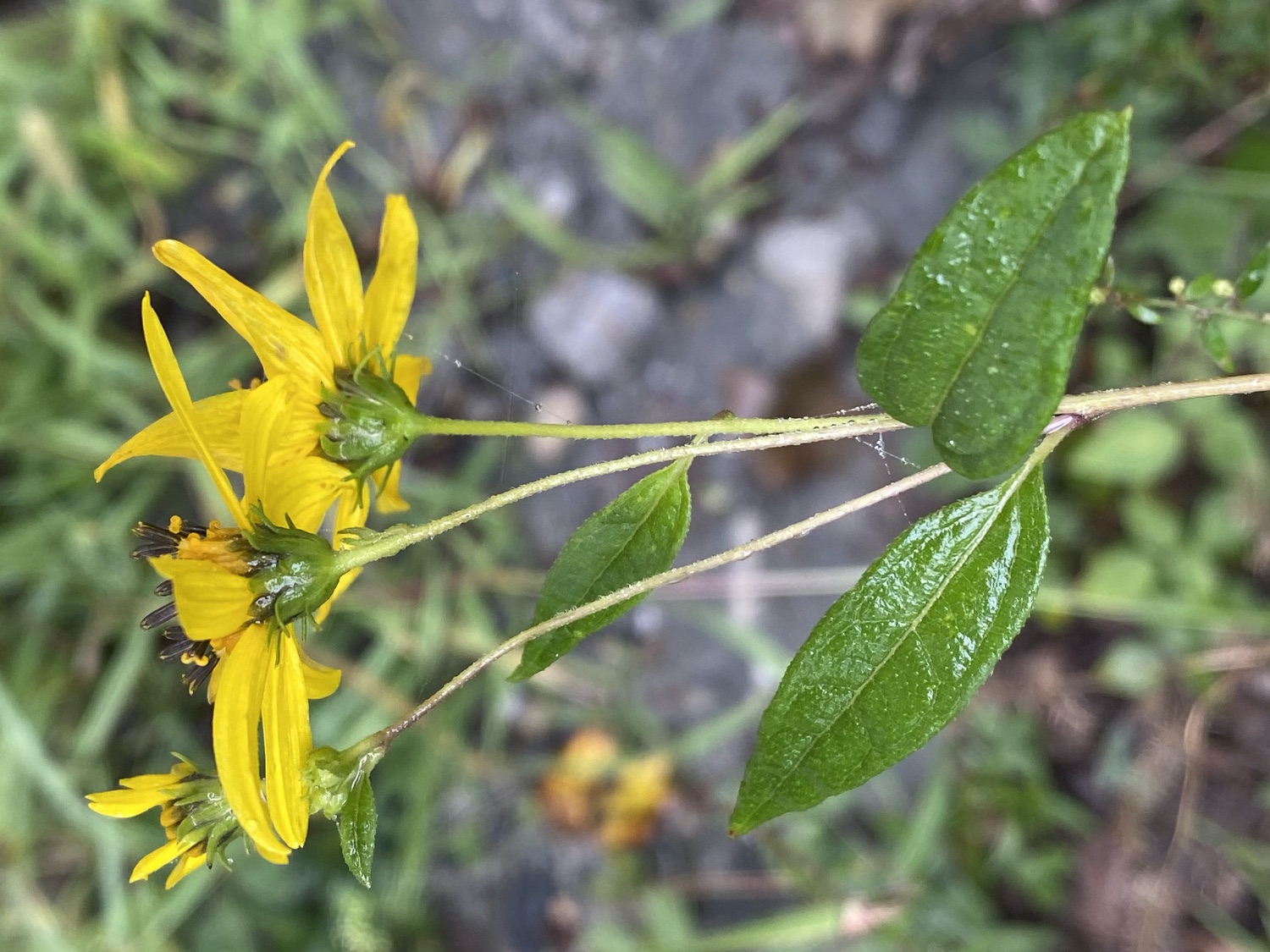
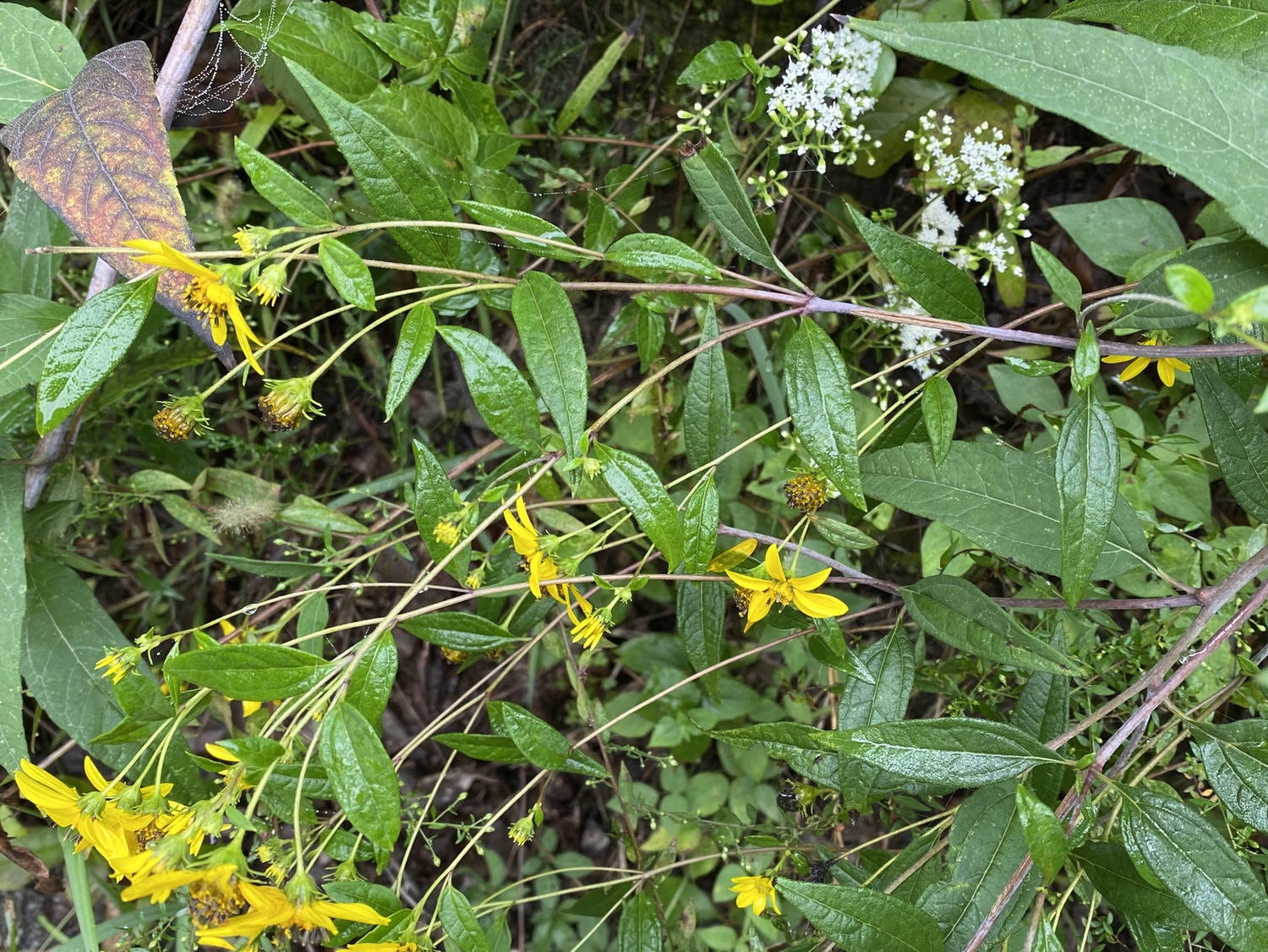
Maryland Golden-Aster (Chrysopsis mariana). These yellow compound flowers have 18–24 grooved ray flowers. The central disk is large, about ⅓ of the width of the flower, and it contains several dozen yellow flowers, slightly darker than the ray flowers. Underneath are 3–4 series of overlapping green bracts held tightly. Each of these bracts is covered with tiny glands on stalks. These are barely visible along the edges of the calices in the photo, and are easier to see with a hand lens. The single green stem has closely spaced stemless lanceolate leaves with a prominent light-green midvein; the size of the leaves decreases upwards. The plants are 1–2' tall.
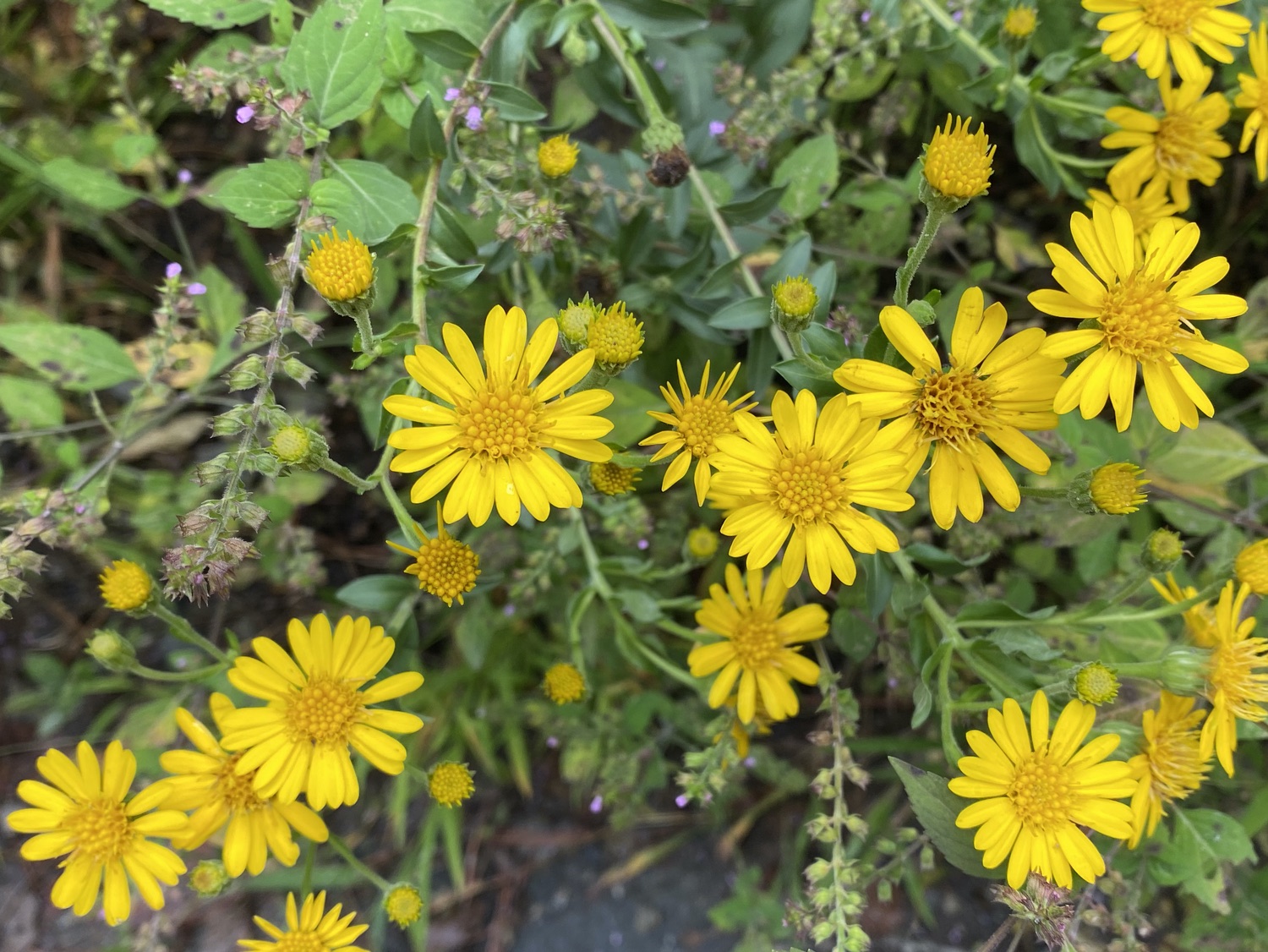
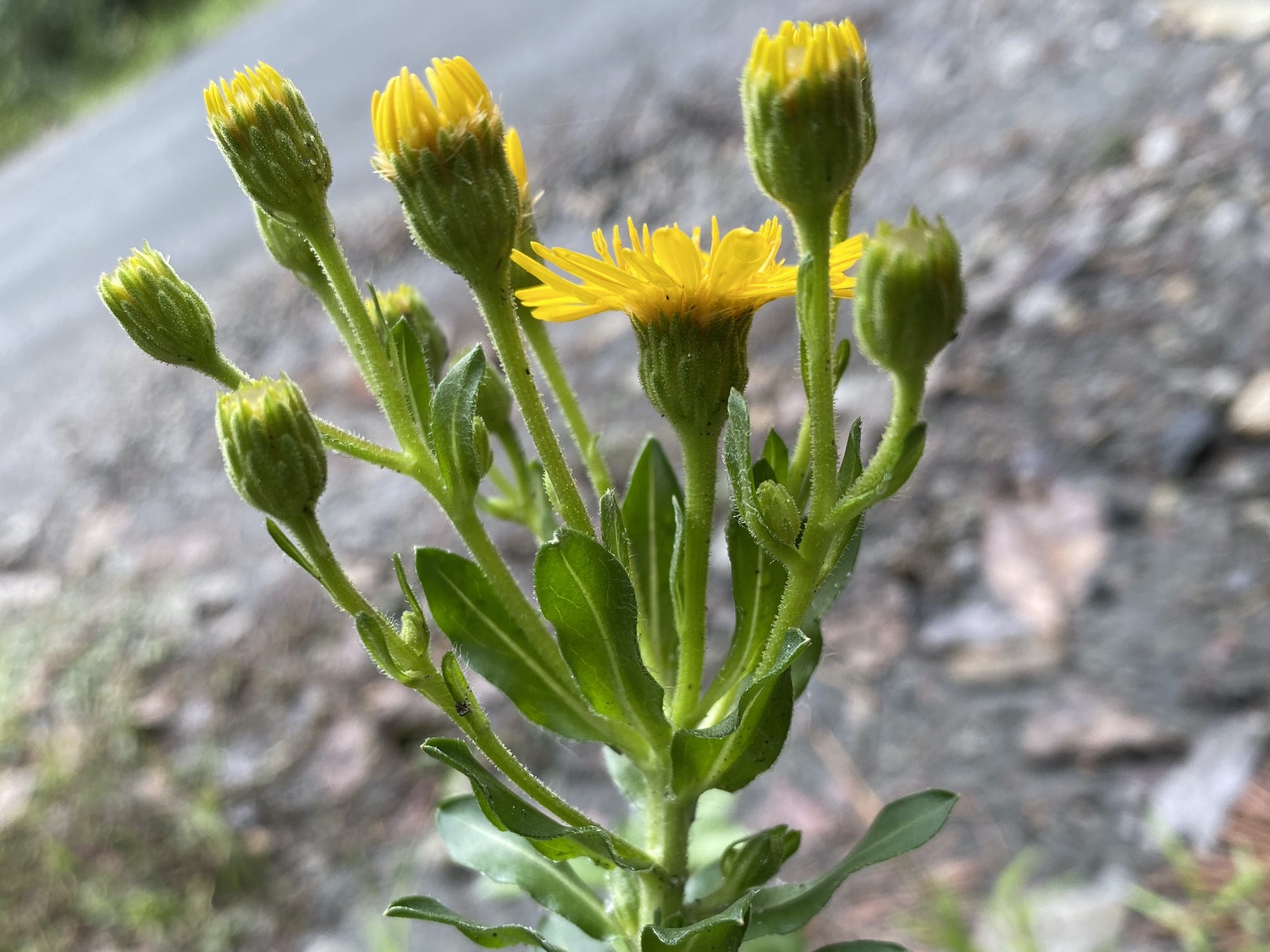
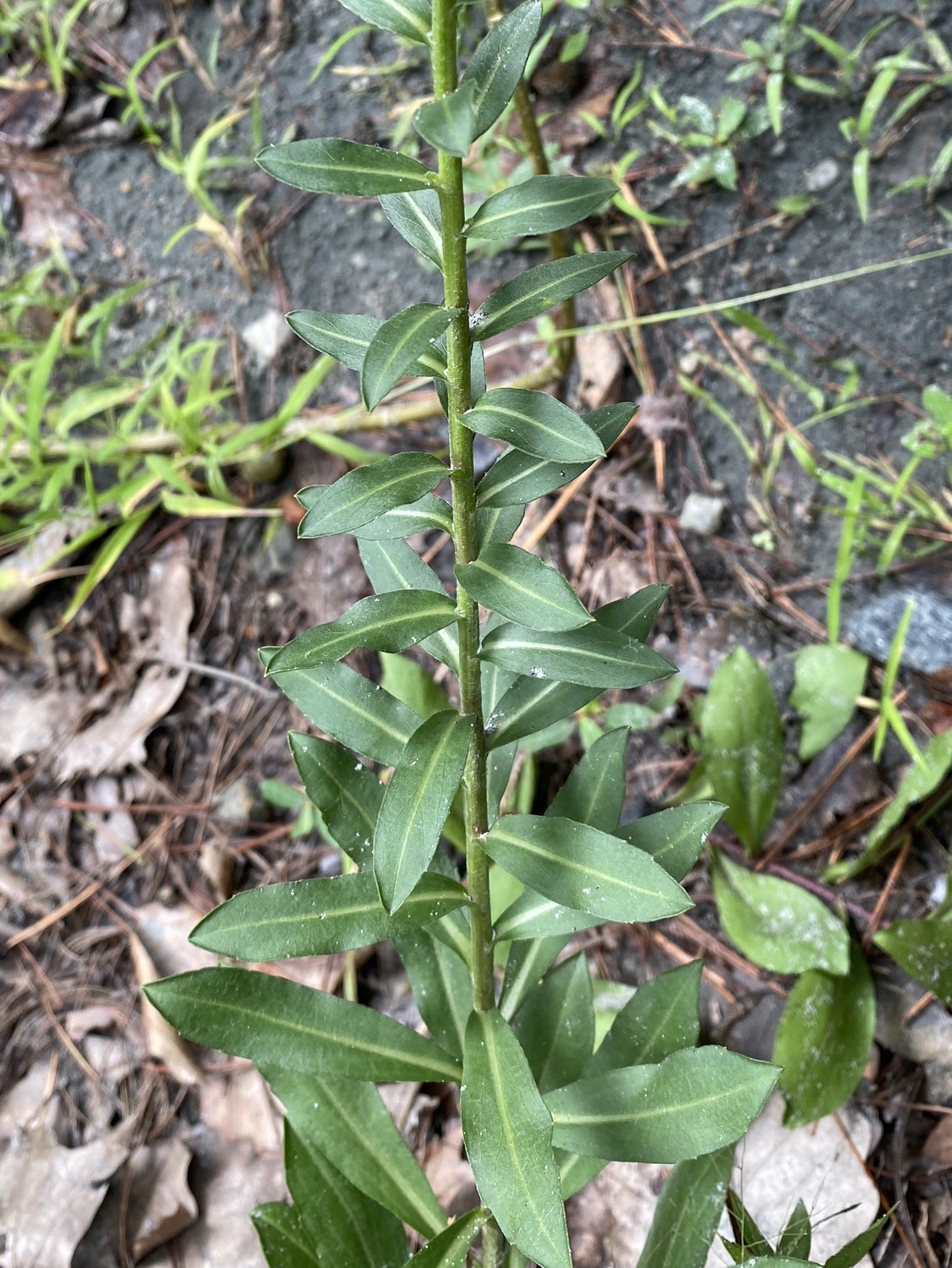
Appalachian Sunflower (Helianthus atrorubens). These compound flowers have about 12–15 long yellow grooved ray flowers. On some, these ray flowers overlap, and on others, they are almost completely separated. The central disk contains numerous dark flowers and a series of variably developed short yellow extensions. I am not sure what those yellow parts are called, but some flower heads will have none, and others are covered with them. Underneath, the bracts are distinctive, they form a couple of series, and they are wide, blunt-tipped, and slightly downcurved. The stem is brown and densely hairy. The basal leaves are large, pointed, and elliptical with winged stalks, and the upper parts of the stem are nearly leaf-free. These are abundant on Currahee and are typically 3–5' tall.
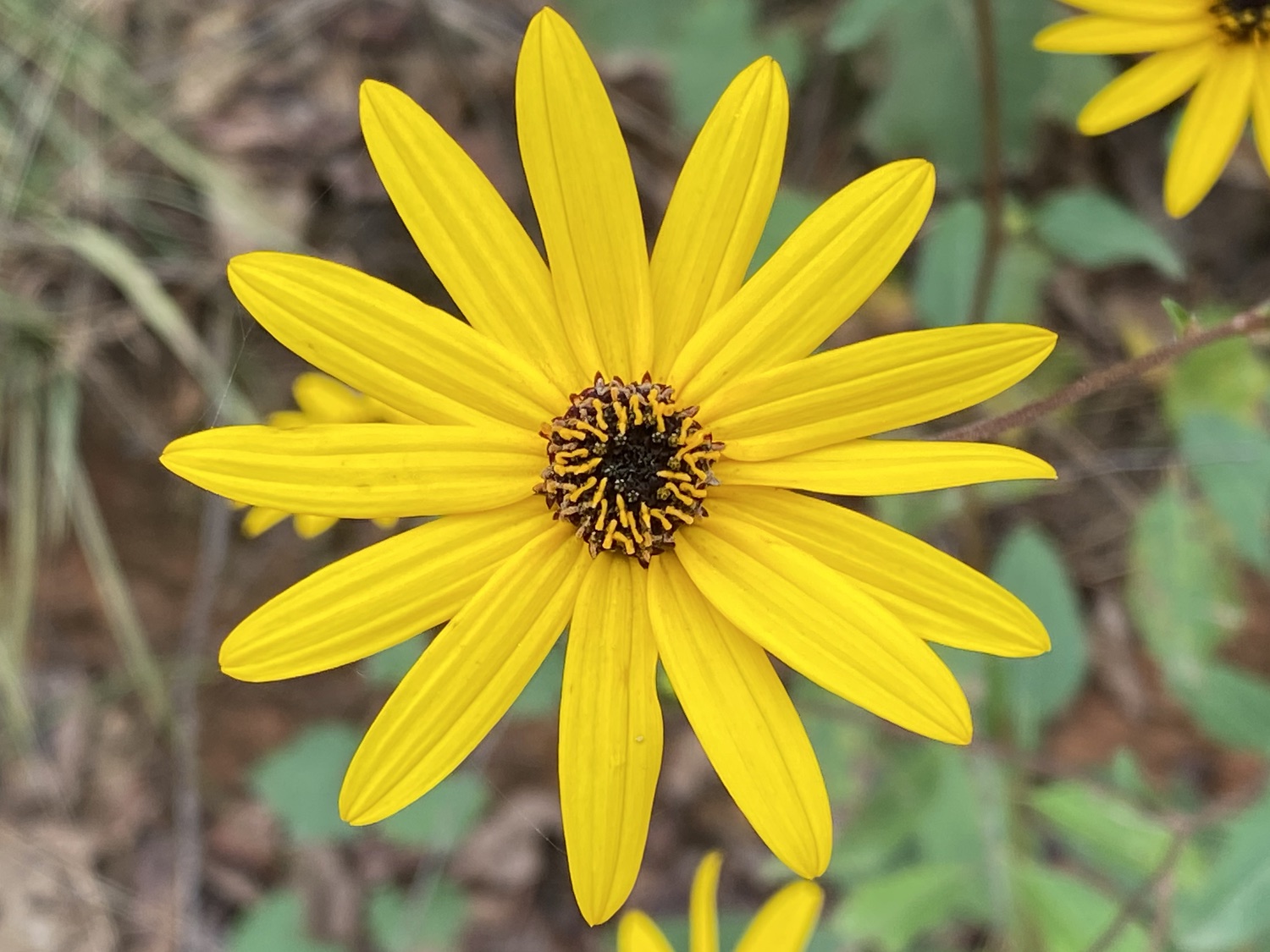
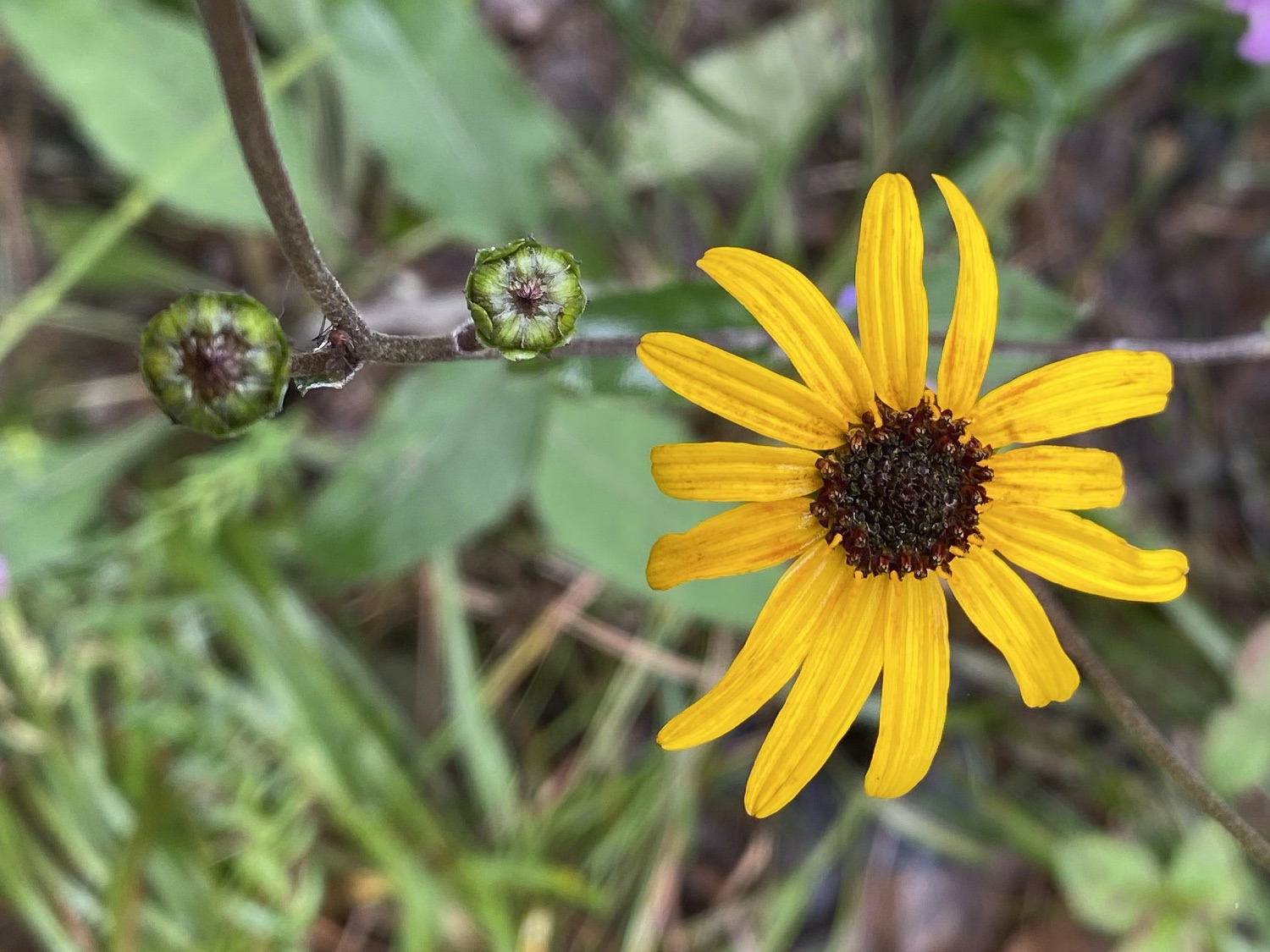
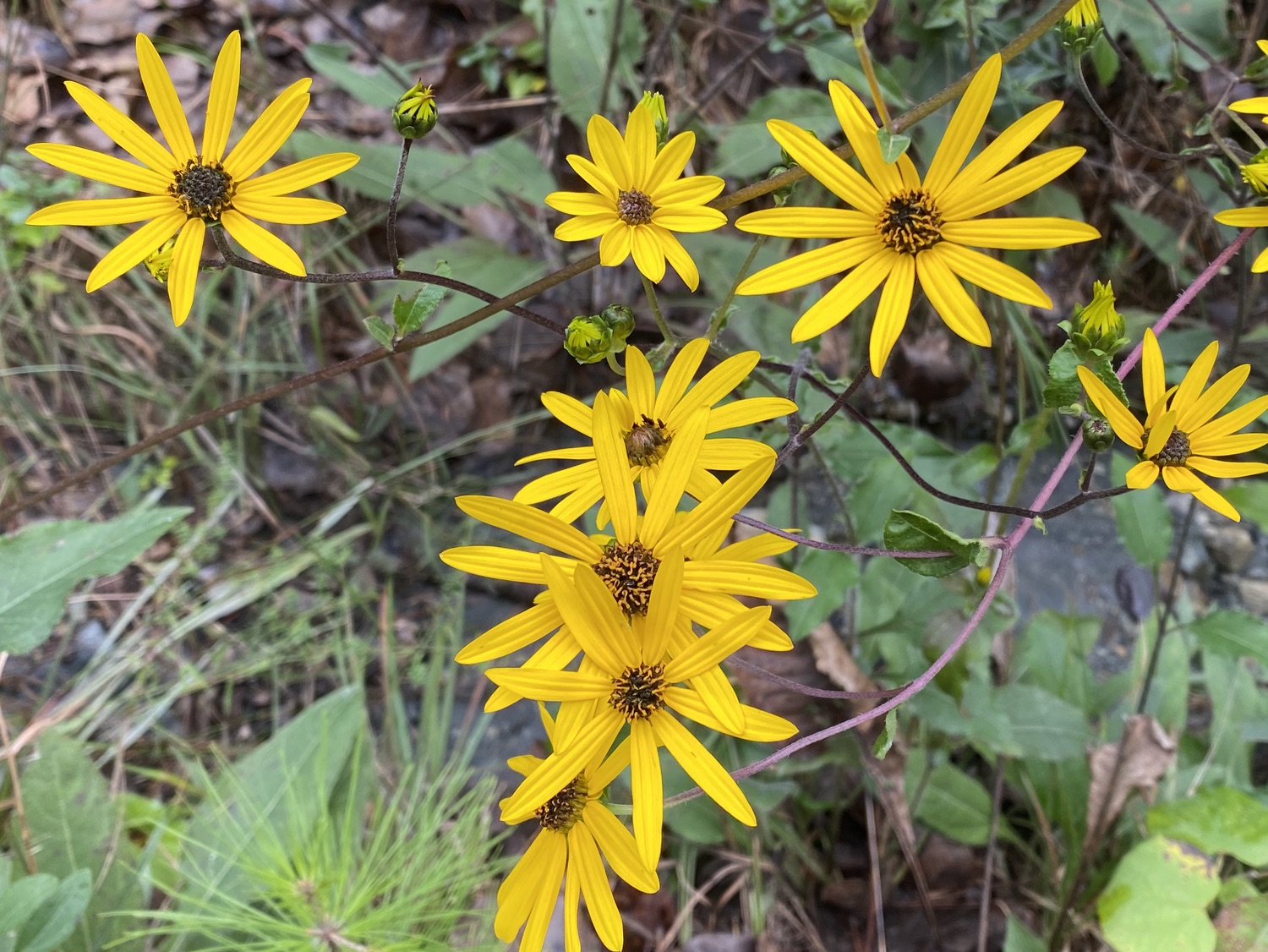

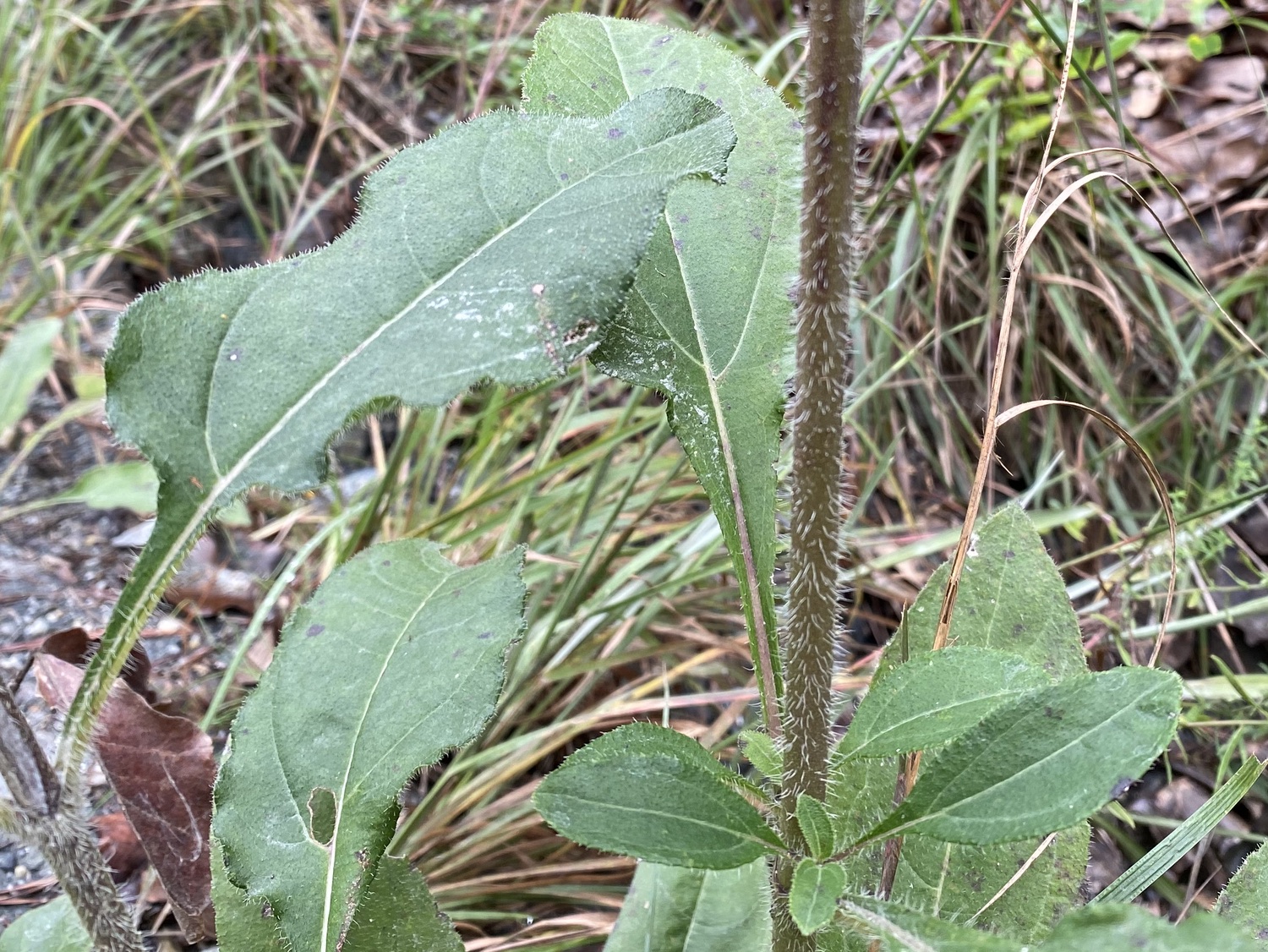
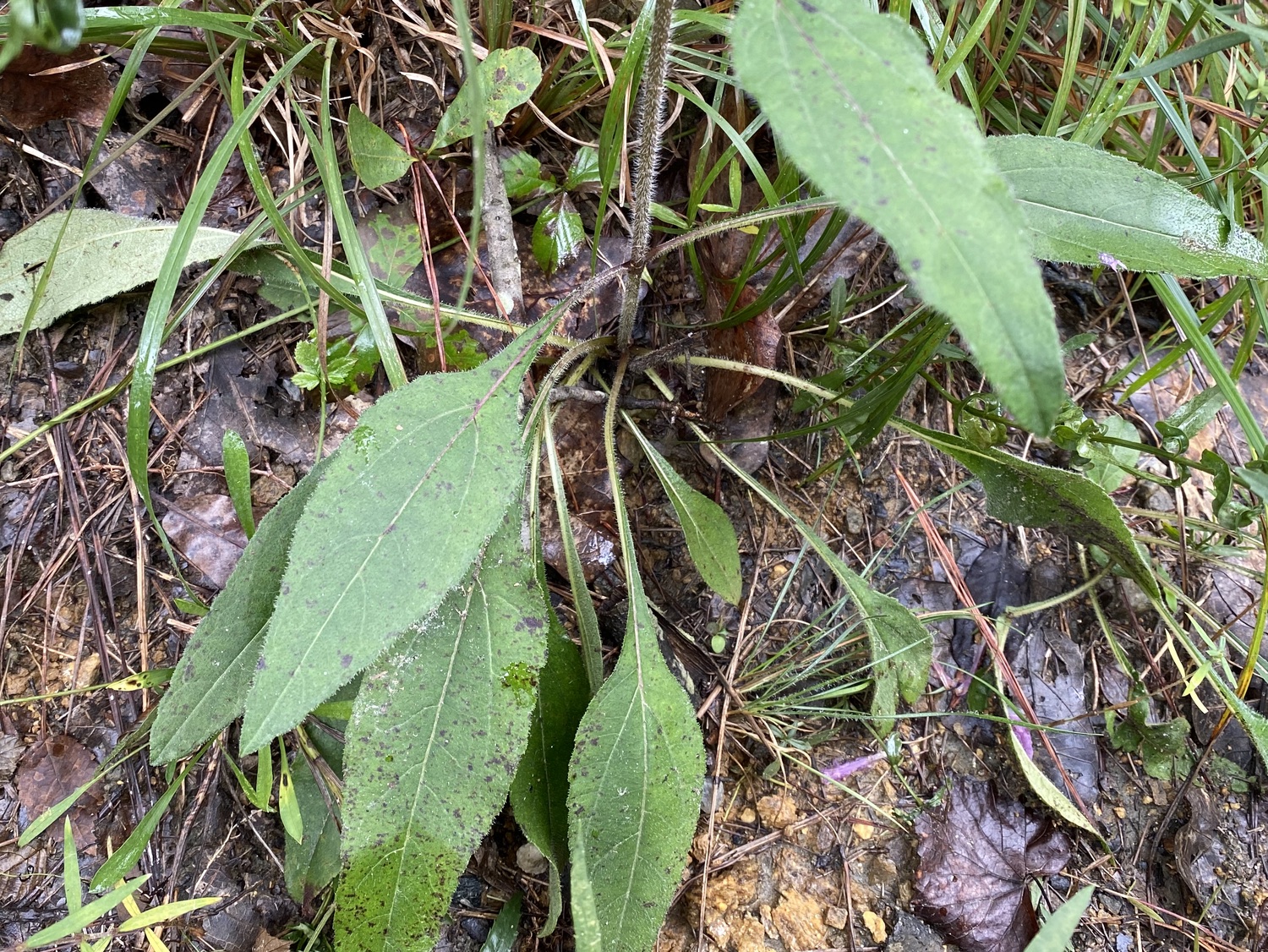
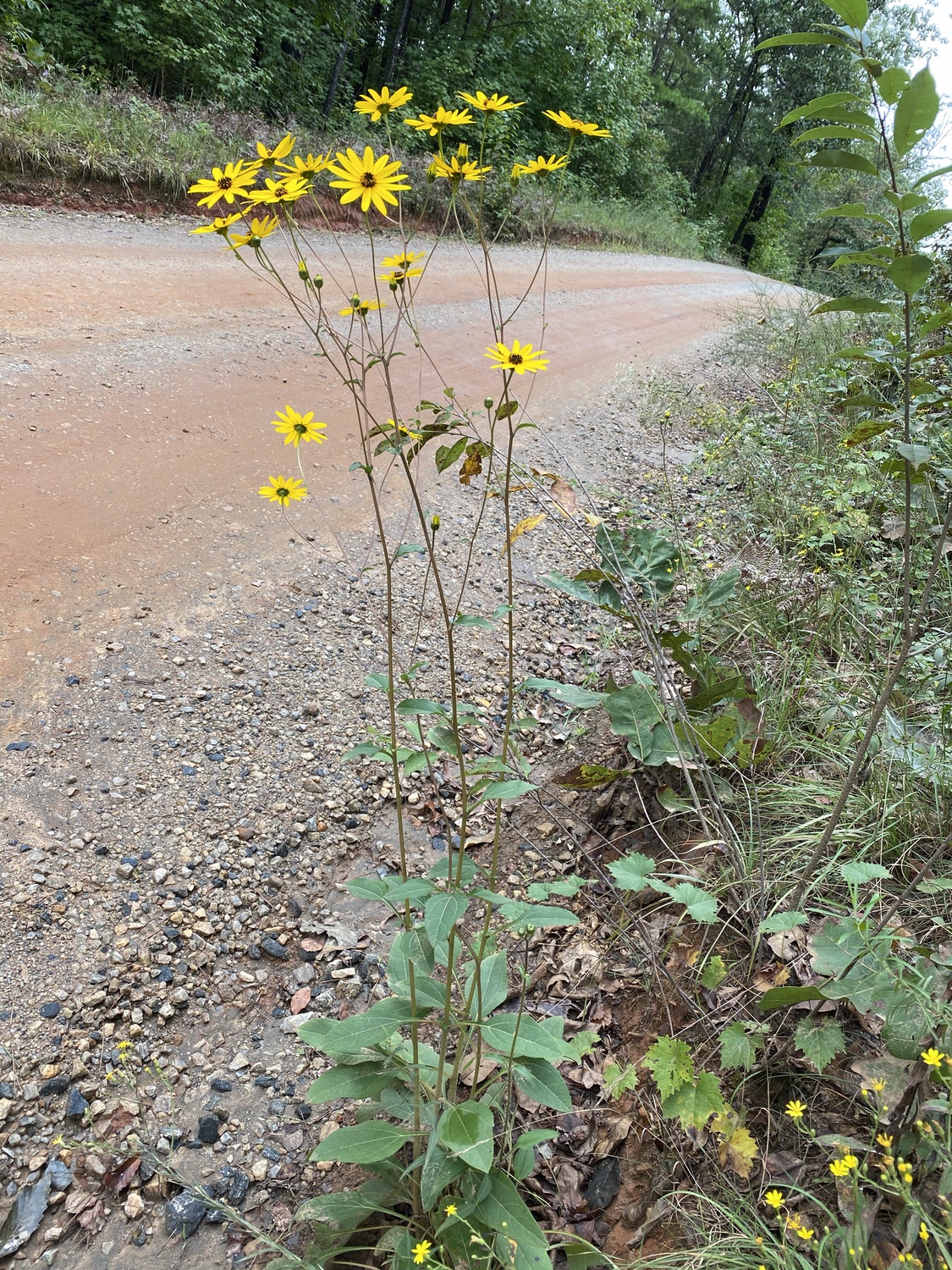
Hairy Sunflower (Helianthus hirsutus). The compound flowers have 8 yellow ridged ray flowers and a largish central disk of yellow flowers. On some flowers of the central disk are long stamens with dark anthers; some flower heads have these, and others don’t, on the same plant. The bracts are long, pointed, and backwardly pointing. The leaves are opposite, on short petioles, relatively long, with wide bases. Distinctively, they are quite stiff and rough to the touch, very much like coarse sand paper. The main stems are pinkish and waxy, but near the flowers, the stem is green and hairy, although not as much as the name might suggest. The plant is 1–2' tall.
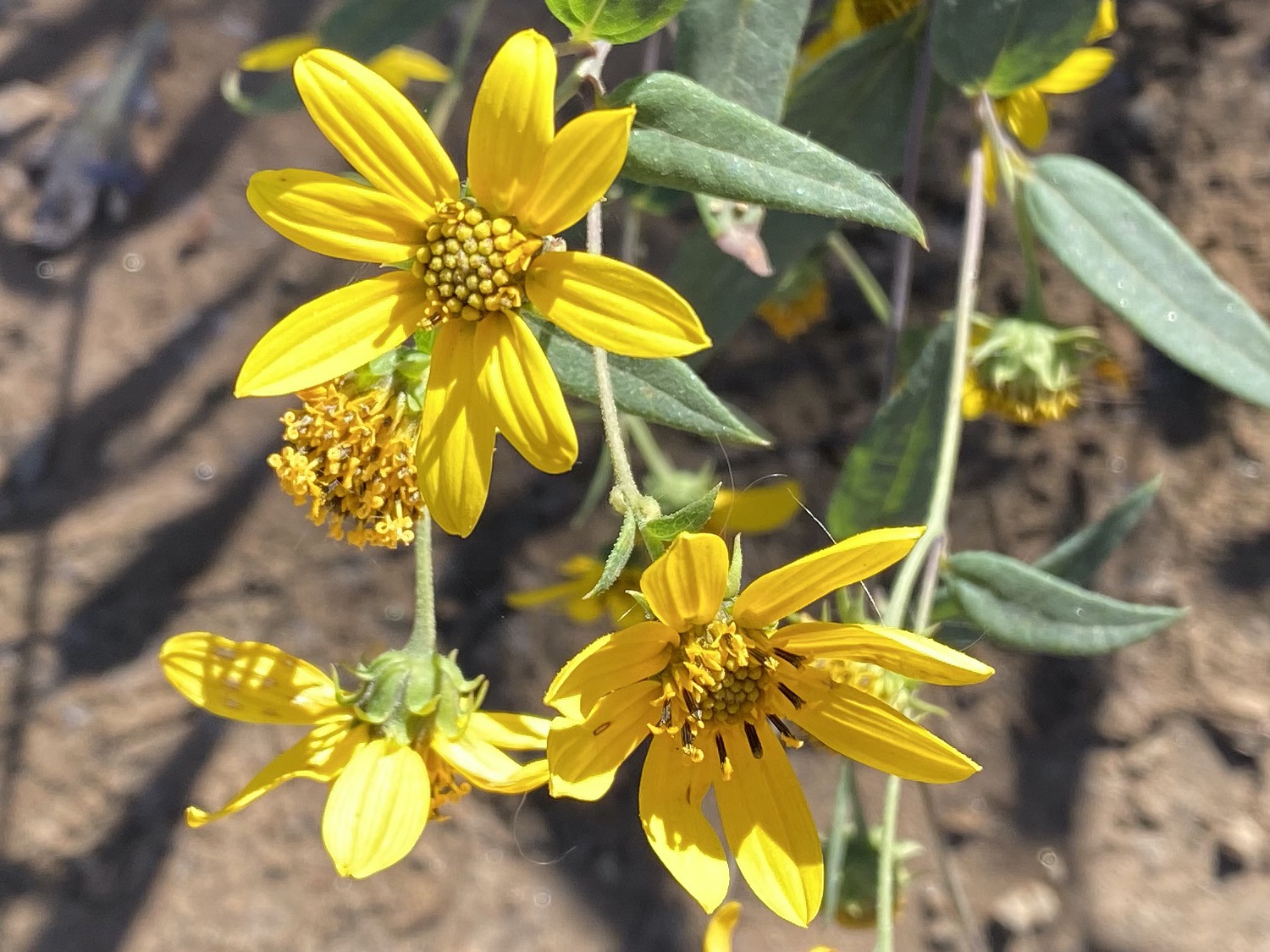
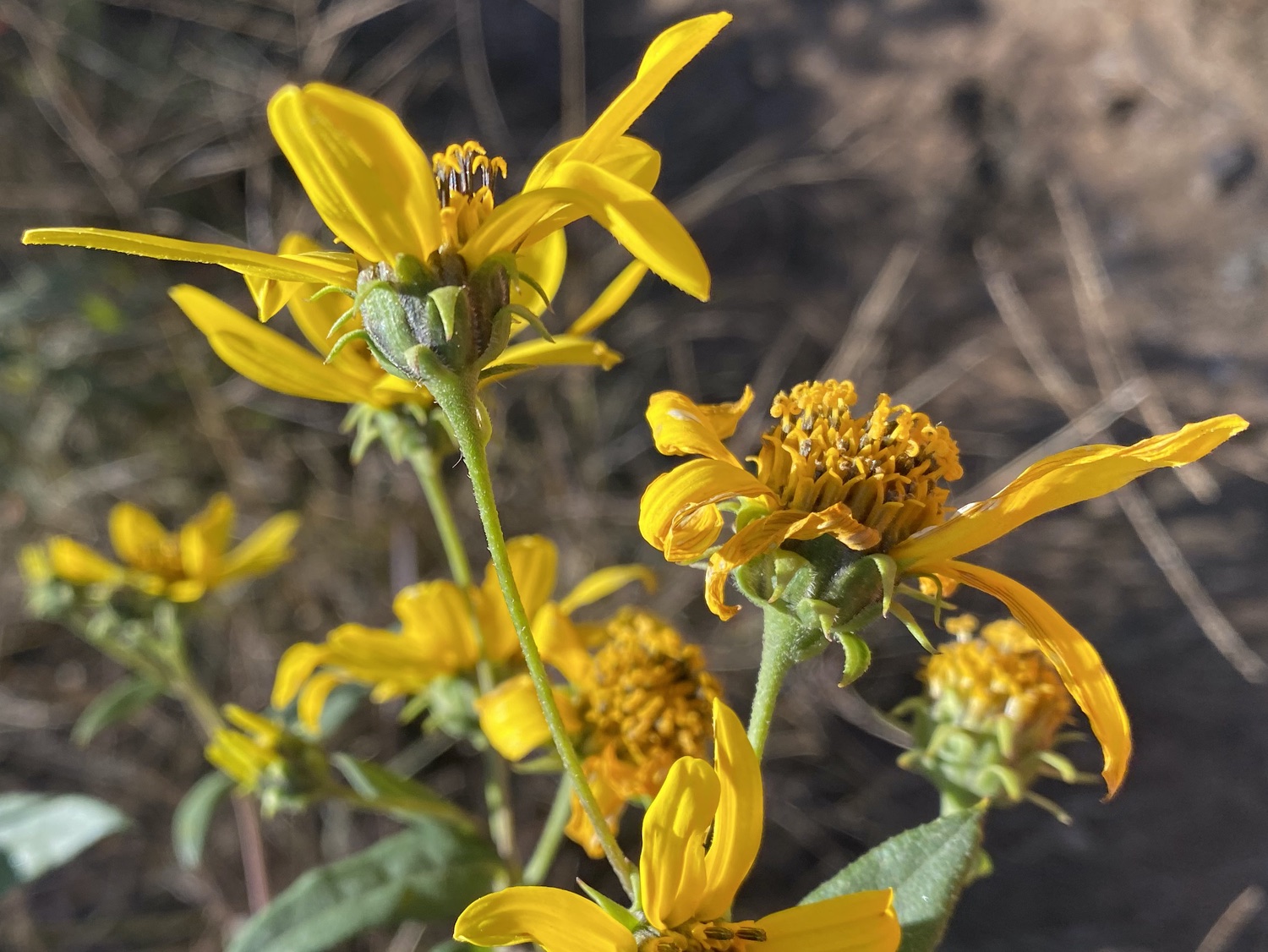
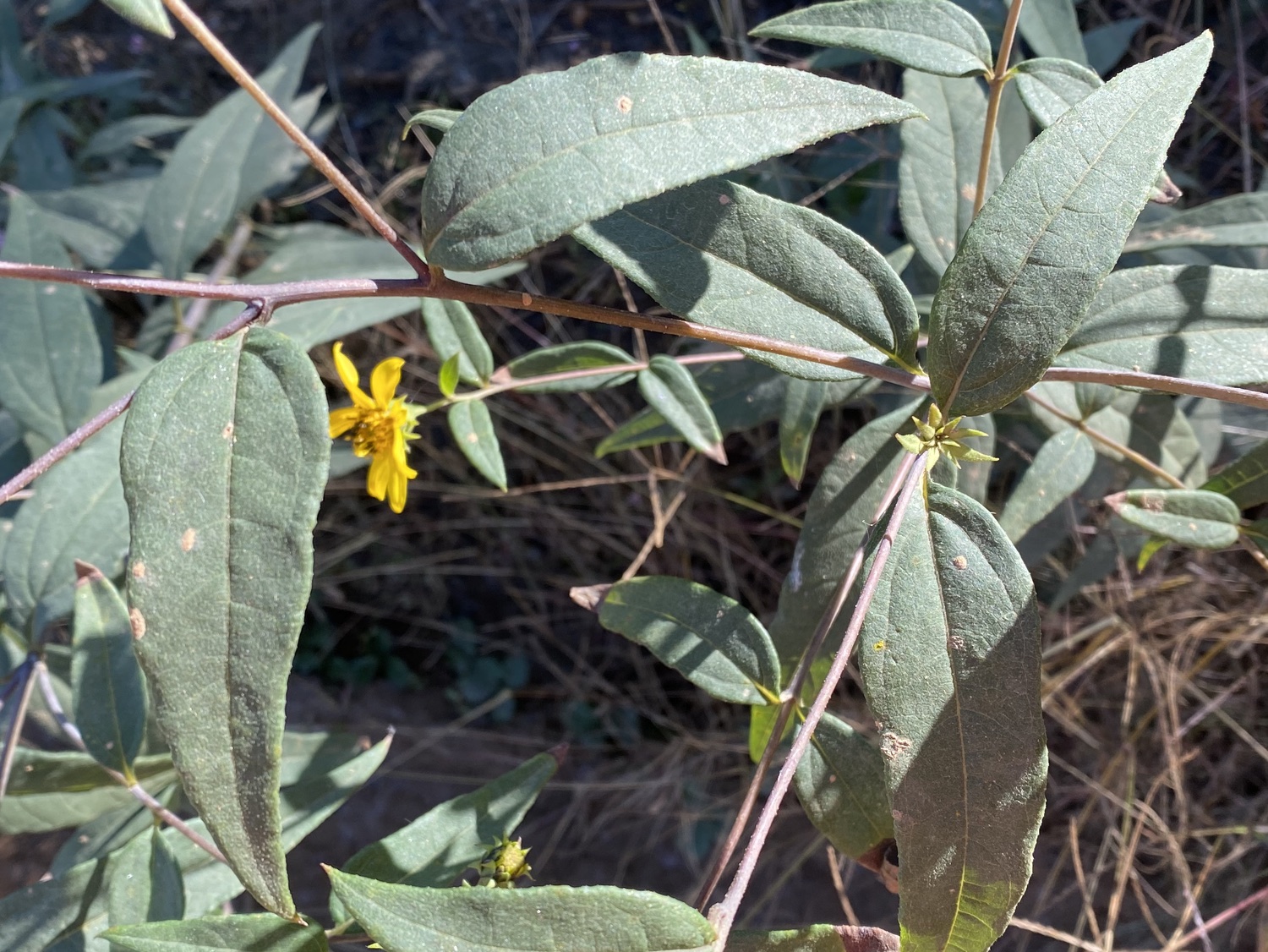
Helianthus (Helianthus sp.). I am pretty sure this is a Helianthus, but it is hard to tell which, as there are so many species in Georgia. The flower is compound with 7–10 ray flowers (maybe more?) and a large yellow central disk. The bracts for 2–3 series, have pointed tips, and extend at right angles to the calyx, giving it a prickly look. The leaves are long and narrow, pointed, widest in the middle, and opposite, with entire margins. The stem is pinkish-red and waxy.
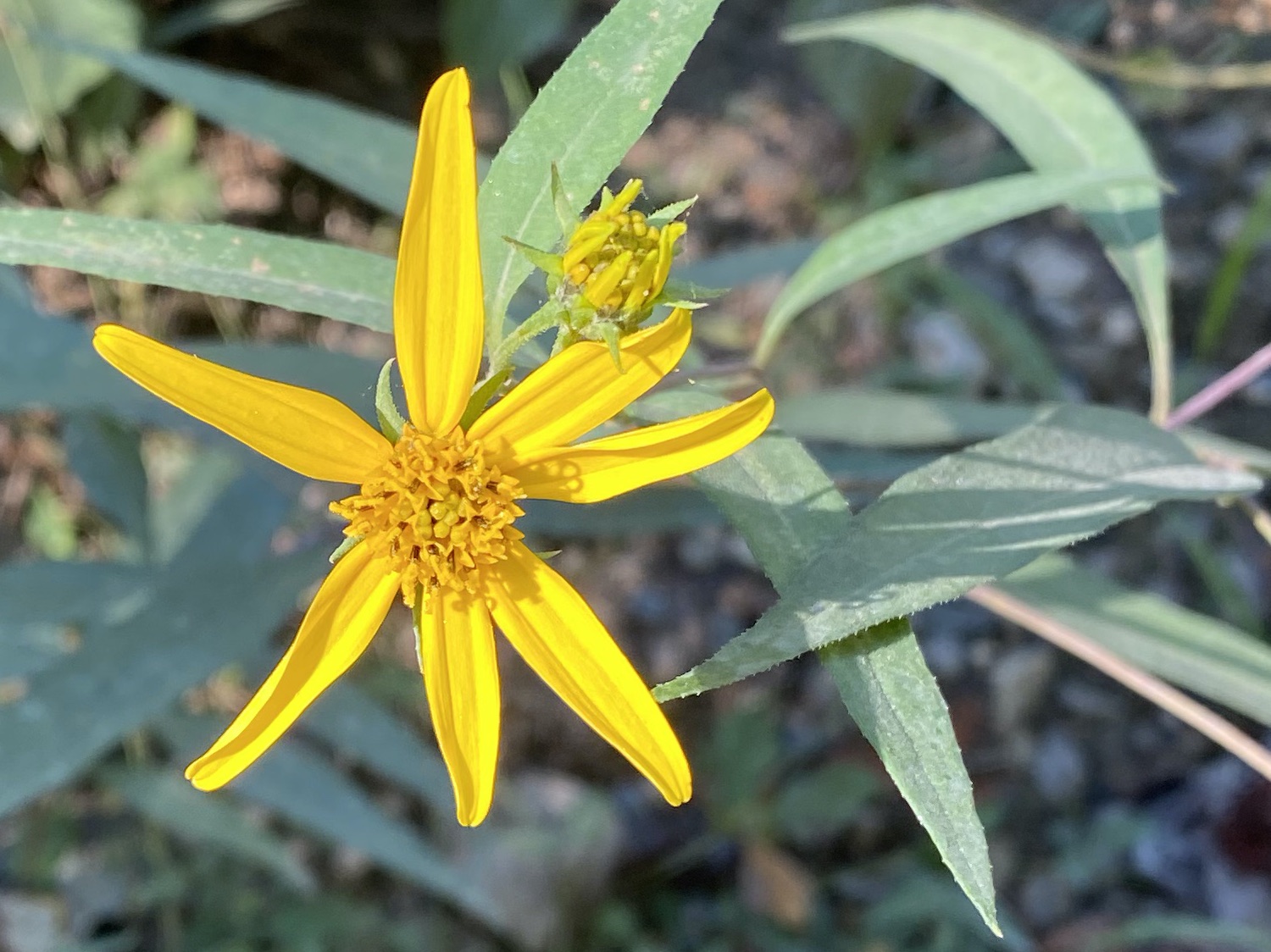

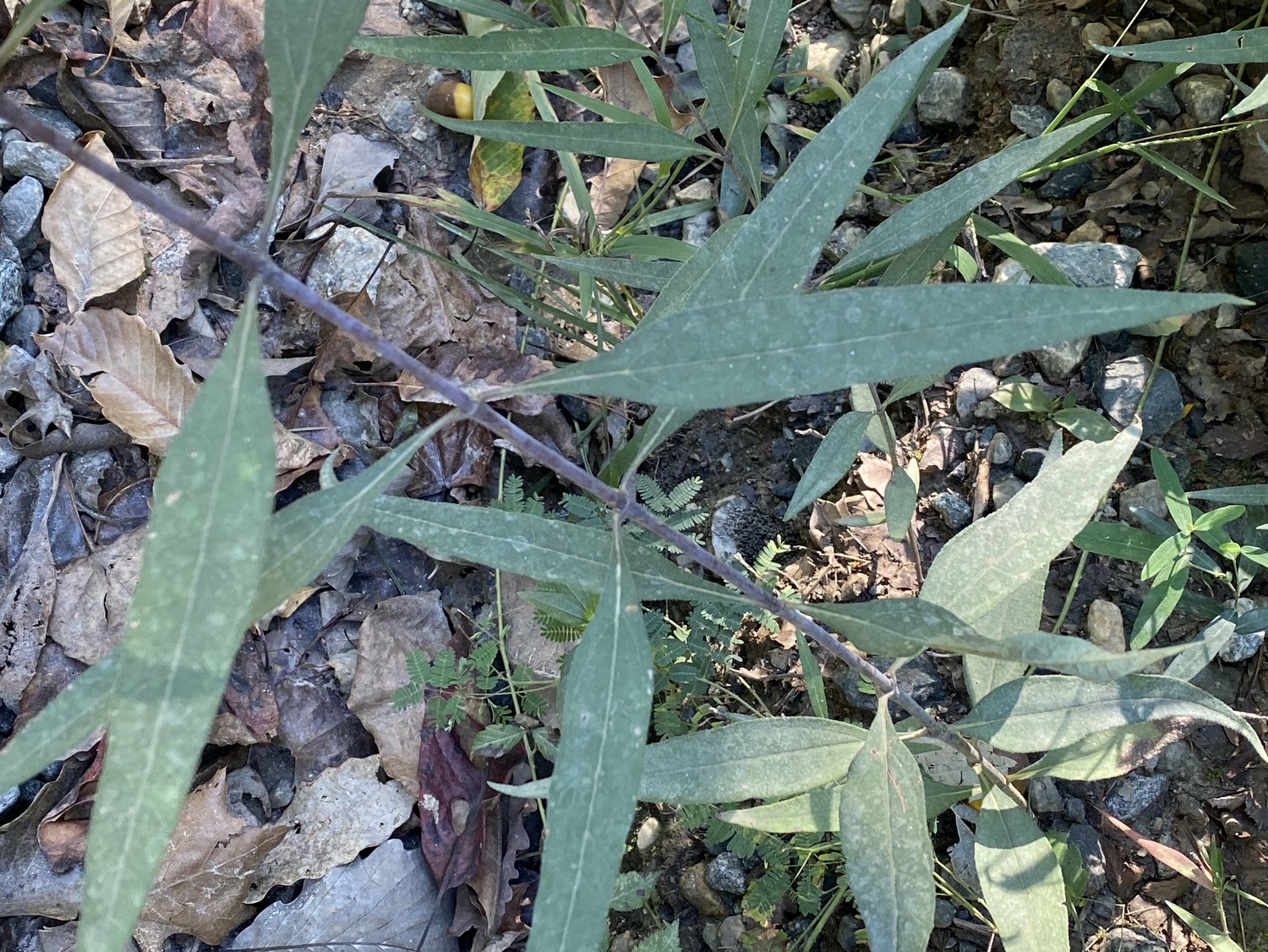
White flowers
Lesser Snakeroot (Ageratina aromatica). These plants are about 3' tall, with repeatedly branching tan stems. The leaves are lanceolate to cordate (heart-shaped), with coarsely toothed edges; the opposite leaves are 3–4 cm near the base, but only 1–2 cm near the top. Stems emerge at these pairs of leaves. The branches end in clusters of tiny white flowers, each with five petals and one long and forked white brace. This is one of the two most common white flowers on Currahee, the other being the Tall Thoroughwort.
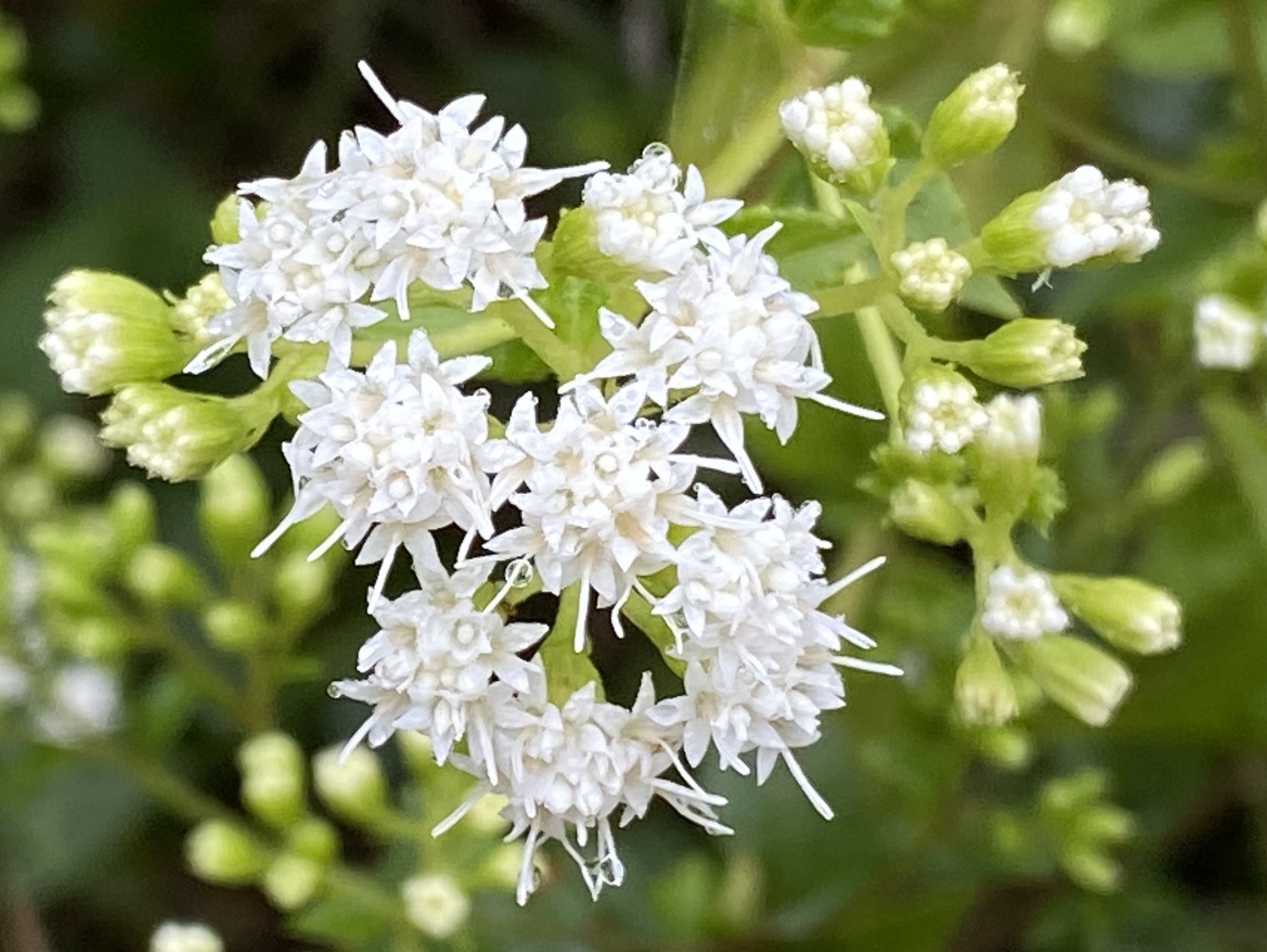
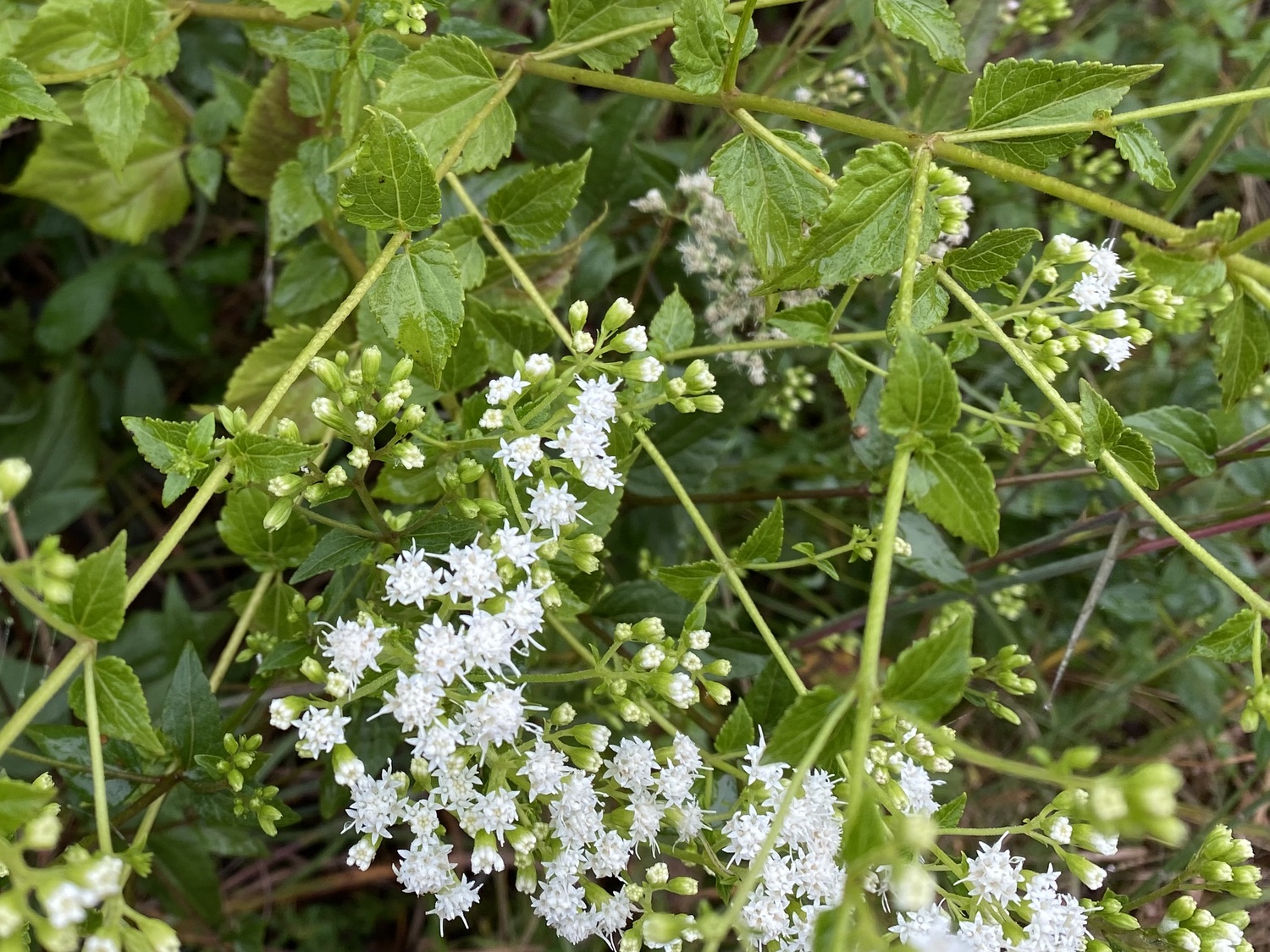
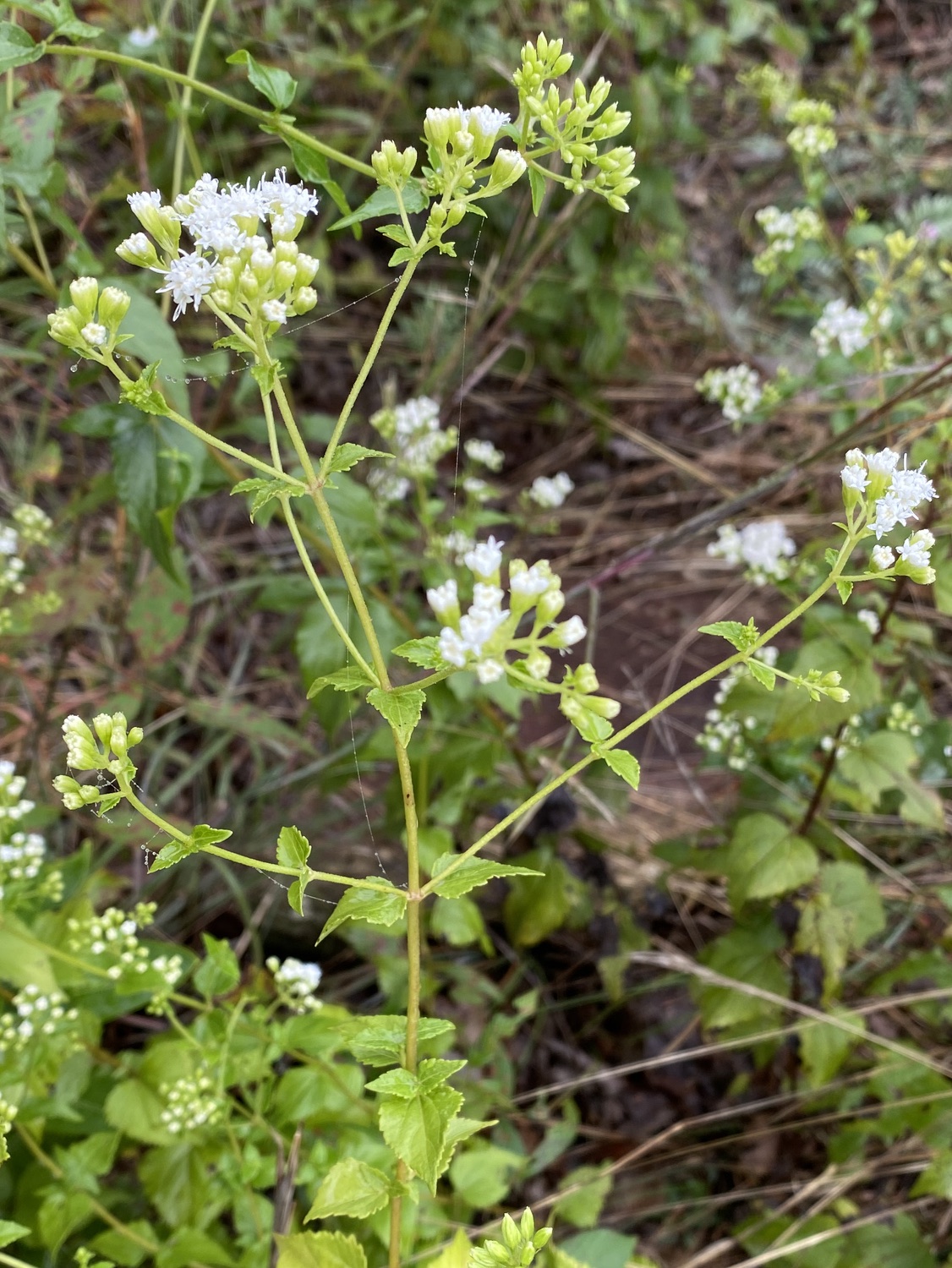
Tall Thoroughwort (Eupatorium altissimum). The flowers of these are typical of many of the Eupatorium species, including Boneset. They are white, with five tiny lobes, with two long projecting styles, and purple to maroon in the center. The bracts around the flowers are tightly held and are very pale whitish green.
One key to distinguishing species of Eupatorium is the shape of the leaves. On this plant, numerous leaves arise radially from the stem at regular intervals, and near the top of the stem, smaller stems arise from the axils in these leaves. Radial leaves are typical for E. hyssopifolium, E. serotinum, and E. altissimum. On this plant, the leaves are narrow, elongate, and coarsely toothed to serrated, although the margins of some leaves are entire, making them most like E. altissimum. Those of E. serotinum are wide at the base and taper towards the tip. Those of E. hyssopifolium are very slender, almost grass-like, and have entire margins.
These plants are about 3' tall, with greenish-brown stems that are finely hairy and finely ridged. Numerous branches arise repeatedly at the top of the plant, and they end in clusters of flowers. These are common on Currahee.
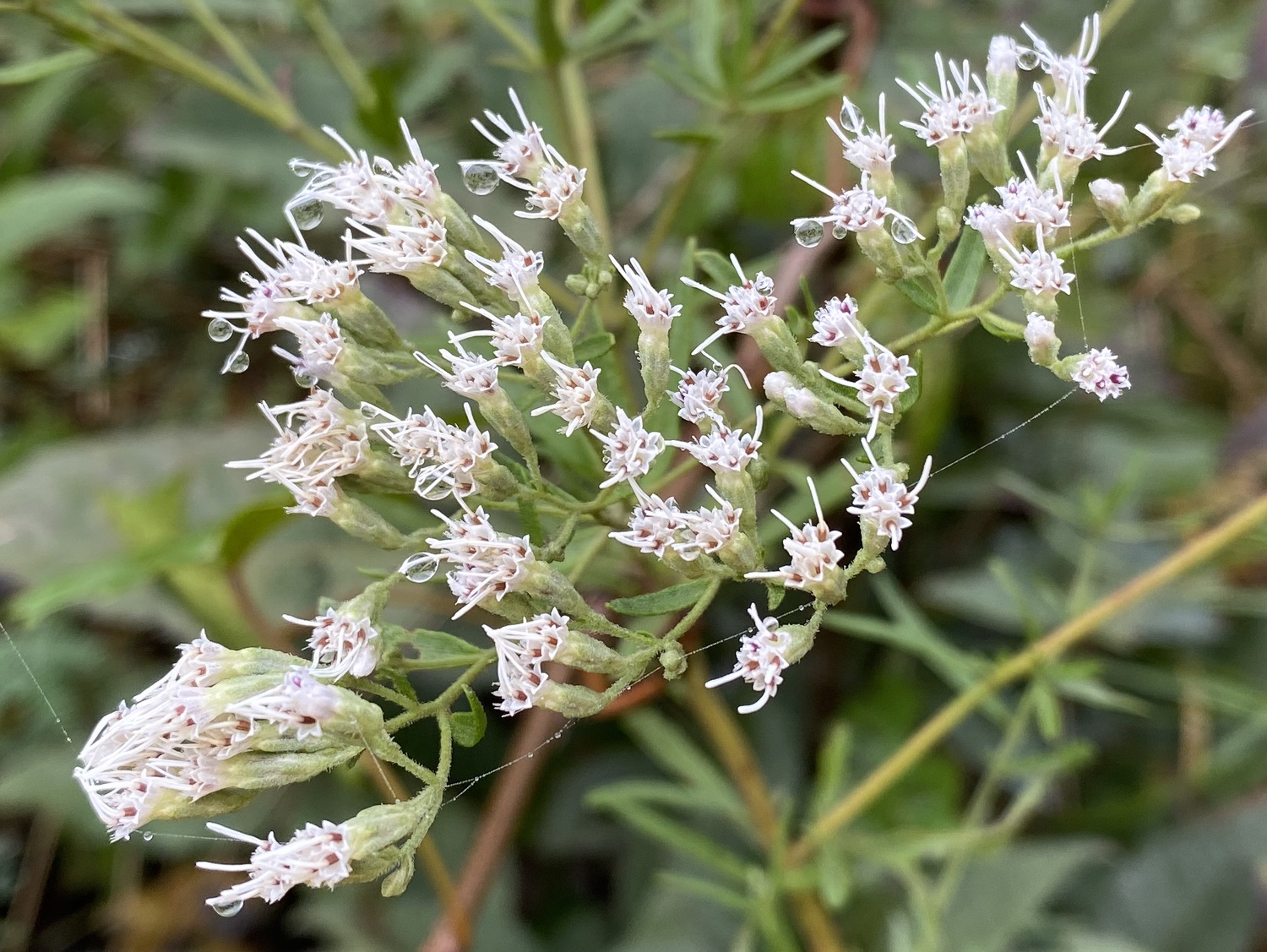
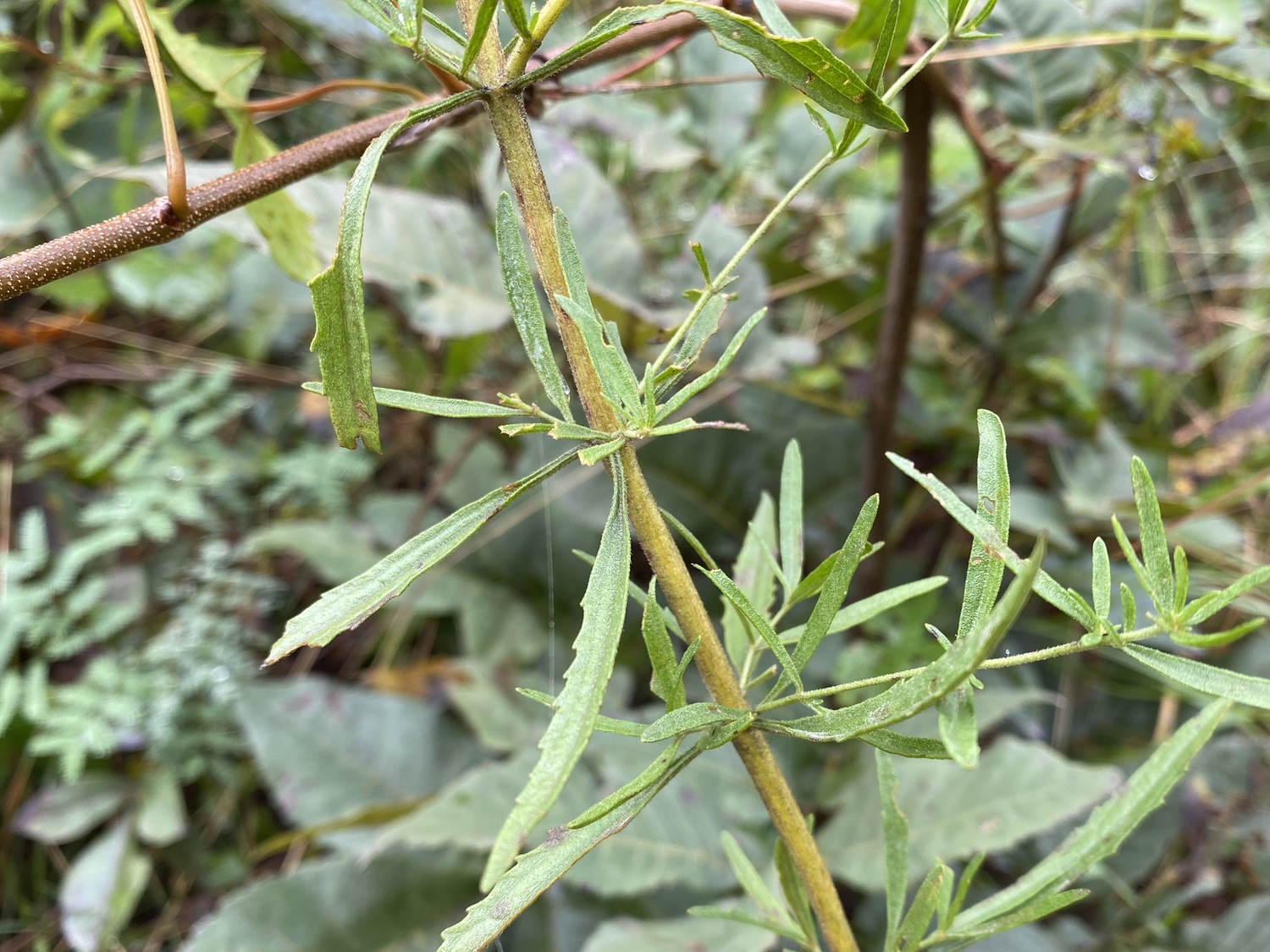

Bushy Aster (Symphyotrichum dumosum). These compound flowers have about 24 round-tipped white ray flowers and a cluster of many yellow flowers in the central disk. On older flowers, the disk flowers turn a pale rusty pink. The bracts are arranged in several series, held close to the stem, forming a compact cup; the appear to be blunt-tipped. The stems are crowded with numerous clusters of tiny (1 cm) leaves, with a few long, slender, and pointed leaves that are mostly withered (a characteristic of this genus). The stem is brown, woody, and ridged. Multiple stems arise from a set of roots, making the plant almost like a small bush. The plant is 2–3' high and grows in dense clusters. This was growing only in the parking area at Currahee, and it might be a non-native plant, based on that.
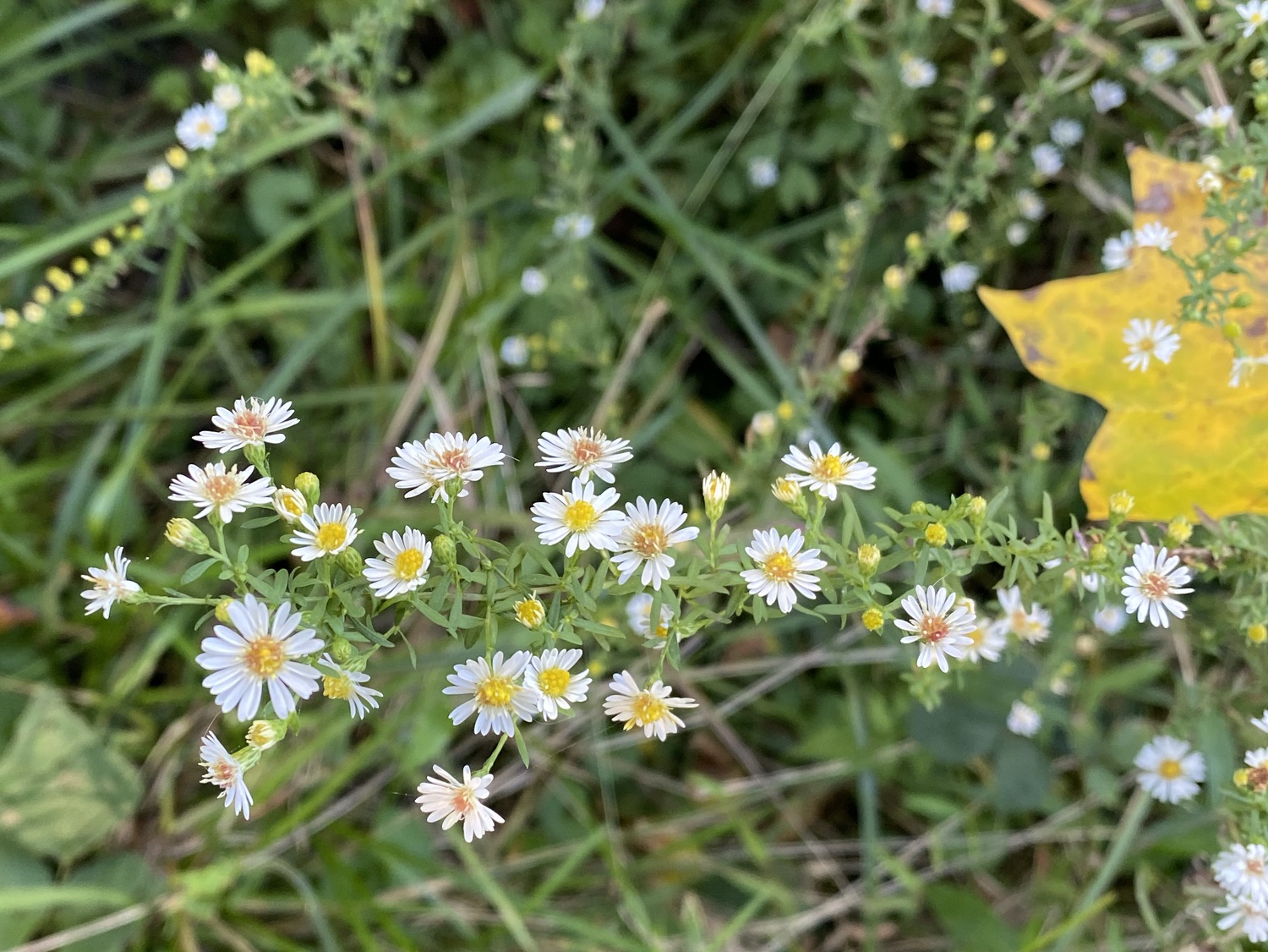

Blue and lavender flowers
Clasping Aster (Symphyotrichum patens). These compound flowers have about 15–20 blue–purple ray flowers and a couple dozen yellow flowers in the central disk. Several rows of dark-tipped green bracts form a cylinder around the base, and very short leaves alternate from the stem just below a flower. The main stem is reddish-brown, bearing alternate stemless hairy leaves, whose bases project to the far side of the stem. The plant is 2–3' long, but it falls over, lying along the ground.
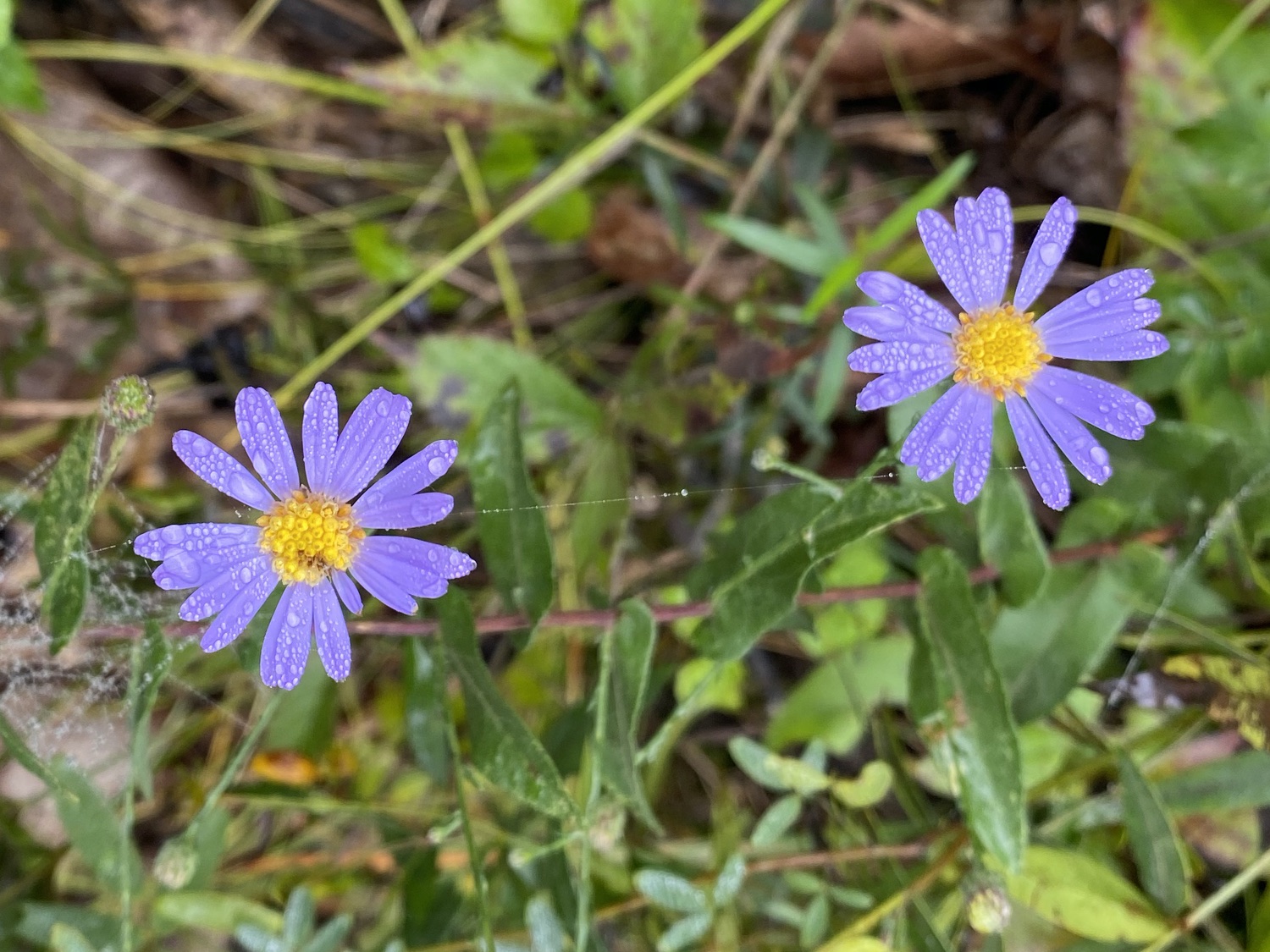
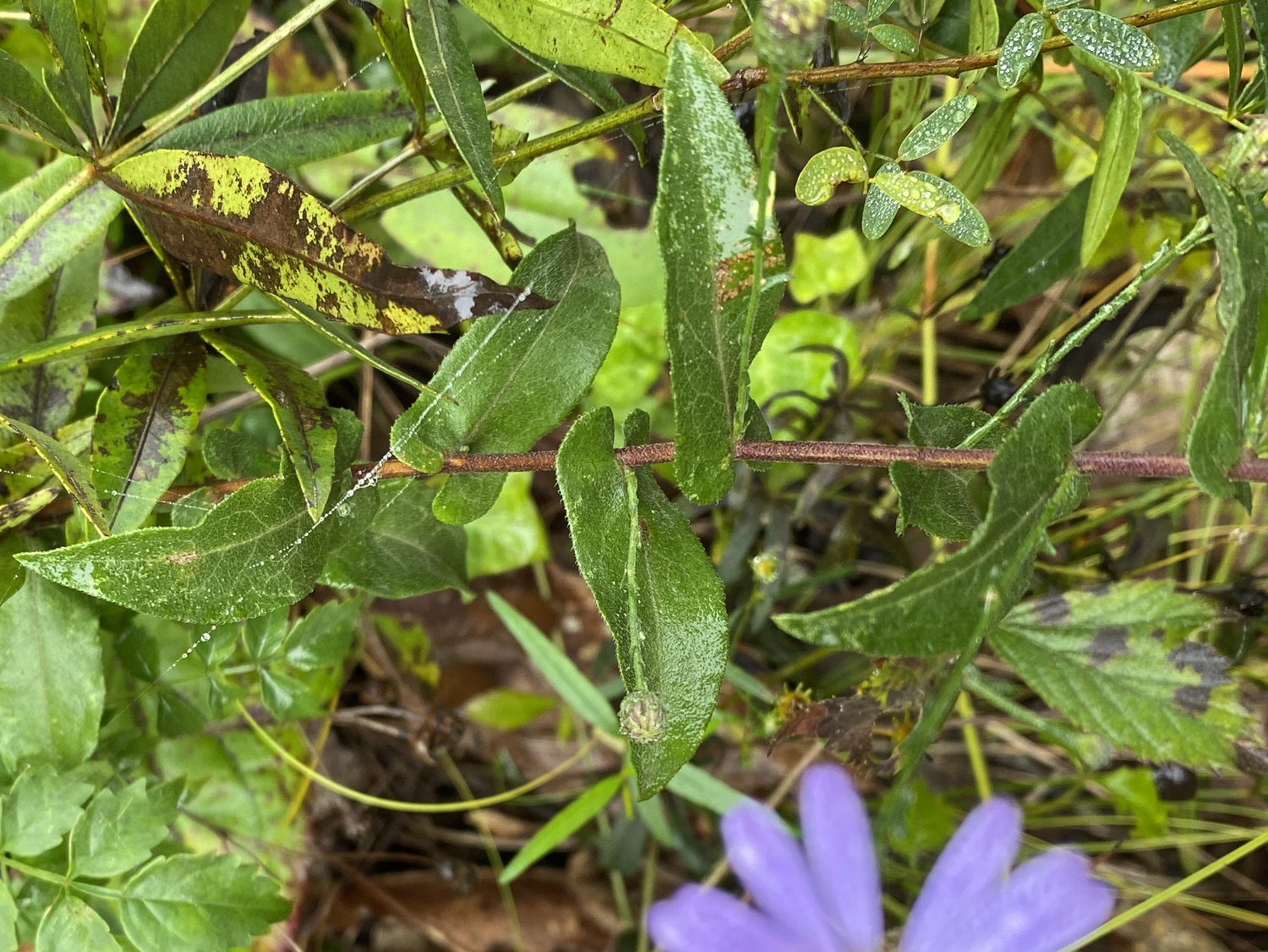
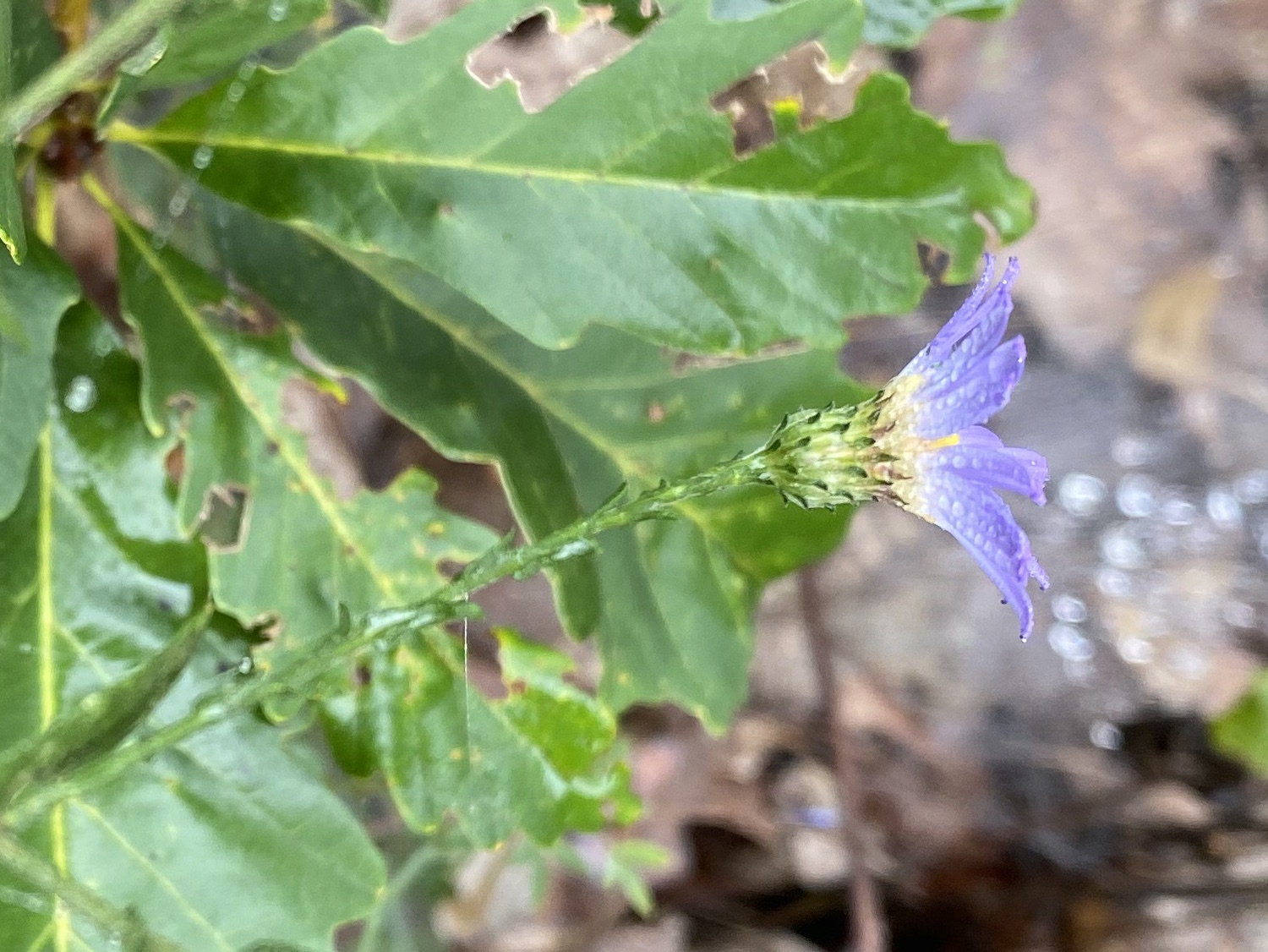
Appalachian Clasping Aster (Symphyotrichum phlogifolium) These bushy plants have clusters (panicles) of compound flowers. Each has 12–16 blue-lavender ray flowers with narrow whitish bases. The central disk is relatively large and contains many yellow flowers. On some flower heads, short white-tipped projections extend from the edge of the central disk. Underneath are several series of bracts, each ending in a narrow tip that projects from the calyx. The leaves are alternate, elliptical, narrow; they are also stemless and they wrap around the stem at their base, and stemless. At the top, the leaves are short and stubby (less than 1 cm), but farther down the stalk, the leaves are several centimeters long, parallel-sided, pointed, and with a deep midvein. The plant is 1–2' tall.
The clasping leaves and blue/yellow flowers are distinctive, and the leaves are much longer and narrower than those of the Clasping Aster, which leads me to think it is this species, based on the description in Chafin. I am not entirely sure about this, as I cannot find any photographs of this species online.
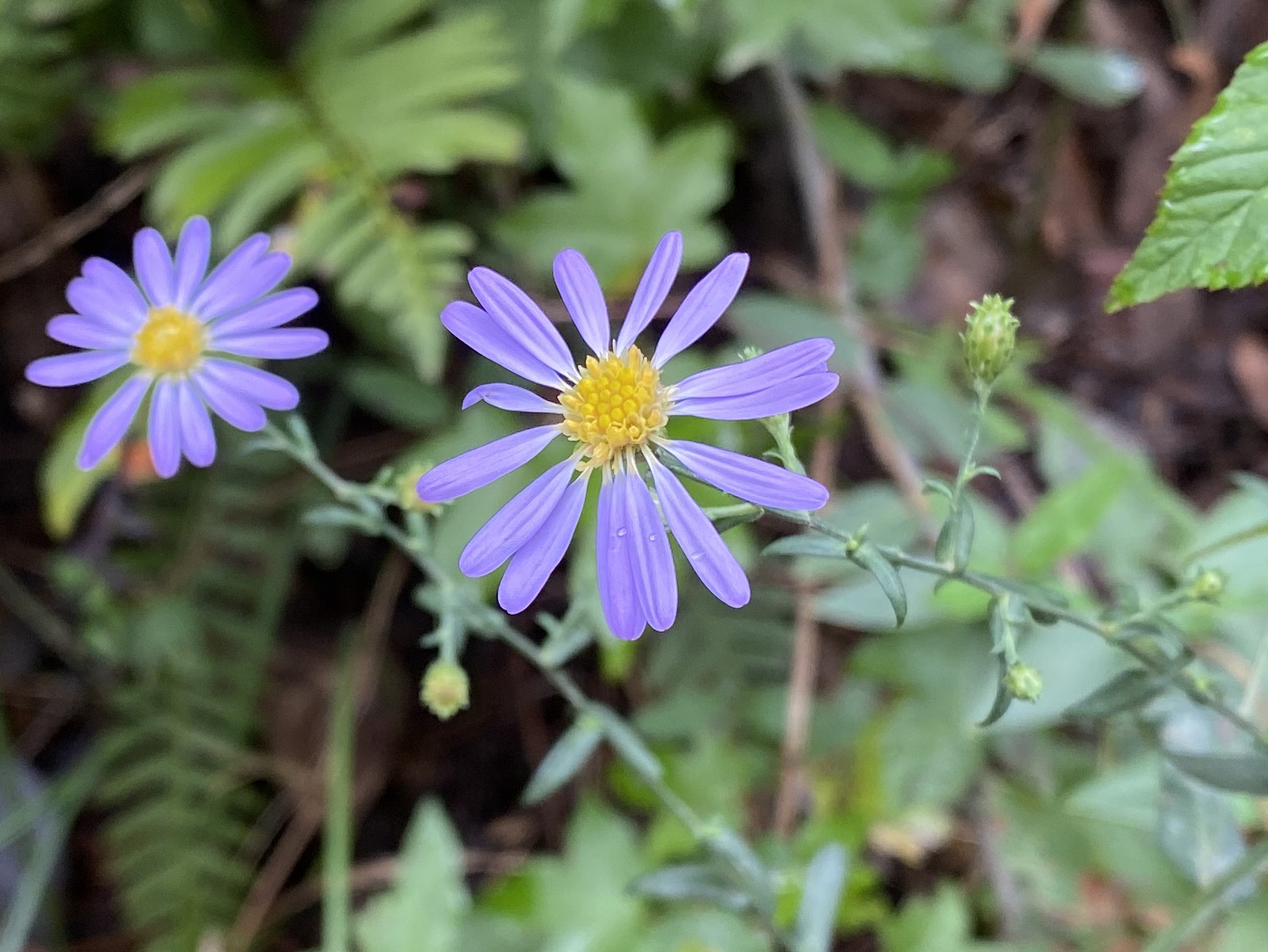
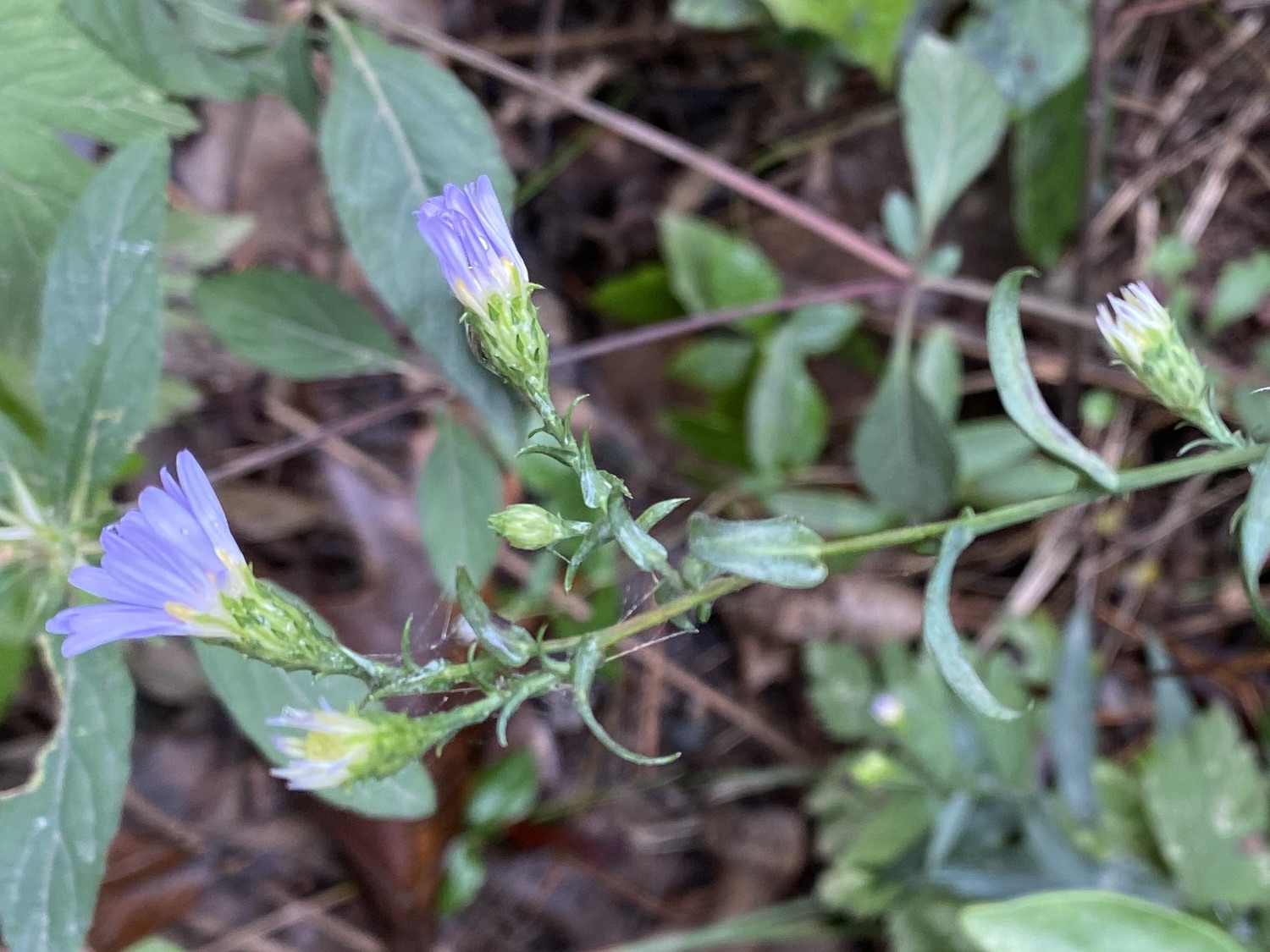
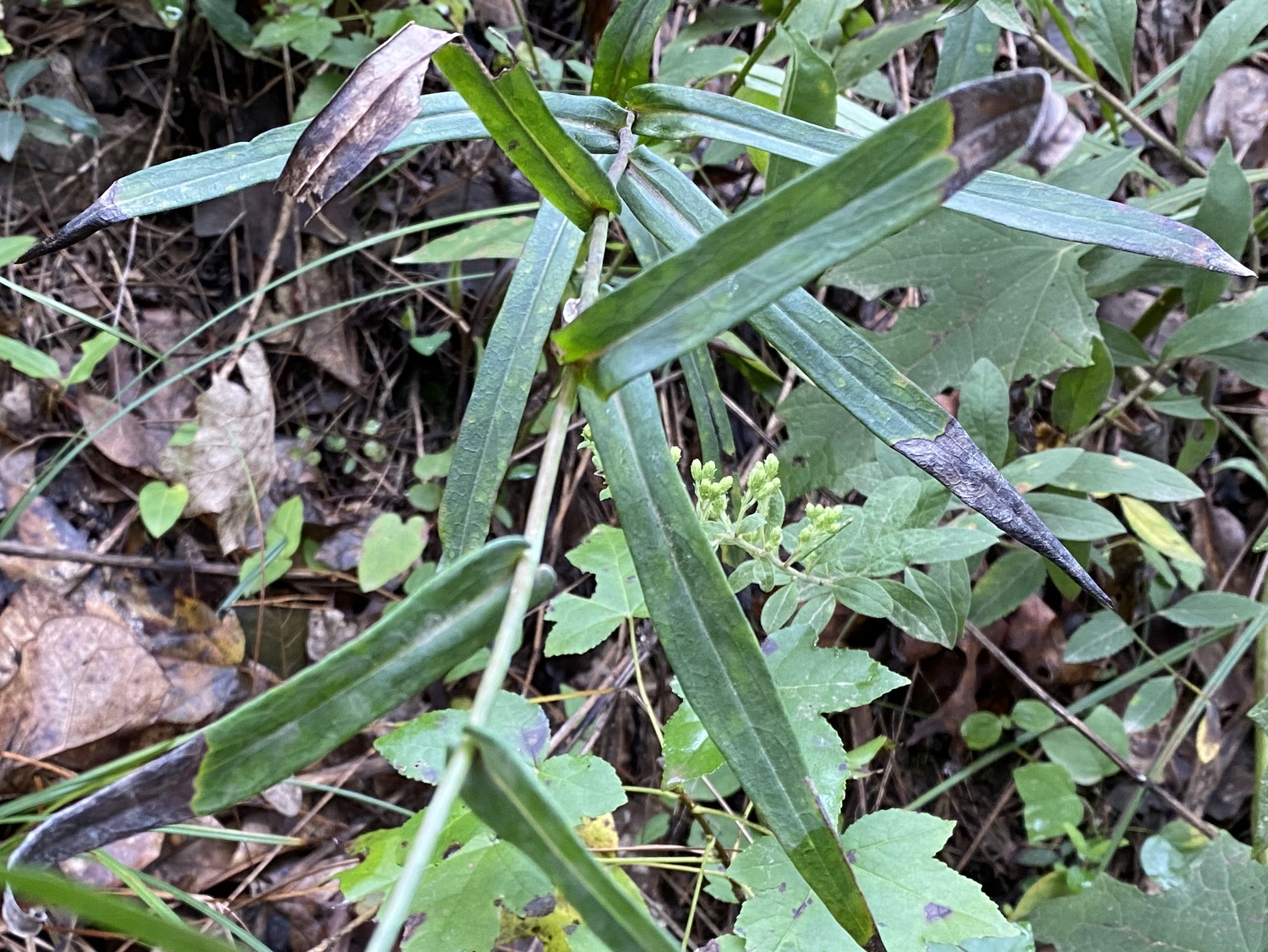
Blue Sage (Salvia azurea, also called Azure Sage). These small blue tubular flowers are arranged in a series at the ends of the stem. The lower lip of the flower has two white stripes separated by a thin blue line. The opposite leaves are elongated elliptical, with very short stems. The stem is reddish brown and four-angled in the lower part, green in the upper part. The plant is about 3' tall and is uncommon on Currahee.
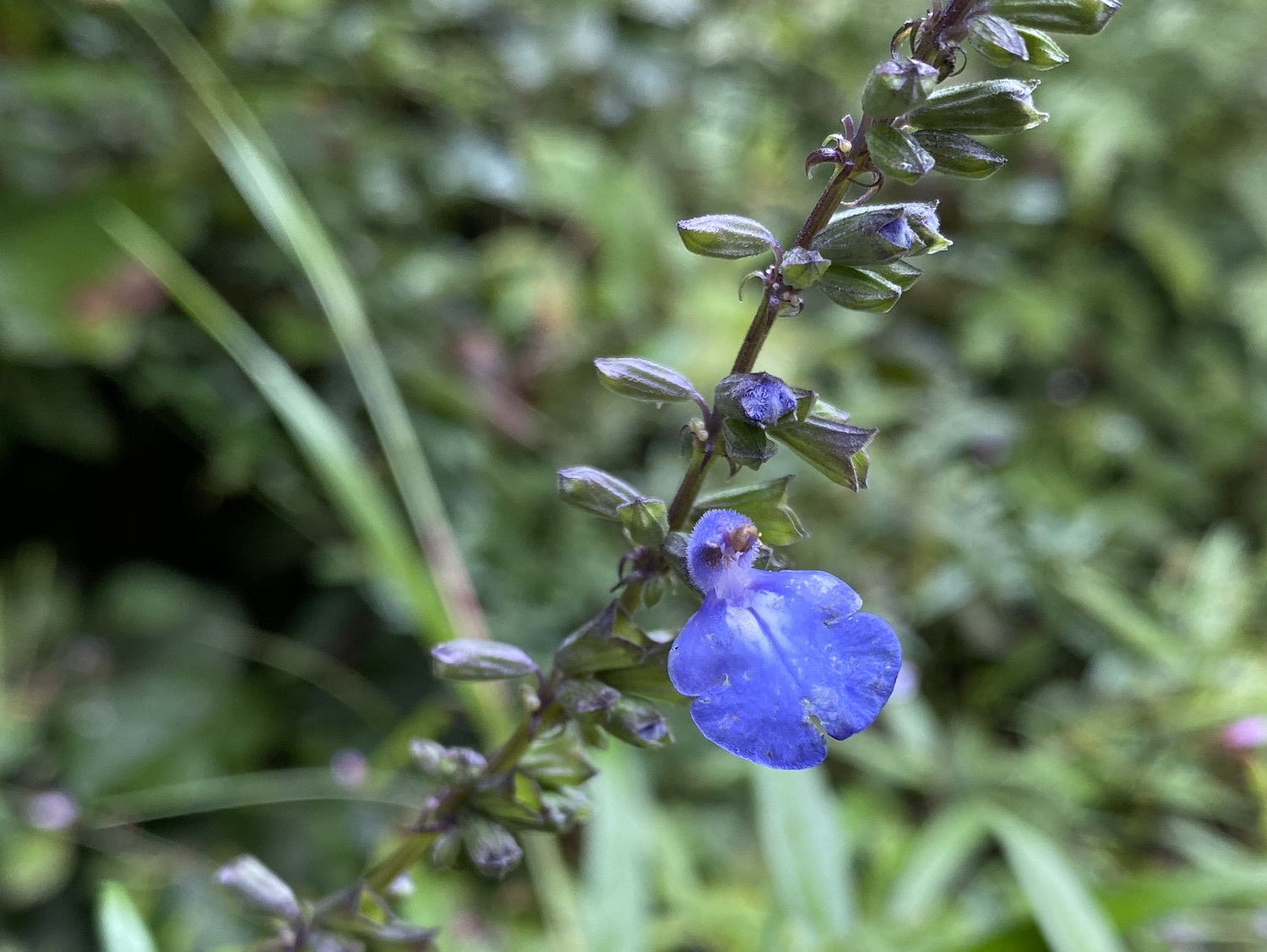
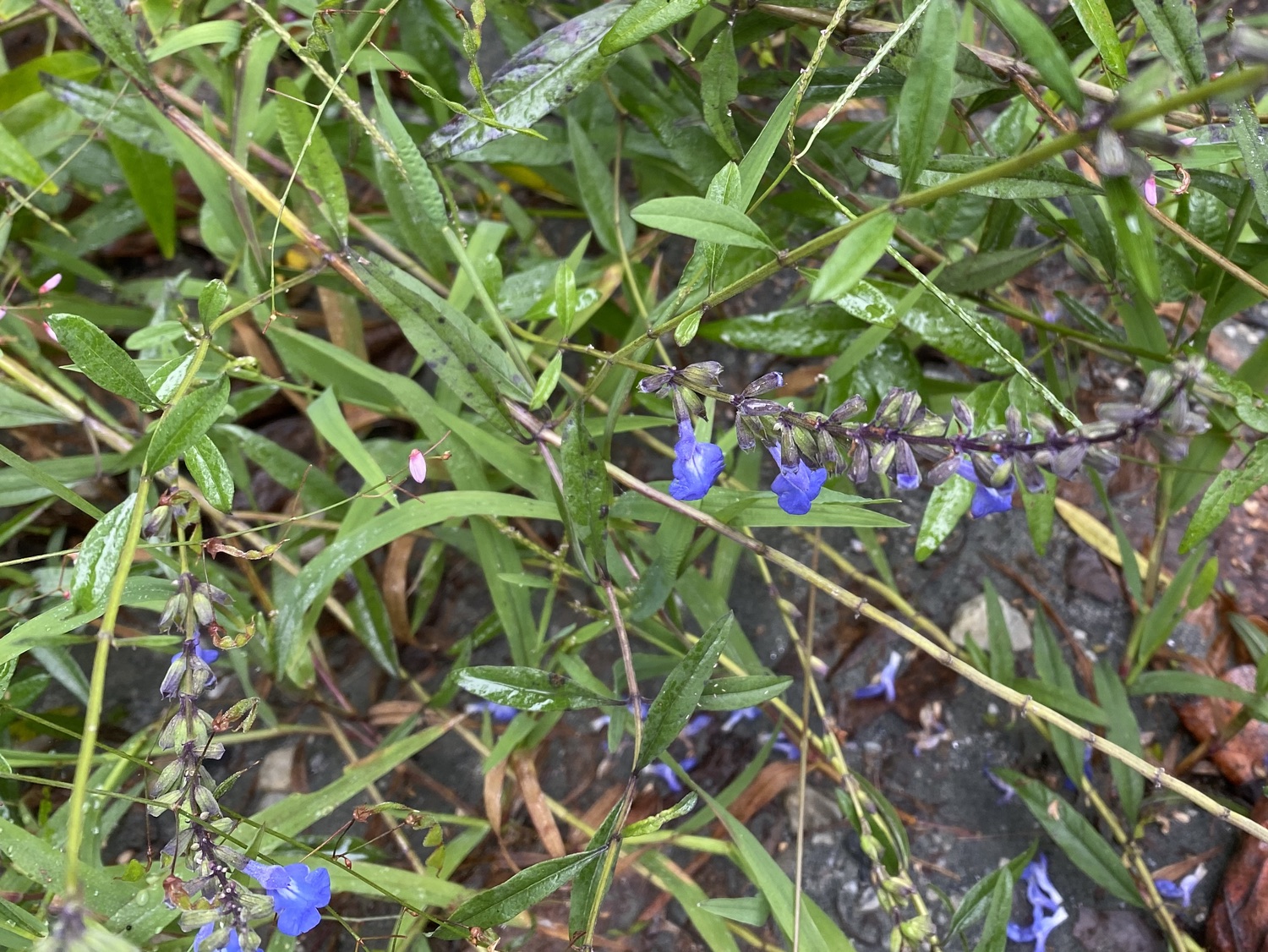
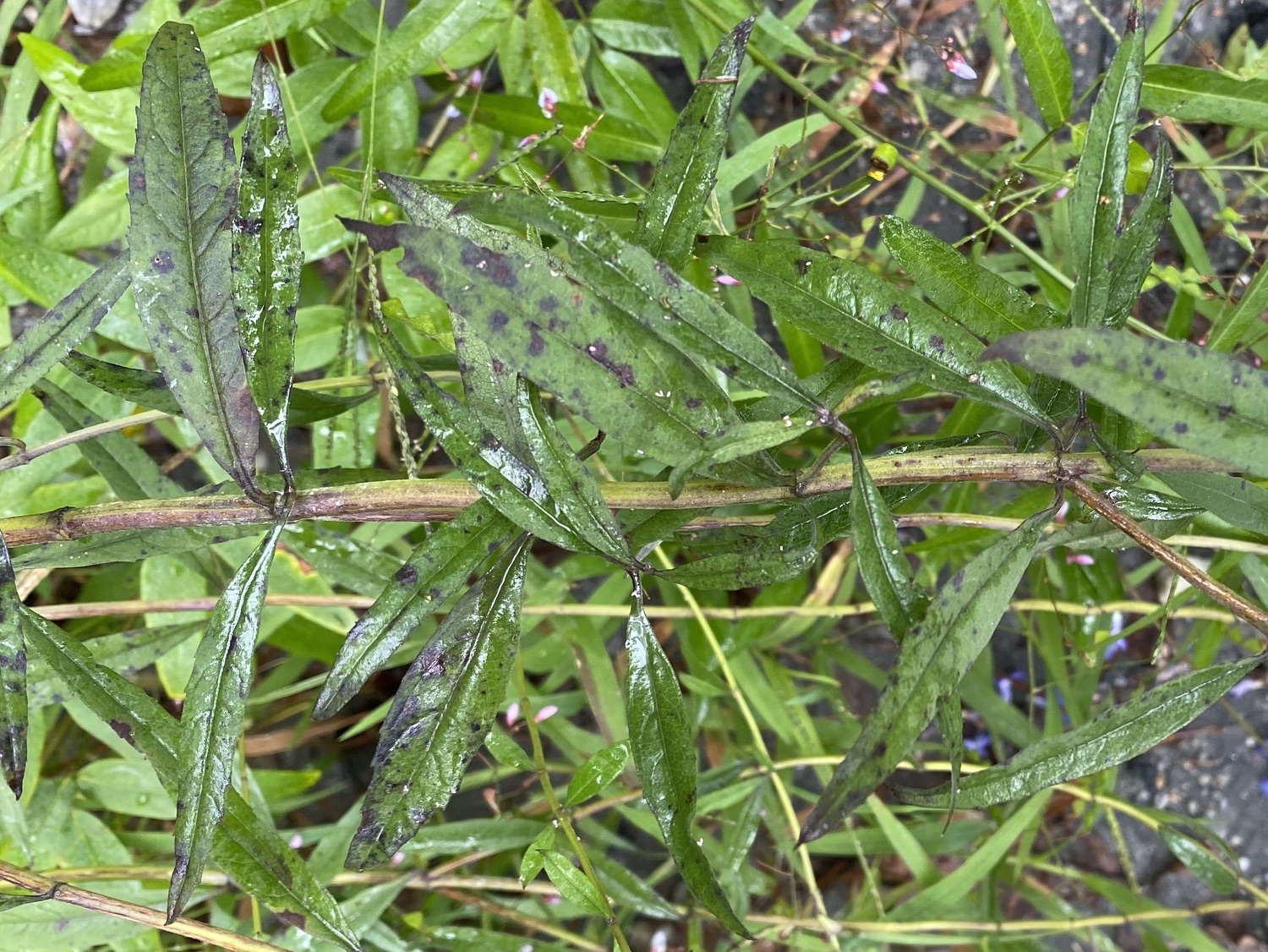
Downy Lobelia (Lobelia puberula). The flowers are all borne off a single spike at the end of the plant. Each purple flower is a tube consisting of five lobes. The lower three lobes are wide, deeply divided, with a prominent midvein and white patches at their base. The upper two lobes are narrow and widely flaring. The stem is green and covered in short hairs. The calyx is divided into 5 spikelike points that are about half the length of the flower. The leaves are essentially stalkless, dark green, roughly oval, with serrated edges; they are about 7–8 cm long near the base, shortening to about 1 cm near the top of the plant, just before the clusters of flowers. The plant is 3–4' tall, and consists of a single stem, and I saw it close by the Blue Sage. It is uncommon on Currahee.

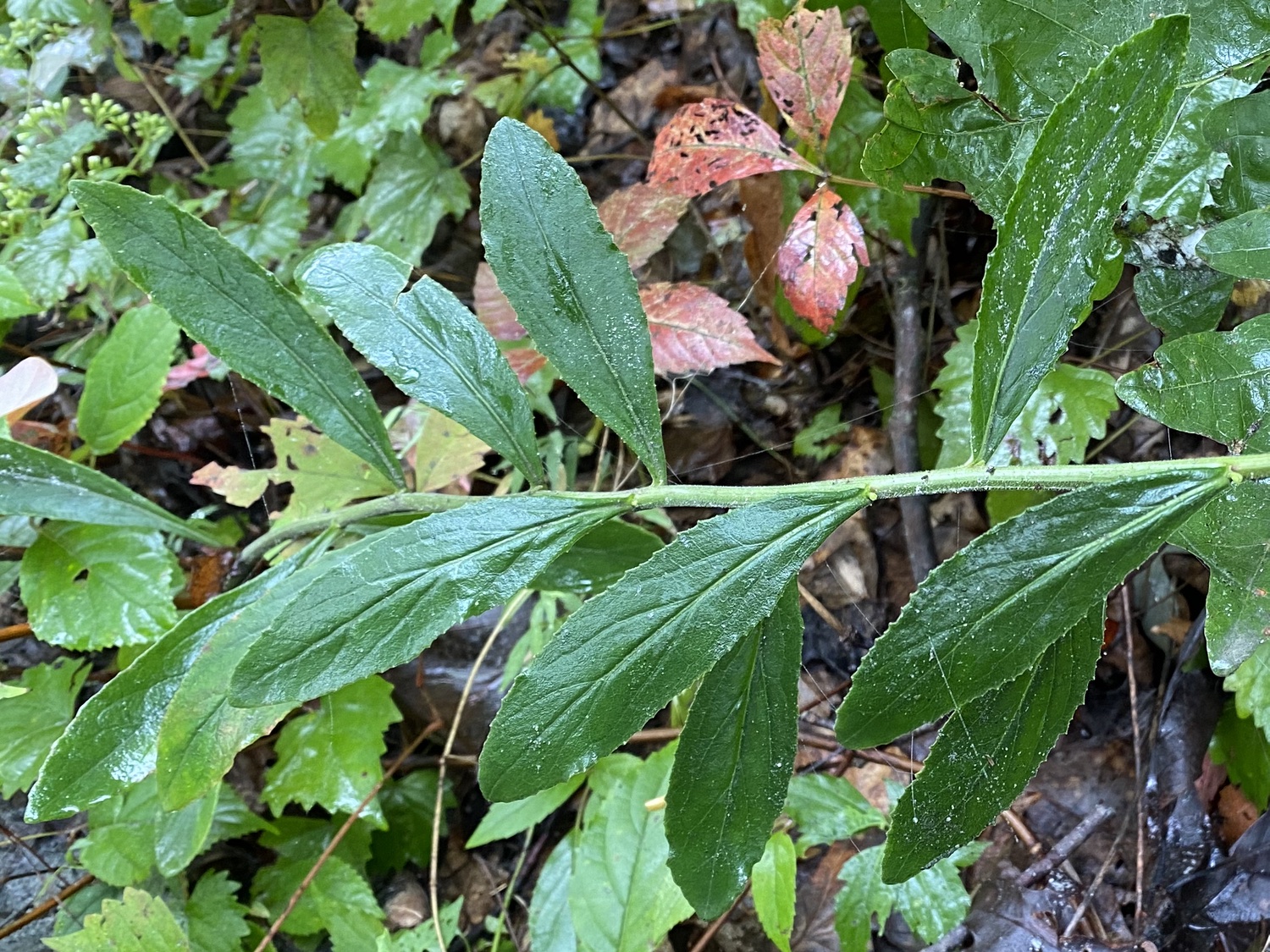
Appalachian Blazing-Star (Liatris squarrulosa). The long style branches extending from the flowers mark this as one of the blazing-stars. The lavender flowers are deep pink in places, and the base is formed by 4–5 series of overlapping and back-curved green bracts, edged in purple (more obvious closer to the flower). The pale green stem has fine hairs and narrow alternate lanceolate leaves.
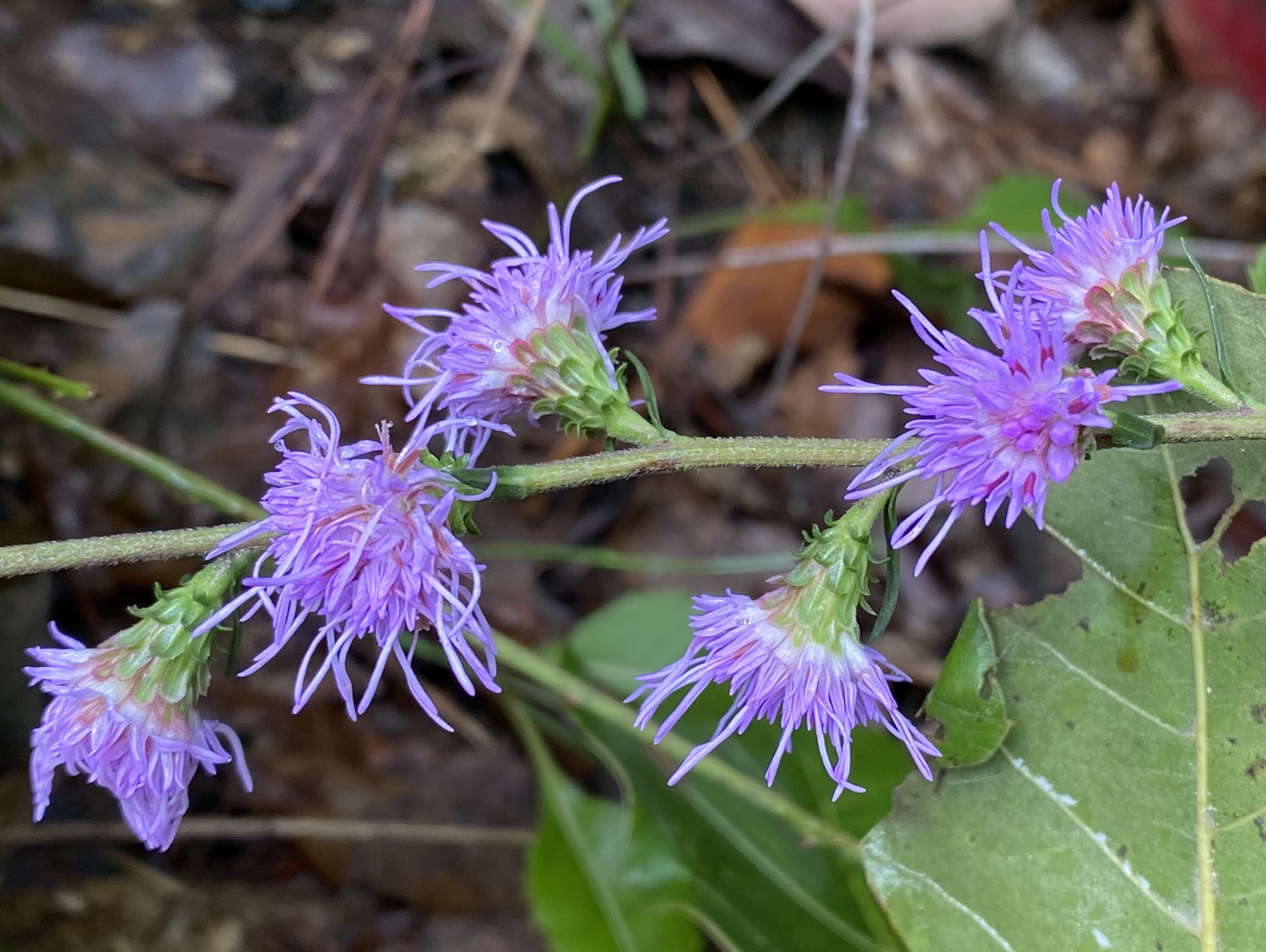
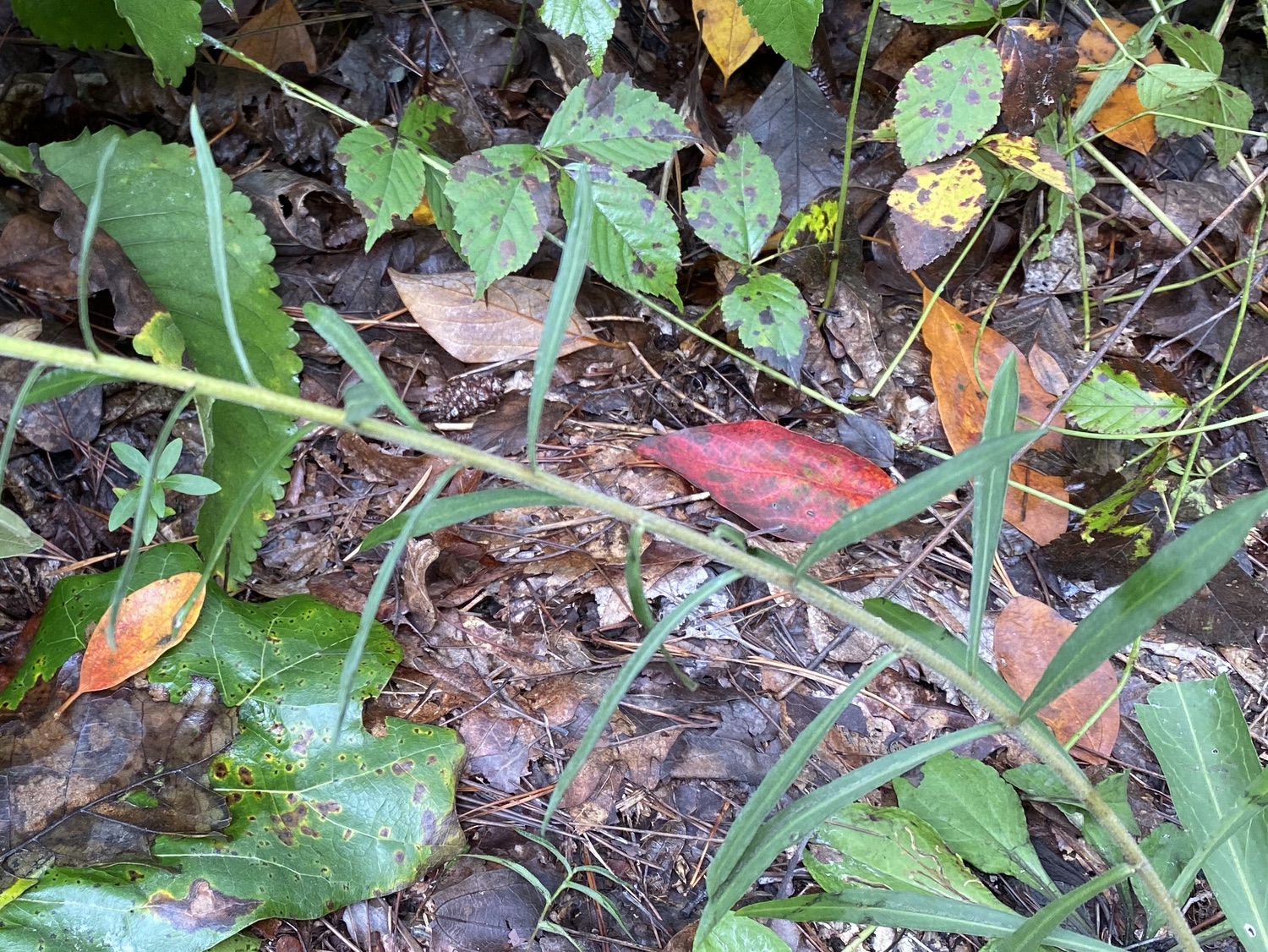
Common Dayflower (Commelina communis). This dayflower forms spreading mats with green to reddish-brown stems, with short (1–3 cm) lanceolate leaves that wrap around the stem. The flower has two large blue petals, with a smaller white petal below. The stamens are long and white, tipped with yellow anthers. I saw only one patch of this on Currahee, at the mountain top, adjacent to one of the radio towers.
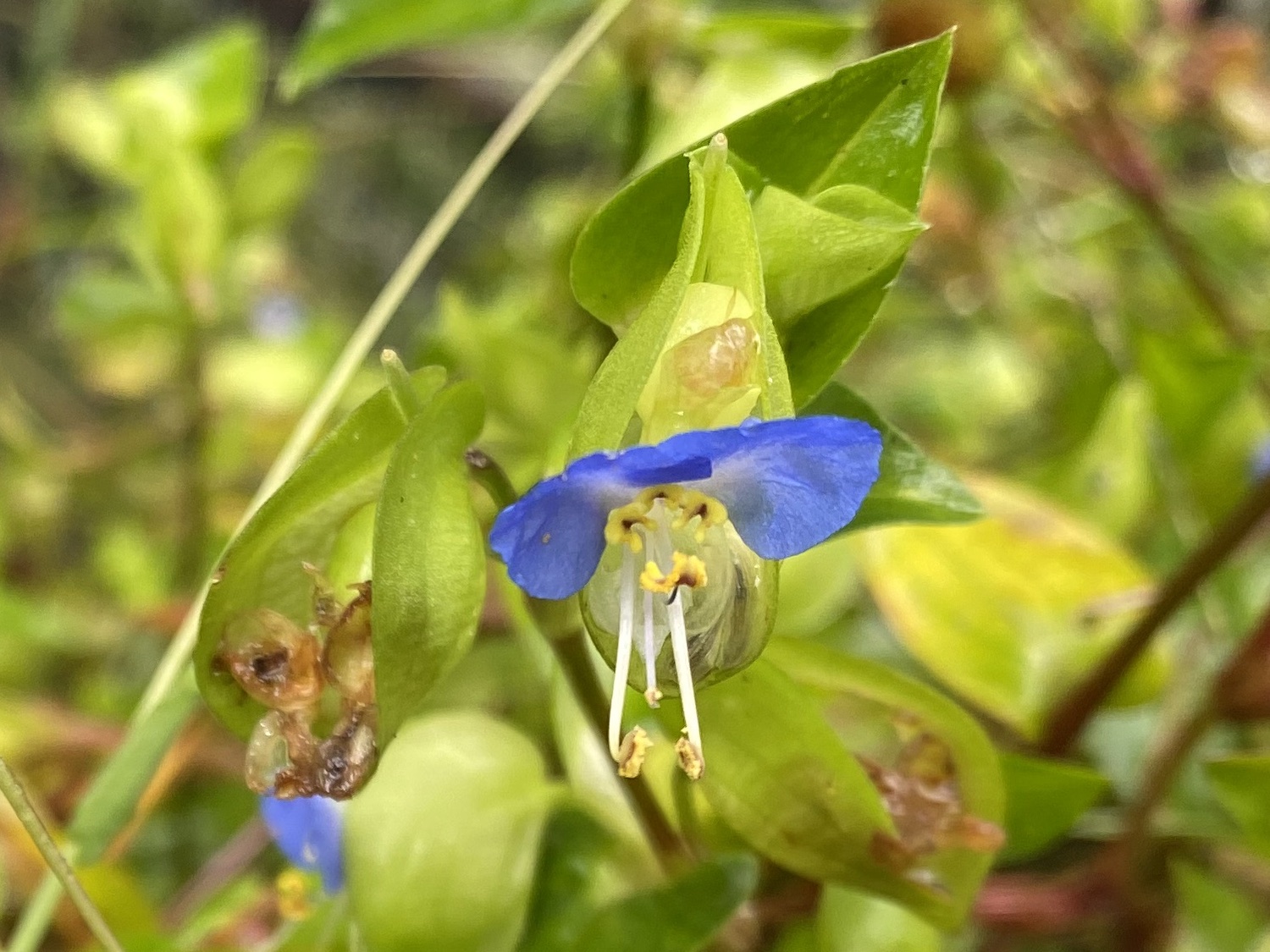
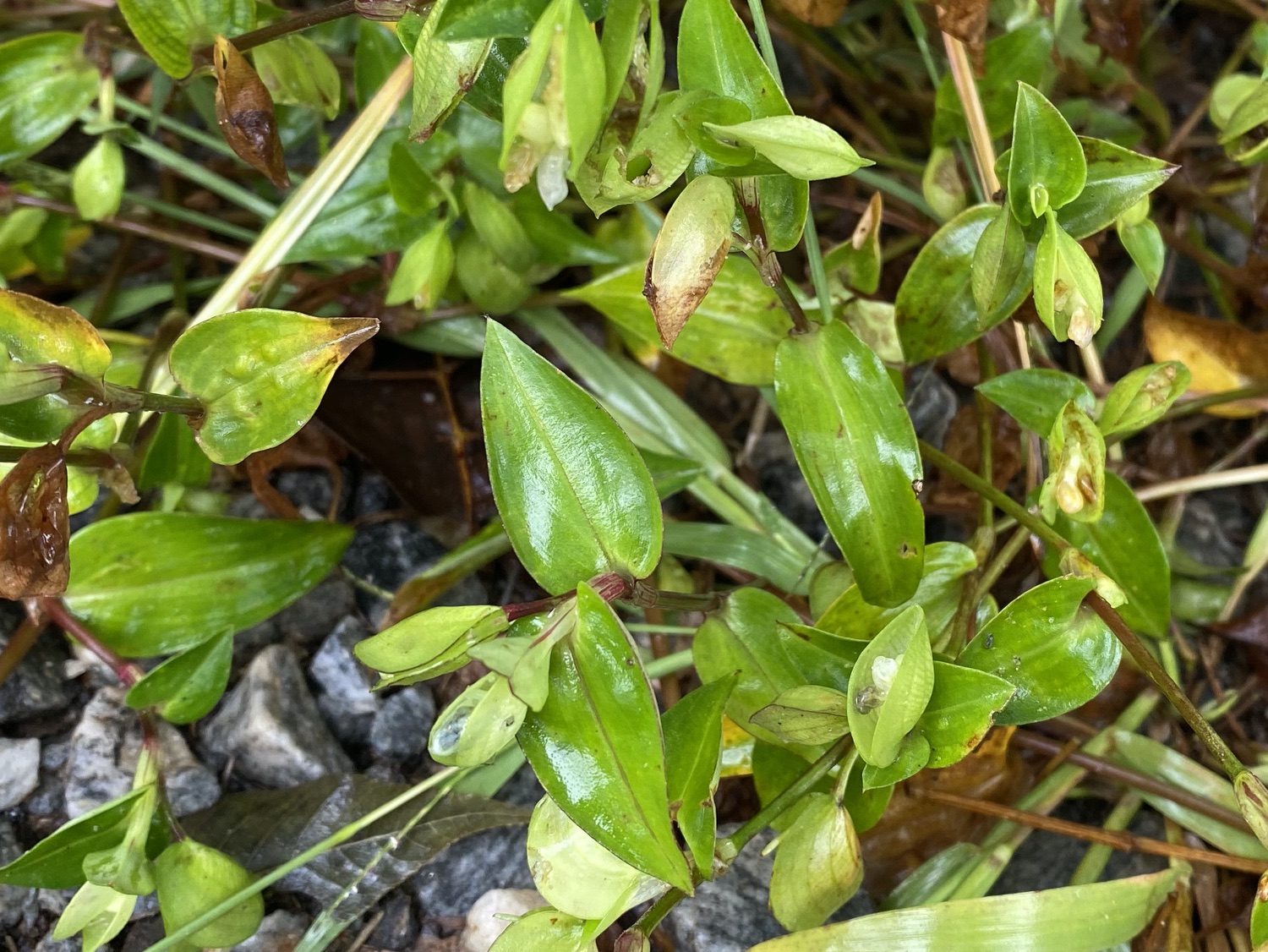
Pink flowers
Obedient Plant (Physostegia virginiana). These grow as a single 4-angled stem, with opposite elongated toothed leaves, which are longer at the base than at the top (8 cm vs. 1–2 cm). The stems end in a series of tubular translucent pink flowers with a disinct hooded upper petal, and a three-lobed lower petal with purple spots. The plant is about 2' tall. In certain light, they can appear almost pink–purple.
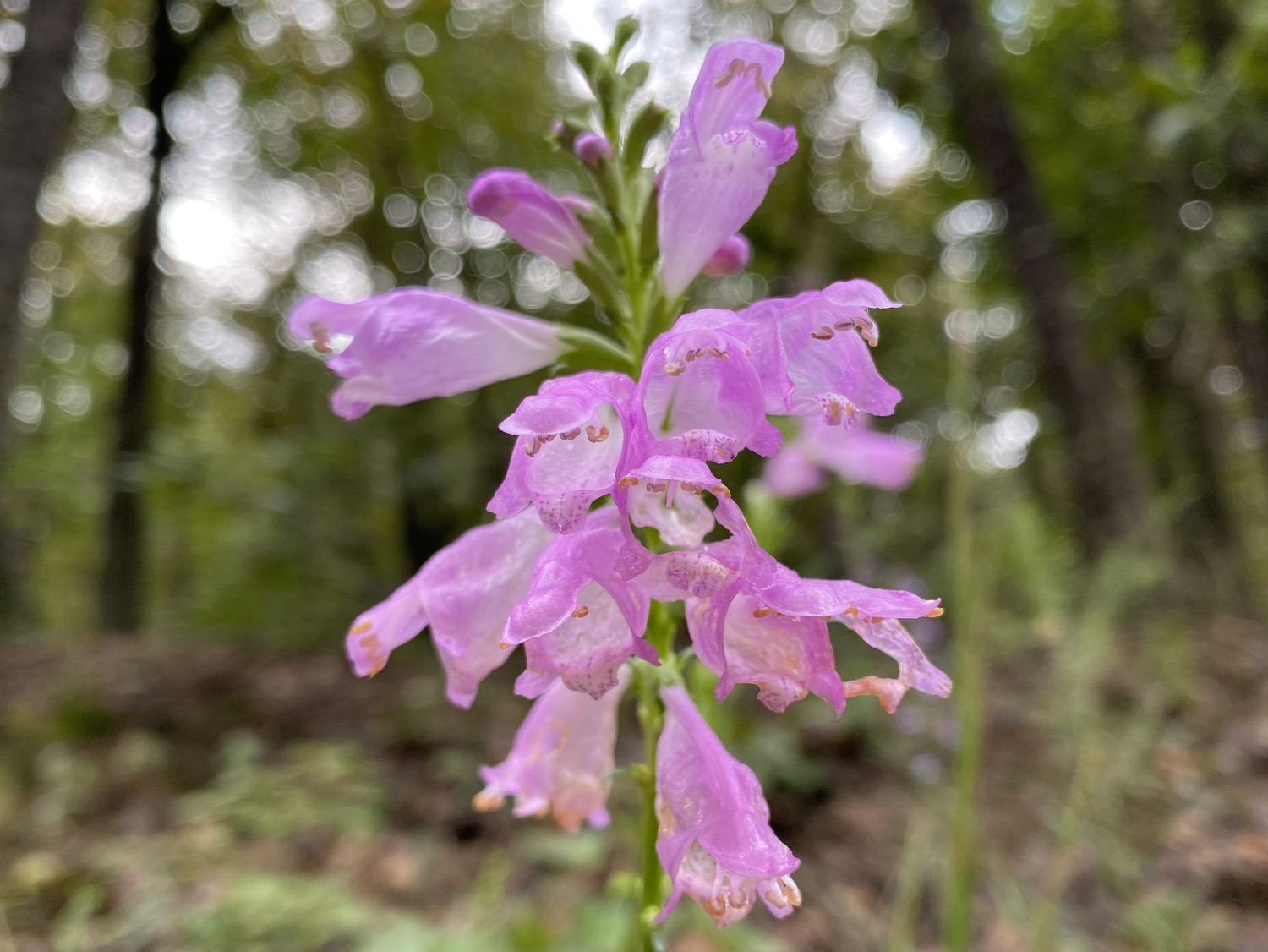
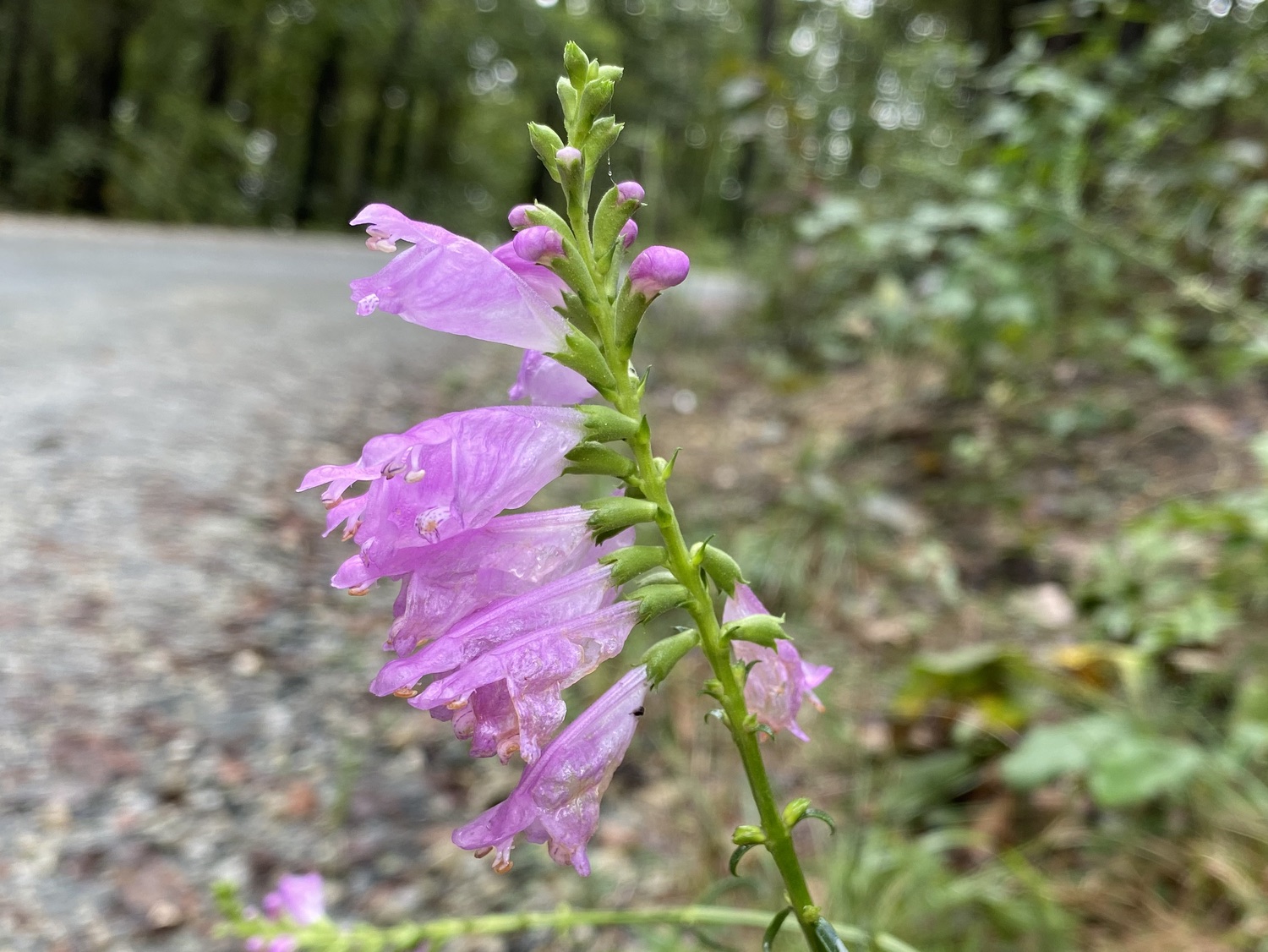
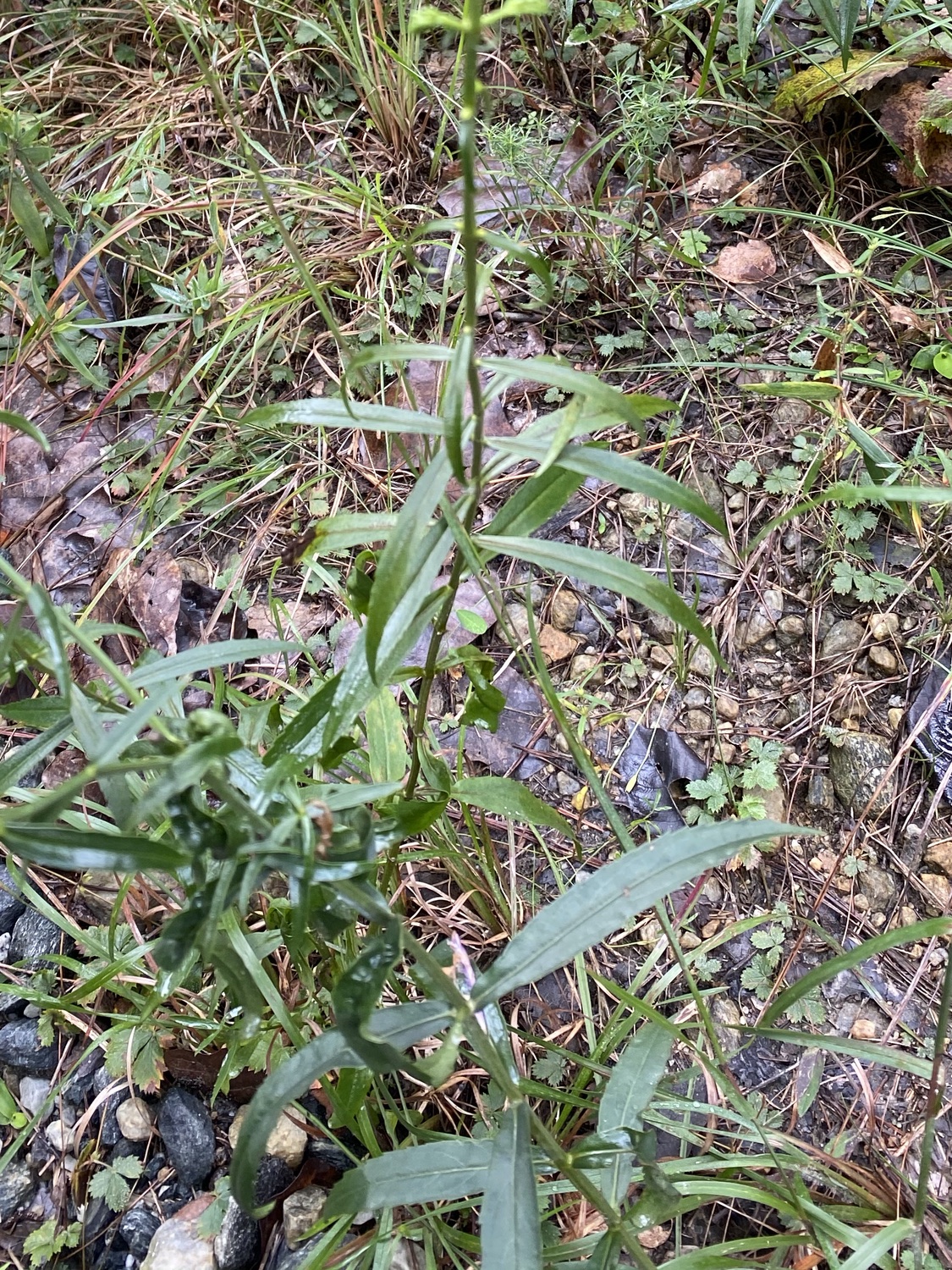
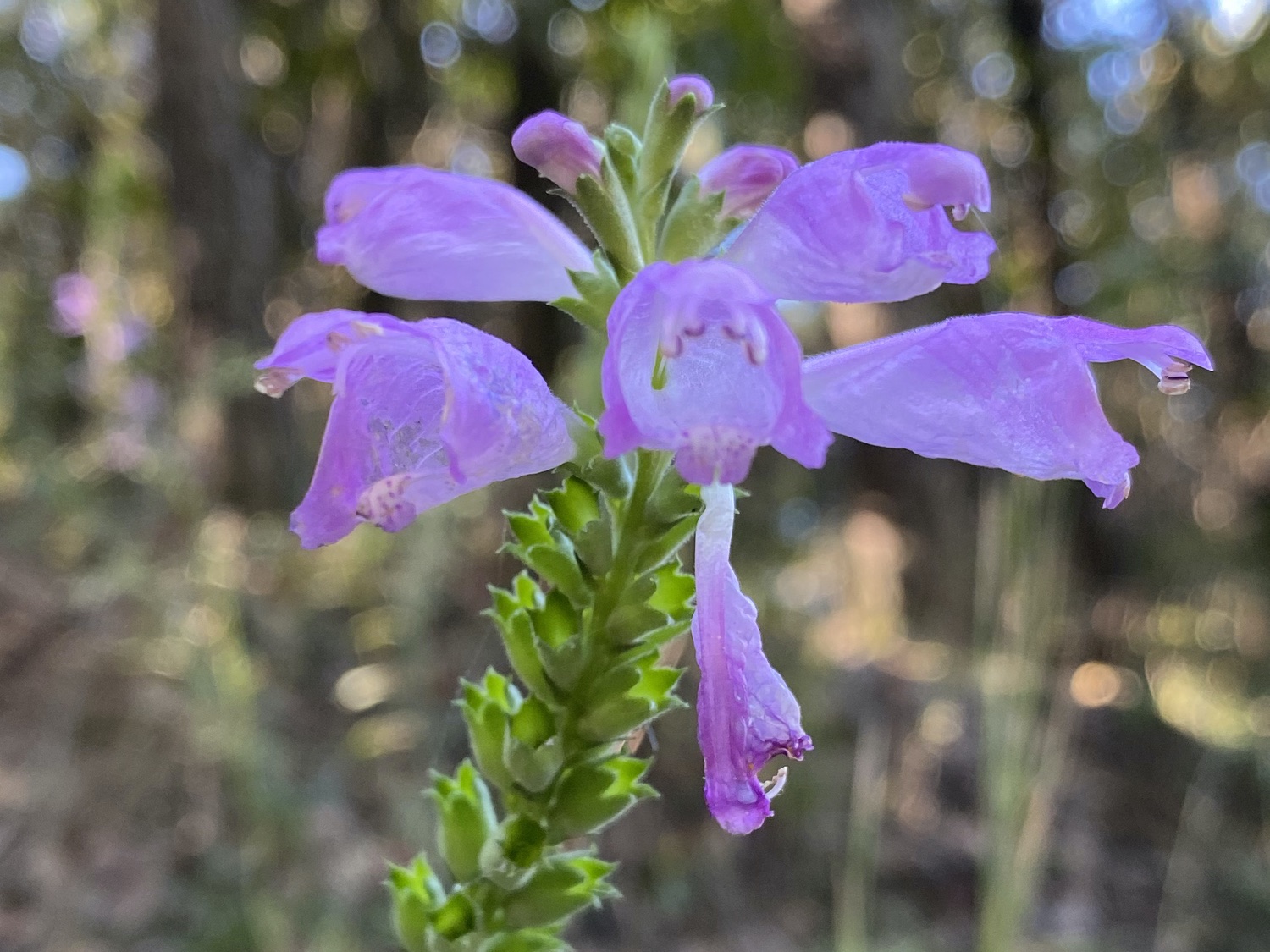
Panicled Tick-Trefoil (Desmodium paniculatum, also called Beggar-ticks). The leaves of three and the flowers with a banner petal immediately identify this as being in the bean family. The leaflets are elliptical to pointed and 2–4 cm long; the two side leaflets have a short petiole (stem) than the terminal leaflet. The flowers have a prominent lavender banner petal, with a rose red patch at the base. Underneath is a smaller bluish petal, with a white stigma inside. Just visible in the closeup is one of the two green spots at the base of the banner petal. The flowers are tiny, less than 1 cm, and distributed all over the plant. All of the flowers seemed to be oriented so that they are facing downwards. The flattened seed pods (in the upper right of the lower photograph) are pale green, have three or four segments, and are covered with short hairs that act like velcro. Panicled Tick-Trefoil is common on Currahee, and is typically up to 3' tall.
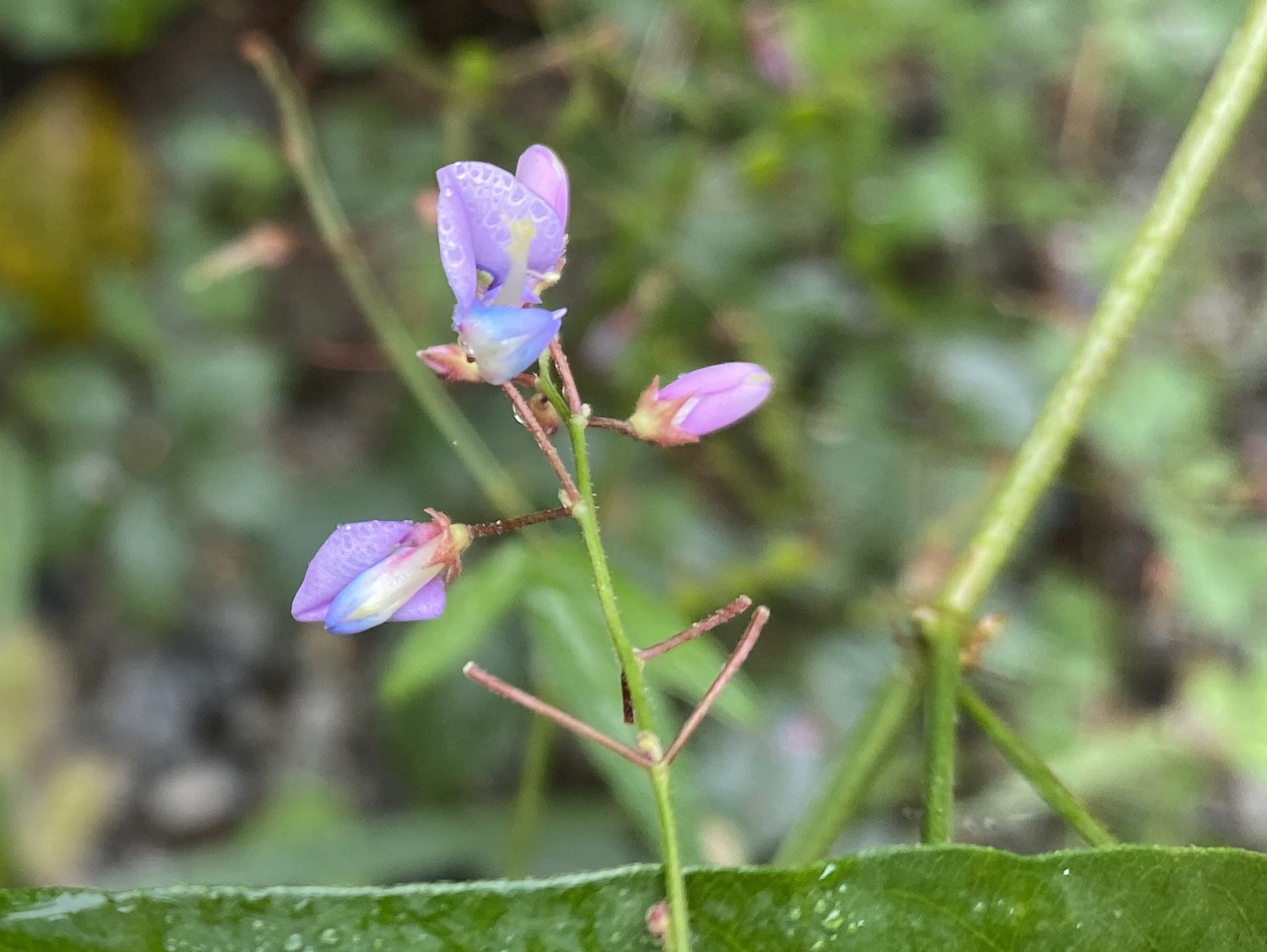

Slender-leaf False Foxglove (Agalinis tenuifolia). These low plants are only about 1' tall and consist of numerous branching and angled purplish-brown stems. On these are very narrow (1–2 mm) and long (2–3 cm) opposite leaves with a well-developed midvein. The not-yet-opened flowers look like ice-cream cones, with tapering green “cone” and a single serving of pink-white “ice cream”. The opened flower is tubular with five rounded lobes (3 below, 2 above). The inside of the throat is white (to very faintly yellow) with purple spots. A single long white to pink stamen projects from the throat. These are common in the clear-cut area at the base of Currahee, but not along the road in the forest.
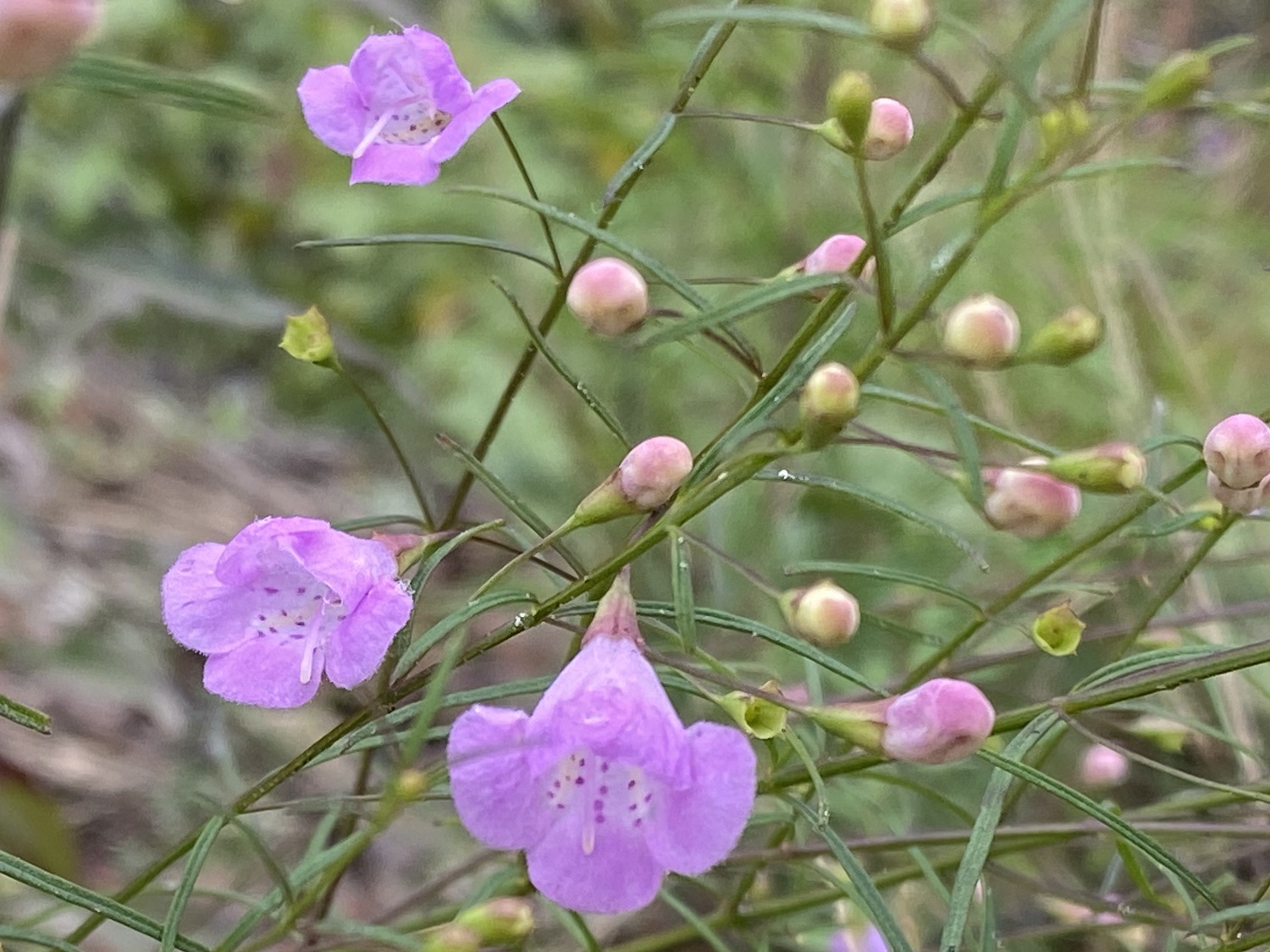
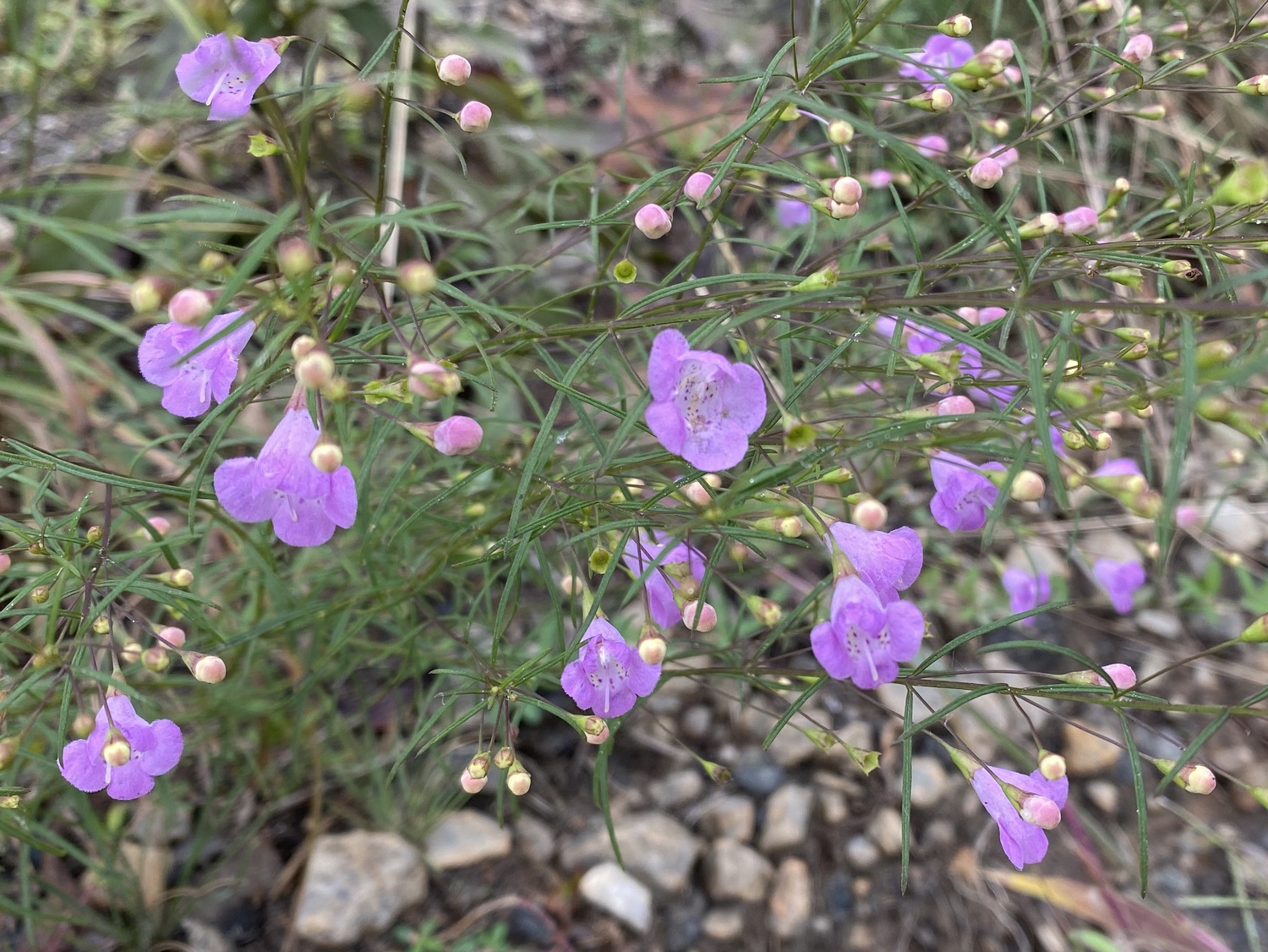
Hoary Mountain Mint (Pycanthemum incanum). I’ve seen these previously at the power-line cut in the UGA Botanical Gardens. The pale-pink and purple-spotted flowers occur in clusters at the ends of branches. The leaves are broad, opposite, and toothed. On Currahee, these are commonly 2–4' tall. The crushed leaves definitely smell like mint.
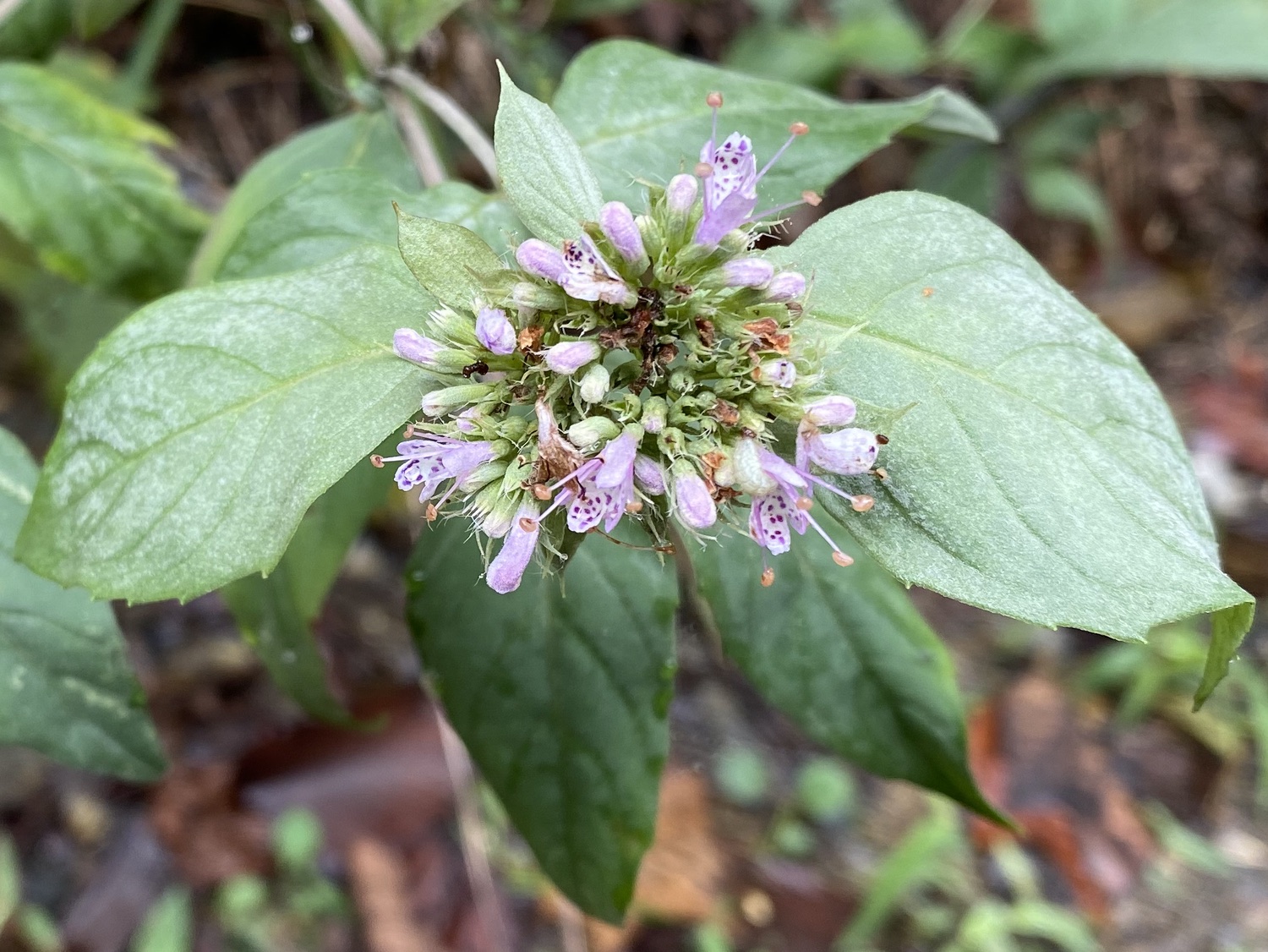
Longbristle Smartweed (Persicaria longiseta). These flowers look like a series of pink nubs held closely to the end of a stem; several of these arise near the end of a main stem, with the terminal spike seeming to have the most flowers. The leaves are alternate, elongate, with a drawn-out but not pointed tip, and a very short petiole (1–3 mm). Several long hairs arise where the petiole attaches to the main stem, giving the name to the plant. The main stem appears jointed, taking a bend at every leaf juncture. This was growing amongst the Bush Aster in the parking lot and a few places along the road. It is about 1' high. I found the closely related Pennsylvania Smartweed along our street a few weeks ago.
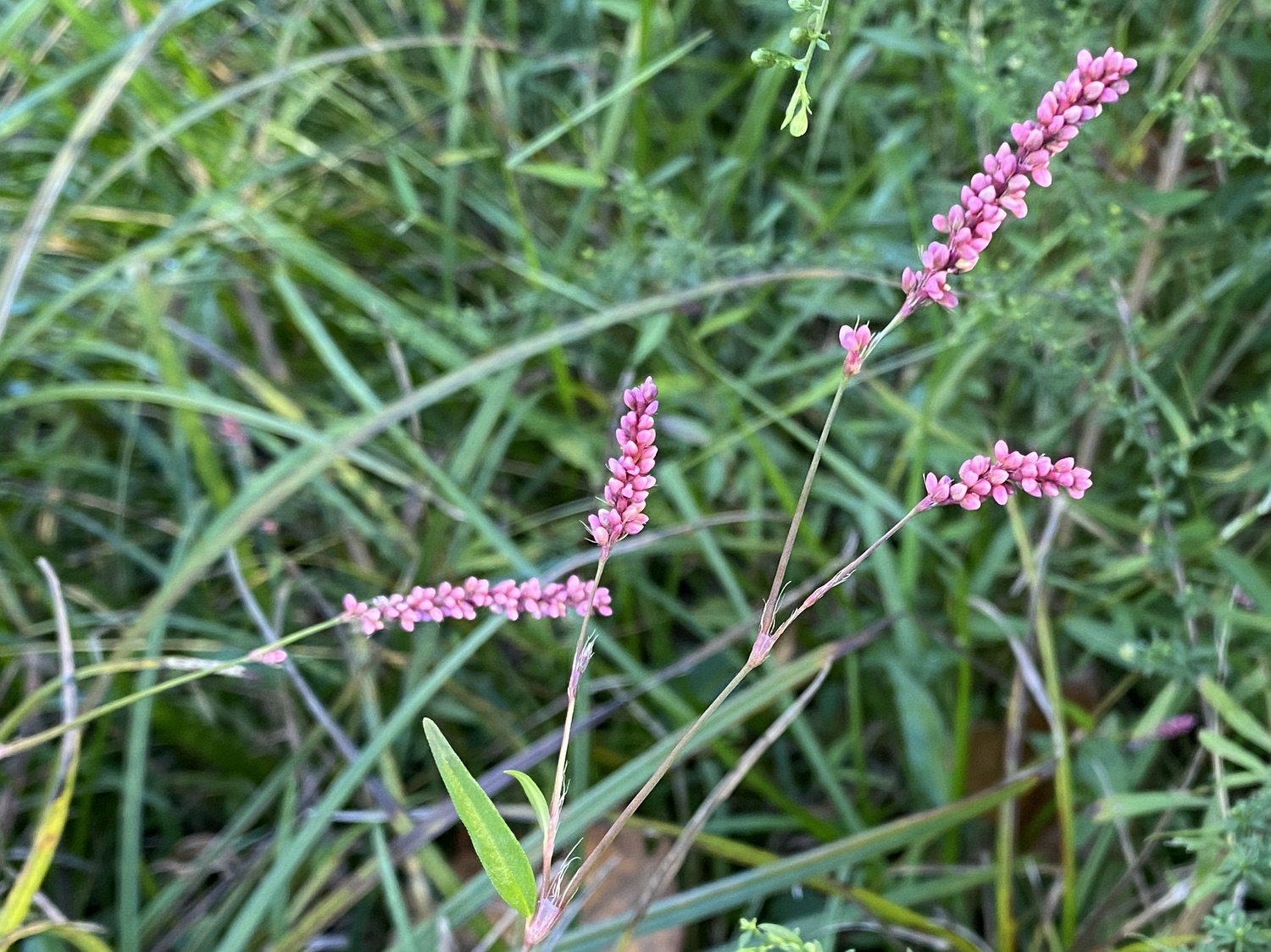
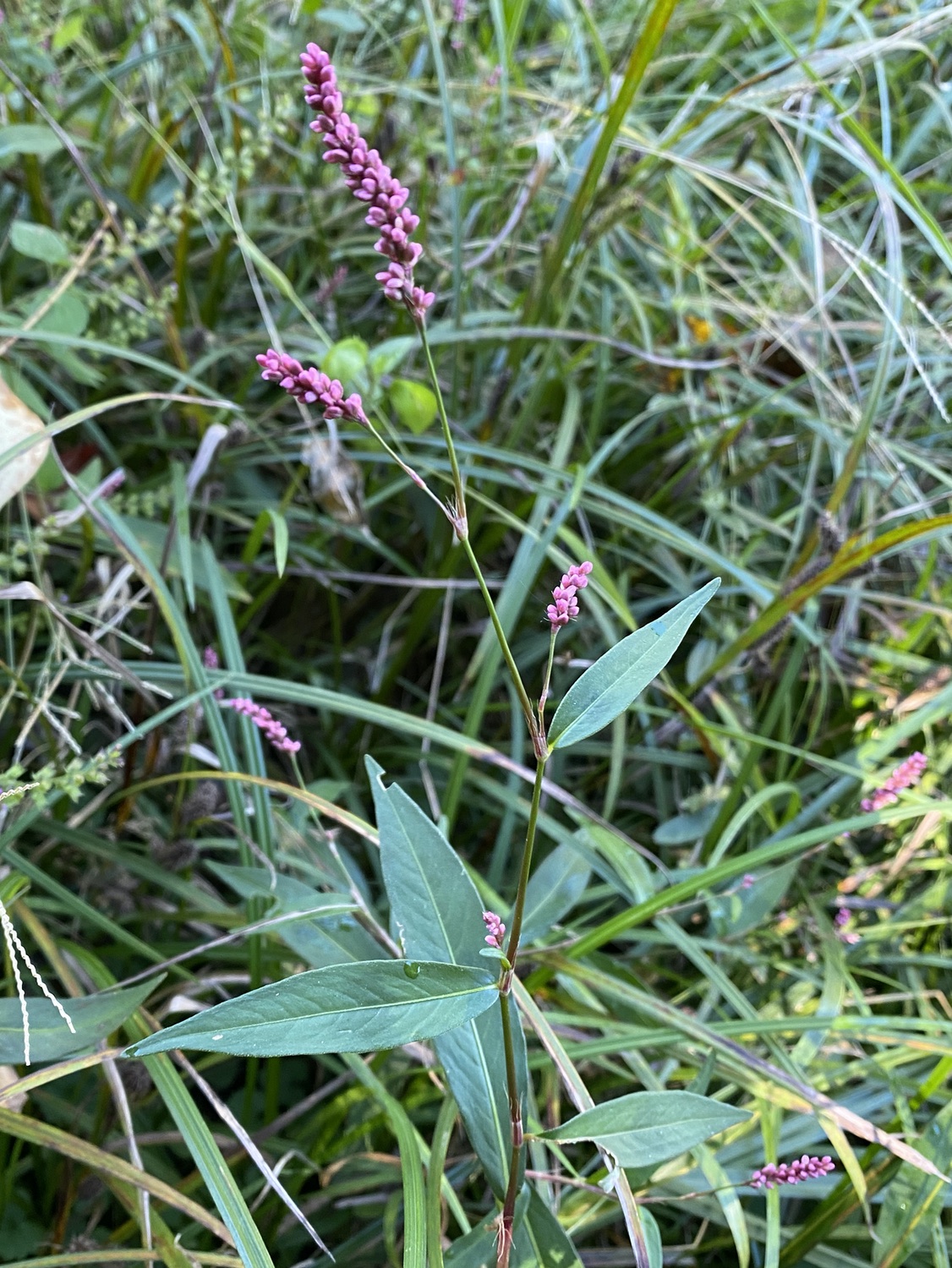
Seeds
Common Sowthistle (Sonchus oleraceus). Although these are well past the flowering stage and are dispersing their seeds, they are so widespread in the clearcut on the Currahee that they must be mentioned. The seed heads consist of tiny brown seeds attached to a cluster of fine white hairs. As the wind blows, these are released from the seed head and float through the air. The seed capsules have a green base and a grooved brownish top, which splits and folds backwards as the seed head opens. A single main stem begins to branch repeatedly about halfway up the plant. The stems have parallel ridges and a white pith inside. The leaves are elongated and coarsely double-toothed. A set of smaller leaves is attached at the axils of the larger leaves. The larger leaves are limited to the lower half of the plant, with the upper half having only a few narrow coarsely toothed leaves. The plant is 4–5' tall.
It took me awhile to identify this, as the field guides don’t show the seed heads. It looked similar to a thistle, but the calyx did not have the overlapping bracts of a thistle. The calyx reminded me more of a dandelion, although these plants are far taller than a dandelion ever gets. Even so, that was a good clue, because Sonchus is in the Aster family, just like dandelions, and the flowers on the two are similar. Field guides often show much more deeply lobed leaves than this, but online photos show that the depth of the lobes can be much less, as in these at Currahee. Common Sowthistle does well in disturbed areas, and that’s certainly what the clear cut on Currahee is! I’ll have to look for the flowers next summer.

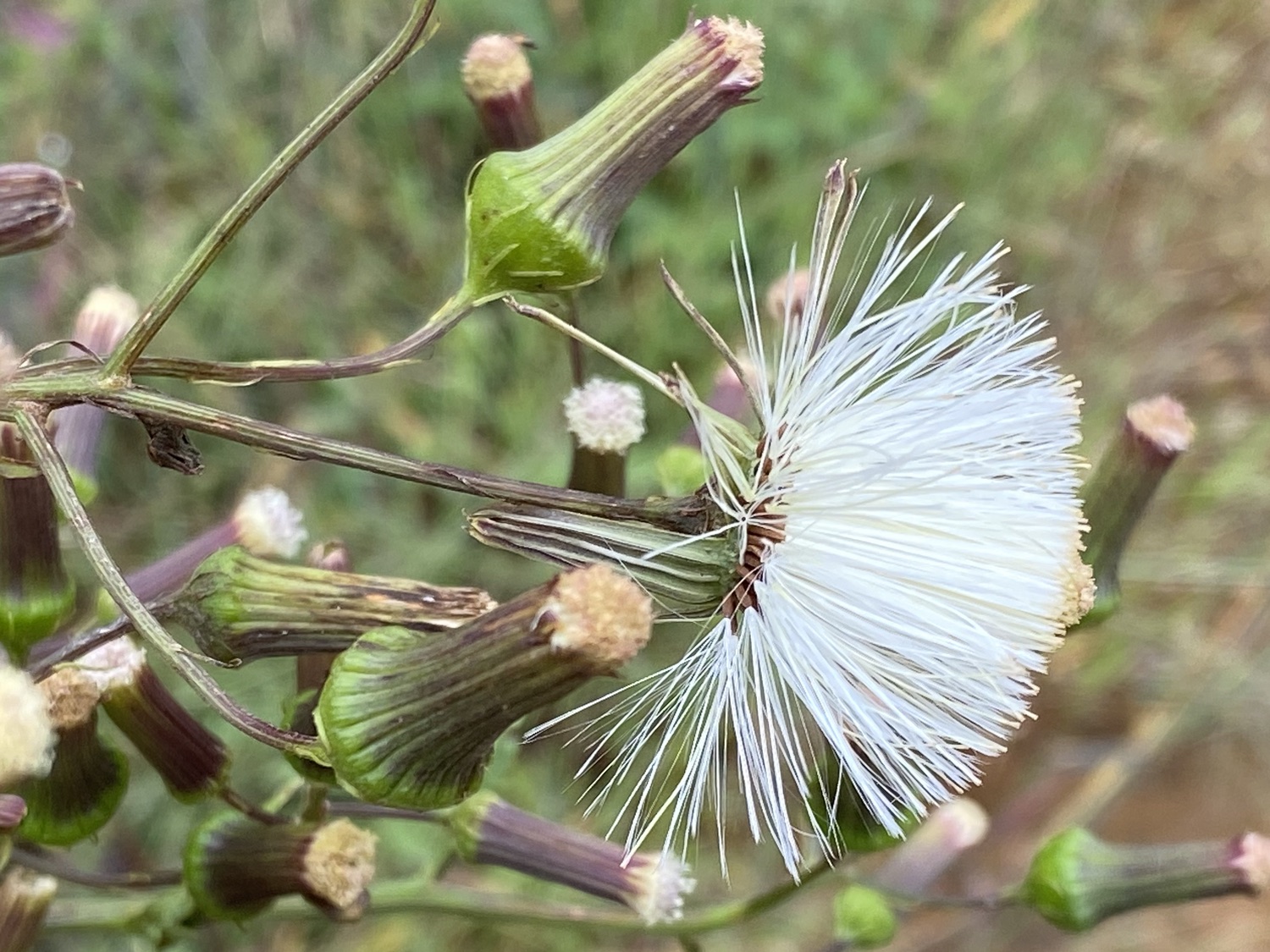


References
Chafin, L.G. 2016. Field Guide to the Wildflowers of Georgia and Surrounding States. The University of Georgia Press, Athens, Georgia.
Duncan, W.H., and M.B. Duncan. 1999. Wildflowers of the Eastern United States. The University of Georgia Press, Athens, Georgia.
Miller, J.H., E.B. Chambliss, N.J. Loewenstein. 2015. A Field Guide for the Identification of Invasive Plants in Southern Forests. USDA Forest Service, Southern Research Station, General Technical Report SRS-119, 126 p.
Native & Naturalized Plants of the Carolinas & Georgia. This is a great searchable website that shows many species that field guides do not include, and it has more photographs annotated with key features, more than most field guides.